
Analyst
Craig Oram, Mark Milovic, Jen Wichmann and Alexandra Levy recently sat down in front of the camera to discuss how various teams at LaSalle – in particular Research and Strategy – work in tandem with the US debt investment team to identify prime sectors and locations for investment.
LaSalle’s Research and Strategy team plays a crucial role in our underwriting process. They provide insights on market dynamics, macroeconomic trends, and demographic shifts that can impact property operations and investment performance. By combining their top-down analysis with our decades of lending experience across the US, we can identify attractive opportunities that balance risk with reward. This comprehensive approach enables us to make more informed lending decisions, helping us to mitigate potential risks and work to enhance returns for our investors.
Learn more below.
Want to read more?
Real estate debt has always been a valuable component of any portfolio; however, it is emerging as a viable solution to a wide array of investor concerns today. It’s a strategy that offers a range of benefits with attractive risk-adjusted returns across market cycles.
Read our six reasons why investors should consider adding it to their portfolios, and learn more about our capabilities in Europe and the United States below.
1. Attractive risk-adjusted returns: In today’s environment, the combination of elevated interest rates and attractive credit spreads mean that real estate debt offers compelling returns relative to other fixed income alternatives. The potential for achieving these higher yields, while maintaining a relatively conservative risk profile, is appealing to institutional investors looking to mitigate risk.
Real estate debt can offer different opportunities through the market cycle, with the ability to adjust advance rates during market downturns to minimize risk, while benefiting from cyclical recoveries.
2. Stable and predictable income: An allocation to real estate debt may allow investors to enhance their portfolio income returns. The coupon-like nature of interest payments from borrowers can provide consistent and stable cash flows for investors, with a significant portion of the total return being achieved through income returns.

3. Downside protection and capital preservation: Real estate debt offers the ability for investors to gain exposure to the same underlying real estate, but via a protected position in the capital structure, offering an often-significant equity cushion to buffer against potential value fluctuations.
Careful structuring can further enhance downside protections; these investments are typically collateralized by the physical underlying property, providing security that differs to some other forms of fixed income investments. In a default event, active asset management is critical, and managers who have the expertise to step in and manage the underlying asset can further protect against potential losses and in some instances create upside value.
Senior or unlevered whole loan lenders sit in the last-loss position, allowing investors to consider more actively managed business plans than they might be comfortable investing in via an equity commitment.
4. Diversification benefits: Real estate debt provides exposure to one of the largest segments of the real estate market, typically with lower volatility than real estate equity. And adding real estate debt to an institutional portfolio can enhance diversification, as it often has low correlation with traditional asset classes like stocks and bonds, which can help to improve overall risk-adjusted returns.
5. Regulatory efficiency and opportunity: For insurance companies, real estate debt is treated favorably under Solvency II and other similar regimes, making it a capital-efficient way to deploy assets and capture attractive relative returns. Additionally, enhanced regulation has led to retrenchment by traditional bank lenders, creating opportunities for investors working with non-bank alternative lenders, such as institutionally managed debt funds.
6. Inflation hedge: As inflation rises, so too do the interest rates central banks often use to combat it. Real estate debt investments, particularly those with floating-rate loans linked to central bank rates, can therefore offer some protection against inflation.
Want to read more?
Important notice and disclaimer
This publication does not constitute an offer to sell, or the solicitation of an offer to buy, any securities or any interests in any investment products advised by, or the advisory services of, LaSalle Investment Management (together with its global investment advisory affiliates, “LaSalle”). This publication has been prepared without regard to the specific investment objectives, financial situation or particular needs of recipients and under no circumstances is this publication on its own intended to be, or serve as, investment advice. The discussions set forth in this publication are intended for informational purposes only, do not constitute investment advice and are subject to correction, completion and amendment without notice. Further, nothing herein constitutes legal or tax advice. Prior to making any investment, an investor should consult with its own investment, accounting, legal and tax advisers to independently evaluate the risks, consequences and suitability of that investment. LaSalle has taken reasonable care to ensure that the information contained in this publication is accurate and has been obtained from reliable sources. Any opinions, forecasts, projections or other statements that are made in this publication are forward-looking statements. Although LaSalle believes that the expectations reflected in such forward-looking statements are reasonable, they do involve a number of assumptions, risks and uncertainties. Accordingly, LaSalle does not make any express or implied representation or warranty and no responsibility is accepted with respect to the adequacy, accuracy, completeness or reasonableness of the facts, opinions, estimates, forecasts, or other information set out in this publication or any further information, written or oral notice, or other document at any time supplied in connection with this publication. LaSalle does not undertake and is under no obligation to update or keep current the information or content contained in this publication for future events. LaSalle does not accept any liability in negligence or otherwise for any loss or damage suffered by any party resulting from reliance on this publication and nothing contained herein shall be relied upon as a promise or guarantee regarding any future events or performance. By accepting receipt of this publication, the recipient agrees not to distribute, offer or sell this publication or copies of it and agrees not to make use of the publication other than for its own general information purposes.
Copyright © LaSalle Investment Management 2025. All rights reserved. No part of this document may be reproduced by any means, whether graphically, electronically, mechanically or otherwise howsoever, including without limitation photocopying and recording on magnetic tape, or included in any information store and/or retrieval system without prior written permission of LaSalle Investment Management.
A reader waking up from a quarter-long slumber on April 1, 2025 would be forgiven for confusing the headlines for an April Fools’ Day prank. They would scan the news and see stories about:
• large tariffs alternately announced, rescinded, delayed and reintroduced at a breakneck pace (see LaSalle Macro Quarterly, or LMQ, p. 4);
• US equities in correction territory as ex-US markets, including even China’s, outperform (LMQ p. 25);
• increasing calls that the risk of a US recession is rising (LMQ p. 20); and
• substantial upward revisions in forecasts of long-term European GDP growth (LMQ p. 21).
Each of these is at least partly (and in some cases completely) contrary to expectations from the beginning of this year. But the quick reversal in the economic narrative is no April 1st joke. The post-election consensus of a supercharged US economy pulling ahead of the rest of the world has clearly been challenged, if not upended.
In this period of elevated policy uncertainty, real estate investors should focus on what they can and should do amidst all the noise. At the risk of stating the obvious, we think it helps to take a step back and break down the analysis into three basic steps of incorporating news flow into investment strategy — the what, the so what, and action steps. But as we will discuss, the first two are characterized by so much uncertainty that it is also helpful to start from the end and work backwards, asking: What can investors do to improve their chances of successfully navigating this environment regardless of what happens?
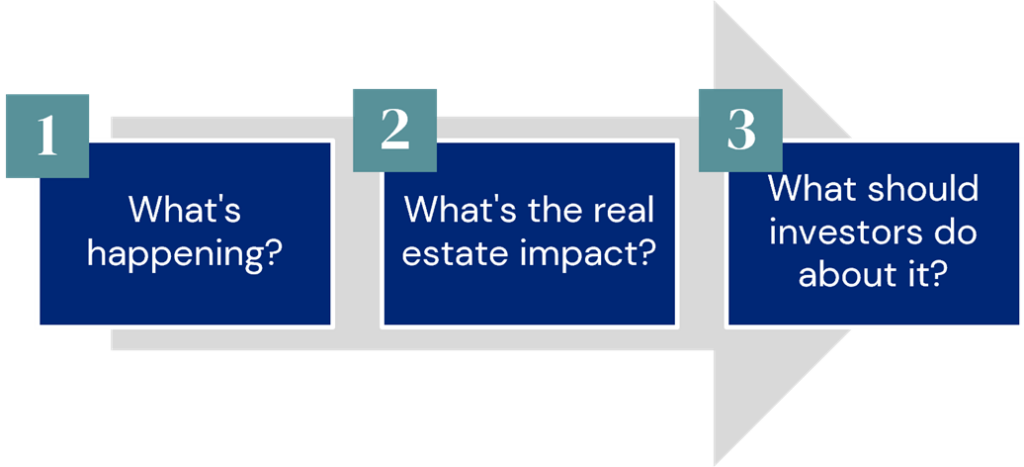
Normally, the “what” of political developments and other events is the easy part. But since the US presidential inauguration, the Trump administration has made policy announcements — especially regarding trade and federal employment — at a rapid pace. Some of these seem to have taken even insiders by surprise. Widespread post-election expectations that actual policy would be more measured than campaign-trail rhetoric have proven incorrect.1 Reversals and postponements have also been a regular occurrence.
Adding to the news flow are announcements by other countries. These include the tit-for-tat of retaliatory tariff measures. But there have also been substantial structural shifts, most notably the German coalition agreement to spend more on infrastructure and defense. This news is arguably linked to a realization by European leaders that, given less collaboration with the US, Europe will have to forge its own path to generate economic growth and provide for its security.2 Aside from the break that this represents from the post-World War II order, this change is significant because it is a key driver of higher economic growth expectations for Europe.
The result of all this is a “layering” of announcements that is difficult to digest at once (see our attempt at a timeline at LMQ p. 4). It is even more of a challenge to roll-forward the news into reasonable predictions for subsequent weeks, let alone months. As a result, measures of economic policy uncertainty have risen to levels close to historic highs (LMQ p. 5). Indeed, the implications of the many recent developments on the growth and inflation outlook include first-order effects such as the direct impacts of lower government spending on GDP and higher prices on tariffed goods (LMQ p. 7), but also the second-order effects of broadly elevated uncertainty.
Uncertainty is the enemy of investment decision-making. This applies both to financial investment as well as spending by businesses in plant, property, equipment and digital tools. Empirical research has shown a clear negative relationship between uncertainty and investment.3 If businesses are unsure (as they are today) about the rules of the road — for example, around the basic terms of trade governing imports and exports — they may be hesitant to commit capital to long-horizon projects. At the same time, expectations of lower taxes and less regulation may push them back toward optimism.
Our analysis of recent events comes with a dose of humility. While LaSalle dedicates significant resources to tracking and analyzing the constant flow of indicators and news — as highlighted by the LaSalle Macro Quarterly (LMQ) — we do not purport to have a unique competitive advantage doing so. We would expect that our readers follow a range of news outlets, forecasters and other observers in staying abreast of the news flow and making sense of it.
We do feel, by contrast, that our experience managing property and data from our portfolio puts us in a strong position to assess the likely impacts of policy developments on real estate. Even in the context of elevated overall uncertainty, we can make several observations with relative confidence.
First, we suspect that a key real estate impact of recent policy trends could be higher replacement costs. Tariffs on construction materials, such as steel, are likely to drive up their price. In addition, a lower level of migration into the US may reduce the supply of construction labor there. Increased European spending on infrastructure and defense could also contribute to higher global and regional materials costs. Higher replacement costs would mean that rents would have to rise more to justify new development, ultimately leading to higher net operating income (NOI) growth. This could counterbalance the impact of macro factors such as a potentially slower economy, as well as property type-specific impacts such as softer demand for housing in the context of muted household formation by immigrants. A simpler way to state this is that real estate can act as an inflation hedge.4
Second, we see value in undertaking granular research to identify potential winners and losers from the current policy environment. This approach can help investors identify real estate that is likely less exposed (or may even benefit from) current trends, while flagging potentially more-impacted market segments. Although the exact mix of government policies remains uncertain, the direction of travel is clear enough in some areas to make a few relative calls. For example, a move away from global free trade could weaken real estate demand related to import-export activities, for example in proximity to ports, while bolstering it in emerging near-shoring hubs.
These sorts of analyses can operate both at the national level, for example by identifying more and less trade-exposed countries (e.g., LMQ p. 9), and at the metro-area level, by examining city-level economic exposures (LMQ p. 10 and 11). One specific economic concentration worth mentioning is that of government employment in Washington, DC. Clearly, job cuts by the newly formed Department of Government Efficiency (DOGE)5 are a risk, but there are mitigating factors such as mandated in-person work; we predict a net negative effect for DC real estate demand, but we have not yet seen much impact on the ground or in the data.
Finally, we note that economic softness comes with mixed effects for real estate. As a long-duration, interest rate-sensitive asset class, it is quite possible that a mild or moderate economic slowdown that leads to lower long interest rates could, in fact, be a positive for real estate values in the aggregate. That said, there are likely to be winners and losers, depending on the relative sensitivity of an asset’s performance to interest rates versus sensitivity to economic growth.6
A bigger risk than a slowdown alone is that of stagflation: weak growth at the same time that sticky inflation keeps rates high. However, most economic research suggests that tariffs represent a one-time upward adjustment to the price level, rather than a driver of a sustained, self-reinforcing cycle of higher inflation;7 as such, central bankers may be more willing to ”look through” the impact of tariffs. So far, a recent softening in 10-year Treasury yields suggests that bond markets agree with that assessment (LMQ p. 26).
All this points to avoiding excessive pessimism on the direction of values, while remaining cautious and selective. But being discriminating is not the only thing investors can do. We also advocate for turning the process of incorporating news flow into strategy on its head. Because we know so little about where the dust will settle on many of the policy shifts, let alone the impacts of those shifts, it is also prudent to ”work backwards” from the implementation step. Some of the most prudent actions an investor can take do not depend on the specific geopolitical or policy debate of the week.

A key recommendation in this regard is to build a globally diversified portfolio. That the market narrative has shifted quickly from one of US dominance of global growth, to a more balanced view with Europe gathering pace, reinforces that countries’ trajectories may exhibit lower correlations in a more fractured global economy. Rapid reversals of market narratives can generate significant market volatility, particularly when they are “priced to perfection” as the post-election optimism now appears to have been. Diversification should help to absorb that volatility, while avoiding being “left out” of unexpected positive shifts. A microcosm of this occurred recently in the public REIT market, where post-election euphoria led to what appeared to us a significant underpricing of European listed real estate.
Investors are also likely to benefit from diversification across the capital stack, which is why we recommend a permanent allocation to real estate debt. As we discussed in our ISA Focus report, “Investing in real estate debt,” debt investment provides low-correlation returns that are by definition not sensitive to volatility contained entirely within the first-loss equity position. While the risk of a recession in the next year is debatable but possibly rising, the risk of an eventual recession is always 100% in the long run. A debt allocation can help add stability and predictability to a portfolio’s return regardless of the exact path the economy takes.
• Investors should not get lost in the noise. Our view, expressed in the ISA Outlook 2025, is that we are at the ”dawn of a new real estate cycle.” This call is not dependent on a highly certain or favorable macro context, but rests on observations specific to real estate. These include pricing that has caught up with bond yields, valuations that have caught up with pricing, solid property fundamentals and substantially approved debt availability, among other factors. Neither a booming economy nor falling rates are necessary conditions for a revival in investment activity or the existence of attractive investment opportunities.
• There will likely be both winners and losers among specific real estate strategies. Granular analysis of risks and mitigants should inform revised assessments of relative value. To get these shifts right, investors must continue to ask: What is priced in? Overreactions are possible, which can create opportunities for investors to take advantage of volatility.
• Near-term uncertainty can distract from a longer-term picture that is arguably clearer. Over a horizon of years and decades, trends toward higher trade barriers and a more fragmented world seem likely to continue. Moving from a global economy where countries with a comparative advantage in producing a particular good do so and sell it to other countries, to one in which trade barriers create more siloed supply chains, would likely have complex effects. Classic economic theory suggests that transition could hinder productivity. But it could also spur real estate demand as productive capacity and inventories are un-pooled and duplicated. Correlations between real estate markets could also decrease. Investors should be ready to build portfolios with these dynamics in mind.
Footnotes
1 We made this mistake as well, saying that “legislative obstacles exist to enacting full campaign-trail rhetoric” in our November 11, 2024 ISA Briefing, “The ‘Red Sweep’ and real estate: has the outlook changed?”.
2 Source: Signum Global Advisors, Piper Sandler, Oxford Economics
3 According to analysis by Piper Sandler, there is an inverse correlation of -42% between a sustained upward shift in policy uncertainty (as measured by the US Economic Policy Uncertainty Index) and GDP growth; a doubling of uncertainty over a quarter is consistent with -1.5% real GDP growth over the following year. For academic work on this relationship, see Baker, Bloom and Davis, 2016
4 For more discussion of real estate’s role as an inflation hedge, see LaSalle’s ISA Portfolio View.
5 DOGE is seeking to quickly remodel the US government to be more effective at a lower cost. If successful, the project could contribute to the US economy’s productive capacity by reducing the crowding-out effect of government spending on private sector activity. Inconveniently, the prospects for reducing government spending face many constraints, not least the fact that a very large proportion of US government spending is committed to entitlement programs like Social Security, Medicare and Medicaid, which most politicians have pledged not to touch. Moreover, in the short term, reduced government employment and lower outlays would directly reduce GDP. Sources: Piper Sandler, Signum Global Advisors
6 In LaSalle’s ISA Outlook 2025, we highlighted our Portfolio Balance framework, which describes real estate market segments according to their historical sensitivities to economic growth and interest rates. The framework segments markets and sectors into four categories: growth-led, rate-led, stable, and reactive. We found that while short-leased, economically sensitive sectors like hotels may see values soften in a recession, other sectors may actually see values benefit if interest rates soften enough.
7 Source: Economic Policy Institute, Federal Reserve Bank of Boston, Piper Sandler
Important notice and disclaimer
This publication does not constitute an offer to sell, or the solicitation of an offer to buy, any securities or any interests in any investment products advised by, or the advisory services of, LaSalle Investment Management (together with its global investment advisory affiliates, “LaSalle”). This publication has been prepared without regard to the specific investment objectives, financial situation or particular needs of recipients and under no circumstances is this publication on its own intended to be, or serve as, investment advice. The discussions set forth in this publication are intended for informational purposes only, do not constitute investment advice and are subject to correction, completion and amendment without notice. Further, nothing herein constitutes legal or tax advice. Prior to making any investment, an investor should consult with its own investment, accounting, legal and tax advisers to independently evaluate the risks, consequences and suitability of that investment. LaSalle has taken reasonable care to ensure that the information contained in this publication is accurate and has been obtained from reliable sources. Any opinions, forecasts, projections or other statements that are made in this publication are forward-looking statements. Although LaSalle believes that the expectations reflected in such forward-looking statements are reasonable, they do involve a number of assumptions, risks and uncertainties. Accordingly, LaSalle does not make any express or implied representation or warranty and no responsibility is accepted with respect to the adequacy, accuracy, completeness or reasonableness of the facts, opinions, estimates, forecasts, or other information set out in this publication or any further information, written or oral notice, or other document at any time supplied in connection with this publication. LaSalle does not undertake and is under no obligation to update or keep current the information or content contained in this publication for future events. LaSalle does not accept any liability in negligence or otherwise for any loss or damage suffered by any party resulting from reliance on this publication and nothing contained herein shall be relied upon as a promise or guarantee regarding any future events or performance. By accepting receipt of this publication, the recipient agrees not to distribute, offer or sell this publication or copies of it and agrees not to make use of the publication other than for its own general information purposes.
Copyright © LaSalle Investment Management 2025. All rights reserved. No part of this document may be reproduced by any means, whether graphically, electronically, mechanically or otherwise howsoever, including without limitation photocopying and recording on magnetic tape, or included in any information store and/or retrieval system without prior written permission of LaSalle Investment Management.
Craig Oram, Portfolio Manager and President of LaSalle Debt Investors and Alexandra Levy, Head of Debt Capital Markets, Americas, discuss the reasons why investors are increasing allocations to US real estate debt.
How should institutional investors seek out reliable income in 2025 when the majority of outlooks – including ours – are expecting the volatility of recent years to continue?
One answer for many investors has been increasing allocations to private credit. Elevated interest rates and repriced assets have led to better lending conditions for providers of alternative funding, with higher yields at lower loan-to-value ratios.
Learn more below.
Want to read more?
Anne Marie Janicki is an Associate at LaSalle Debt Investors and is responsible for assisting in loan origination, underwriting and asset management of debt investments across all real estate property sectors.
Prior to joining LaSalle in 2025, Anne Marie worked at PGIM in the Debt Originations group, focused on core, core-plus, and value add investments across all asset classes throughout the United States. During her five years at PGIM, Anne Marie contributed to the origination, underwriting, and closing of over 60 first mortgage loans.
Anne Marie graduated from the University of Texas at Austin in 2020 and received a Bachelor of Business Administration in finance from the McCombs School of Business.
This article first appeared in a Real Estate Debt special report in the February 2025 issue of Private Debt Investor (subscription required to read the full issue).
LaSalle’s David White and Craig Oram provide insights on navigating the evolving real estate debt markets in the US and Europe. They discuss the risk-adjusted returns that debt investments offer compared to equity, emphasizing steady returns and favorable lending conditions driven by recent market changes. They also share LaSalle’s strategic focus on scalable opportunities and underutilized assets, with a significant emphasis on the for-rent residential sector in the US.
Anna Simpson is LaSalle’s Global Funds Counsel, a position she assumed in December 2024. She leads the Global Funds Team responsible for all legal aspects of the fund-raising life cycle, including product development, fund structuring, marketing, fund documentation, and investor onboarding. The Global Funds Team supports existing and new commingled funds and structured separate accounts across LaSalle’s global platform available for client investment and employee co-investment. Anna joined LaSalle in 2022 as the General Counsel for the Employee Co-Investment program.
Anna has been a general counsel or practicing corporate real estate attorney since 2007. Prior to LaSalle, she spent 10 years with Sterling Bay, a vertically integrated national real estate investment and development company, overseeing all legal matters, including sponsored private equity funds, corporate M&A, financial transactions, tax structuring, regulatory compliance, and commercial real estate. She began her practice at Jones Day, a leading global law firm, counseling public and private companies, private equity funds, major banks, and commercial borrowers on diverse transactions, including private equity fund formation, real estate transactions, debt financing, and joint ventures.
Anna received her Juris Doctor from Indiana University in Bloomington, Indiana and her Bachelor of Arts from Tufts University in Medford, Massachusetts. Anna clerked for Justice Susan W. Calkins of the Maine Supreme Judicial Court, 2006 – 2007. She is licensed to practice law in Illinois and Massachusetts.
Chicago (January 6, 2025) – LaSalle Investment Management (LaSalle) announced today the acquisition of Tempe Commerce Park, a five-building industrial complex totaling 536,122 square feet in Tempe, Arizona. The acquisition was made on behalf of LaSalle Property Fund (LPF), the firm’s US core open-ended fund.

The property, situated on 36.79 acres, features 24-foot clear heights, dock-high and grade-level doors, and ample parking. The complex is 92% leased to eight diverse tenants, including McKesson, Genuine Cable Group and Rivian. Located at 7340-7360 South Kyrene Road and 7333-7343 South Hardy Drive, Tempe Commerce Park benefits from its position in one of Metro Phoenix’s most sought-after submarkets, offering excellent accessibility to major transportation routes.
Jim Garvey, President and Portfolio Manager, LaSalle Property Fund said: “This acquisition aligns with our strategy to increase the Fund’s industrial allocation in high-growth metropolitan markets. Tempe Commerce Park is an excellent addition to our portfolio, offering exposure to a prime infill submarket.”
Matt Bogovich, Vice President of Transactions added: “We’re excited to acquire this high-quality industrial complex in Tempe, a key submarket within Metro Phoenix. The property’s strategic location, diverse tenant mix, and recent improvements position it well to capitalize on the area’s strong industrial fundamentals and continued growth.”
About LaSalle Investment Management | Investing Today. For Tomorrow.
LaSalle Investment Management is one of the world’s leading real estate investment managers. On a global basis, LaSalle manages US$88.8 billion of assets in private and public real estate equity and debt investments as of Q3 2024. LaSalle’s diverse client base includes public and private pension funds, insurance companies, governments, corporations, endowments and private individuals from across the globe. LaSalle sponsors a complete range of investment vehicles, including separate accounts, open- and closed-end funds, public securities and entity-level investments.
For more information, please visit www.lasalle.com, and LinkedIn.
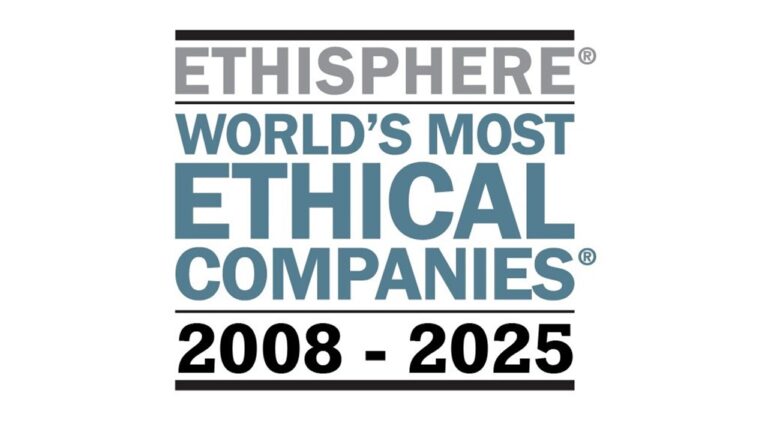


Chicago (December 11, 2024) – LaSalle Investment Management (LaSalle) is pleased to announce it has been named a Best Place to Work in Money Management for 2024 by Pensions & Investments. This marks the ninth consecutive year LaSalle has received this prestigious recognition.
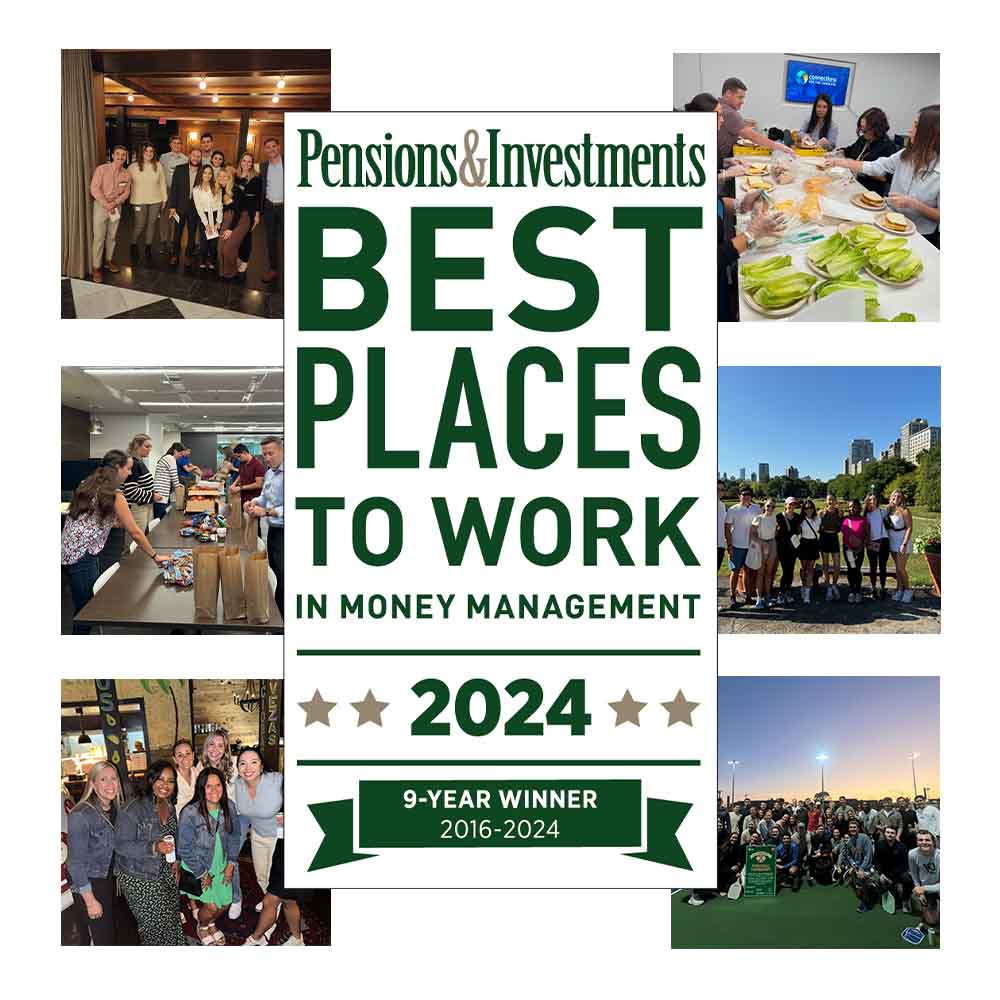
Presented by Pensions & Investments, the global news source of money management and institutional investing, the 13th annual survey and recognition program is dedicated to identifying and recognizing the best employers in the money management industry.
“Earning the ‘Best Place to Work’ recognition for the ninth time highlights what drives LaSalle’s success: our people and culture. This culture, shaped by every employee, fuels our client service, investment performance, and talent development. We’re proud that our commitment to an inspiring workplace continues to be recognized. Thank you to our employees for making LaSalle not just a great place to work, but a leader in investment management,” said Brad Gries, LaSalle Head of Americas.
“As their employees attest, the companies named to this year’s Best Places to Work list demonstrate a commitment to building and maintaining a strong workplace culture,’’ said P&I Editor-in-Chief Julie Tatge. “In doing so, they’re helping their employees, clients and their businesses succeed.’’
“Pensions & Investments is proud to honor the Best Places to Work in Money Management for the 13th year. A strong workplace culture that supports talent, advocates progress and drives innovation is paramount to driving the best outcomes and these asset managers demonstrate that. Congratulations to the 2024 honorees for their commitment to employee well-being, attractive incentive structures and talent development that demonstrate how investing in your employees can elevate our industry to greater heights,” said P&I President and Publisher Nikki Pirrello.
Pensions & Investments partnered with Workforce Research Group, a research firm specializing in identifying great places to work, to conduct a two-part survey process of employers and their employees.
The first part consisted of evaluating each nominated company’s workplace policies, practices, philosophy, systems and demographics. This part of the process was worth approximately 20% of the total evaluation. The second part consisted of an employee survey to measure the employee experience. This part of the process was worth approximately 80% of the total evaluation. The combined scores determined the top companies.
For a complete list of the 2024 Pensions & Investments’ Best Places to Work in Money Management winners and profiles of the top firms across size categories, go to http://www.pionline.com/BPTW2024
End.
About LaSalle Investment Management | Investing Today. For Tomorrow.
LaSalle Investment Management is one of the world’s leading real estate investment managers. On a global basis, LaSalle manages US$88.2 billion of assets in private and public real estate equity and debt investments as of Q3 2024. LaSalle’s diverse client base includes public and private pension funds, insurance companies, governments, corporations, endowments and private individuals from across the globe. LaSalle sponsors a complete range of investment vehicles, including separate accounts, open- and closed-end funds, public securities and entity-level investments.
For more information, please visit www.lasalle.com, and LinkedIn.
About Pensions & Investments
Pensions & Investments, owned by Crain Communications Inc., is the 51-year-old global news source of money management and institutional investing. P&I is written for executives at defined benefit and defined contribution retirement plans, endowments, foundations, and sovereign wealth funds, as well as those at investment management and other investment-related firms. Pensions & Investments provides timely and incisive coverage of events affecting the money management and retirement businesses. Visit us at www.pionline.com.



Chicago (December 4, 2024) – US and Canadian real estate is on the verge of a new cycle in 2025, with interest rates down from peak levels and economic growth concerns fading, but also new risks on the horizon, according to the North America chapter of the ISA Outlook 2025 report published by global real estate investment manager LaSalle Investment Management (“LaSalle”).
The landscape for US and Canadian real estate has shifted since last year’s ISA Outlook 2024, which saw lower transaction volumes due to higher interest rates and challenging macroeconomic conditions. LaSalle sees considerable differences between this upcoming cycle and prior ones across both countries. Specifically, interest rates are expected to remain higher, which will lead to a more moderate pace of value recovery. And while the pace of capital flows to real estate is expected to pick-up in 2025, conditions across real estate sectors and markets will remain uneven.
These differences suggest that investing into the coming real estate cycle will not be a simple story of a “rising tide lifts all boats”; selectivity at the sector, market and sub-market level is likely to add value. LaSalle’s ISA Outlook 2025 follows several main themes that will influence real estate decision-making within the US and Canada, as well as sector by sector analysis of different property types:
Global and North American Property Sector Outlooks
The North America chapter of the ISA forms part of LaSalle’s Global ISA Outlook 2025, which analyzes real estate trends across geographies and sectors, and similarly finds the new cycle extends to global real estate markets.
Richard Kleinman, LaSalle’s Americas Head of Research and Strategy, said: “We are on the cusp of a new real estate cycle both globally and in the Americas specifically. That said, navigating the current environment will require selectivity at the sector, market, and submarket levels. The ISA Outlook 2025 research we’ve released today looks in depth at what is driving trends in North American real estate, and lays out our strategy for the year ahead.”
Chris Langstaff, Head of Research and Strategy for Canada at LaSalle, commented: “Our outlook for Canadian real estate next year resembles many of our global projections, with some important distinctions. Optimism is a bit more contained as economic performance has lagged and there’s been uncertainty around trade policies, but favourable demographics, healthy fundamentals in most sectors and forecasts for improved GDP and job growth in 2025 and 2026 will continue to drive opportunities across markets, including in specialty sectors.”
Brian Klinksiek, Global Head of Research and Strategy at LaSalle, added: “Global real estate sentiment is gradually improving following a long period of negativity and signs are pointing to the beginning of a new real estate cycle. History has shown that investing early in a cycle tends to lead to relatively strong performance. There are still risks on the horizon, however, and investors are advised to focus on diversified strategies that are flexible and broad enough to adapt to a complex and evolving relative value landscape. A comprehensive look at value across a wide range of sectors and markets will be required to build a well-positioned real estate portfolio.”
Ends
About LaSalle Investment Management | Investing Today. For Tomorrow.
LaSalle Investment Management is one of the world’s leading real estate investment managers. On a global basis, LaSalle manages US$88.2 billion of assets in private and public real estate equity and debt investments as of Q3 2024. LaSalle’s diverse client base includes public and private pension funds, insurance companies, governments, corporations, endowments and private individuals from across the globe. LaSalle sponsors a complete range of investment vehicles, including separate accounts, open- and closed-end funds, public securities and entity-level investments.
For more information, please visit www.lasalle.com, and LinkedIn.
NOTE: This information discussed above is based on the market analysis and expectations of LaSalle and should not be relied upon by the reader as research or investment advice regarding LaSalle funds or any issuer or security in particular. The information presented herein is for illustrative and educational purposes and is not a recommendation, offer or solicitation to buy or sell any securities or to adopt any investment strategy in any jurisdiction where prohibited by law or where contrary to local law or regulation. Any such offer to invest, if made, will only be made to certain qualified investors by means of a private placement memorandum or applicable offering document and in accordance with applicable laws and regulations. Past performance is not indicative of future results, nor should any statements herein be construed as a prediction or guarantee of future results.



This article first appeared in the December 2024/January 2025 edition of PERE.
LaSalle’s Ryu Konishi and Julie Manning spoke to PERE about the growing importance of sustainability as part of investment decision-making and LaSalle’s approach to creating a global real estate net zero carbon pathway strategy.
A 360-degree approach to decarbonization
The importance of sustainability as part of investment decision-making in the real estate space has been on the rise for quite some time. In fact, the various physical risks associated with climate change, and the regulatory imperative of transitioning to net zero, are now so significant that these factors are gradually filtering through in the form of real-world valuation impacts.
For real estate investors, this raises both risks and opportunities. LaSalle Investment Management is one firm that was early to recognize this, having set up a global sustainability committee back in 2008. More recently, it has worked with the Urban Land Institute to develop a decision-making framework for assessing physical climate risk in relation to its real estate investments.
According to Julie Manning, global head of climate and carbon, and Ryu Konishi, fund manager of Lp3F (LaSalle’s global real estate net-zero strategy), this kind of approach to risk analysis – both broad and deep – is essential. So, where should investors start? And what might a determined decarbonization program in real estate look like?
Almost three years after interest rates began to spike leading into the Great Tightening Cycle, the first light of a new real estate cycle is clearly visible on the horizon. As with the start of every new day, however, opportunities and challenges lie ahead. LaSalle’s Research and Strategy team will examine both throughout the course of November and December, as we publish four separate chapters, one covering our global outlook, and three deep-dives covering the outlook for Europe, North America and Asia Pacific. Each chapter can be found alongside an accompanying video conversations with lead authors on the links below.
In the Global chapter of ISA Outlook 2025, we look at how to make the most of this new dawn and the opportunities it may present, but with a watchful eye on ways the new day could go off track. We examine these through four broad themes in this year’s report: the morning sky, the capital stack hangover, the breakfast menu, and the early bird.
We examine each of these concepts in turn, and ask what each means for real estate and they intersect with one another and other key trends.
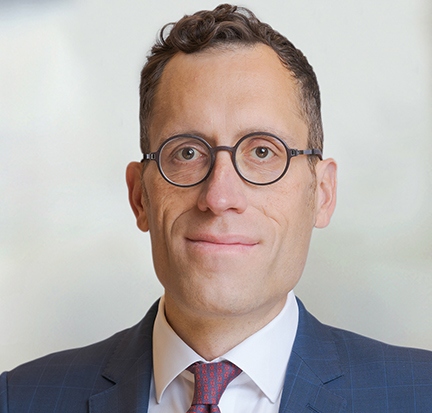
Global Head of Research and Strategy

Managing Director, Global Research and Strategy
While dawn is universal, across Europe it can appear different from each location and every angle. European real estate is transiting inflection points following a deep capital market correction. The INREV ODCE index shifted in the latest quarter from declines to positive after seven down quarters.
Against this backdrop, we share our Impressions of a Rising Cycle in Europe, with a focus on what makes the region different from others across the globe. We also share our five key strategy themes for investors in European real estate for the year ahead.

Europe Head of Research and Strategy

Europe Head of Core and Core-plus Research and Strategy

Europe Head of Debt and Value-add Capital Research and Strategy
The summer and autumn of 2024 saw growing optimism among real estate investors. The belief that the dawn of 2025 would open with sunny skies for the real estate market was driven by falls in interest rates from peak levels, fading economic growth concerns and real estate valuations now more aligned with market transactions.
But with more uncertainty creeping into the picture in late 2024, especially around longer-term interest rates, what we see could be described as a “partly cloudy sunrise.”

Americas Head of Research and Strategy

Canada Head of Research and Strategy
The current real estate cycle in Asia Pacific is not a simple repetition of a typical cycle. While Asia Pacific economies have not been immune to supply chain disruptions and elevated inflation, interest rates and construction costs, real estate capital market liquidity in the region (with the exception of China and Hong Kong) has fared much better than in other parts of the world.
In our view, the varying and sometimes contrasting cyclical patterns among major real estate sectors within each country set the region apart from global trends.

Vice President, Strategist

China Head of Research and Strategy
Published every year since 1993, LaSalle’s annual ISA Outlook is designed to help our clients and partners navigate the year ahead. It brings together smart perspectives and investment ideas from our teams around the world, based on what we see across our more than 1,200 assets that span geographies, property types and risk profiles.
As always, we welcome your feedback. If you have any questions, comments or would like to learn more,
please get in touch by using our Contact Us page.
On November 19, 2024, LaSalle hosted a client webinar to discuss the outlook for listed real estate. LaSalle Global Solutions Chief Investment Officer Matt Sgrizzi offered a recap of our recent ISA Briefing: A new “golden era” for REITs and real estate? and took questions from clients in attendance.
This publication does not constitute an offer to sell, or the solicitation of an offer to buy, any securities or any interests in any investment products advised by, or the advisory services of, LaSalle Investment Management (together with its global investment advisory affiliates, “LaSalle”). This publication has been prepared without regard to the specific investment objectives, financial situation or particular needs of recipients and under no circumstances is this publication on its own intended to be, or serve as, investment advice. The discussions set forth in this publication are intended for informational purposes only, do not constitute investment advice and are subject to correction, completion and amendment without notice. Further, nothing herein constitutes legal or tax advice. Prior to making any investment, an investor should consult with its own investment, accounting, legal and tax advisers to independently evaluate the risks, consequences and suitability of that investment.
LaSalle has taken reasonable care to ensure that the information contained in this publication is accurate and has been obtained from reliable sources. Any opinions, forecasts, projections or other statements that are made in this publication are forward-looking statements. Although LaSalle believes that the expectations reflected in such forward-looking statements are reasonable, they do involve a number of assumptions, risks and uncertainties. Accordingly, LaSalle does not make any express or implied representation or warranty, and no responsibility is accepted with respect to the adequacy, accuracy, completeness or reasonableness of the facts, opinions, estimates, forecasts, or other information set out in this publication or any further information, written or oral notice, or other document at any time supplied in connection with this publication. LaSalle does not undertake and is under no obligation to update or keep current the information or content contained in this publication for future events. LaSalle does not accept any liability in negligence or otherwise for any loss or damage suffered by any party resulting from reliance on this publication and nothing contained herein shall be relied upon as a promise or guarantee regarding any future events or performance.
By accepting receipt of this publication, the recipient agrees not to distribute, offer or sell this publication or copies of it and agrees not to make use of the publication other than for its own general information purposes.
Copyright © LaSalle Investment Management 2024. All rights reserved. No part of this document may be reproduced by any means, whether graphically, electronically, mechanically or otherwise howsoever, including without limitation photocopying and recording on magnetic tape, or included in any information store and/or retrieval system without prior written permission of LaSalle Investment Management.
Chicago (November 18, 2024) – LaSalle Investment Management (“LaSalle”), the global real estate investment manager, is pleased to announce the appointment of Tara McCann as Head of Americas Investor and Consultant Relations, effective November 4. In this role, Tara leads LaSalle’s efforts to strengthen relationships with existing institutional investors, enhance consultant relationships and expand the firm’s network across the Americas.

Tara’s appointment reinforces LaSalle’s commitment to continually strengthen its investor relations capabilities as well as to diversify product offerings and broaden distribution channels in the Americas to drive long-term growth. Based in New York, she reports to Samer Honein, Global Head of Investor Relations. Tara will assume the responsibilities of Adam Caskey, Head of Americas Investor Relations, who is set to retire in December this year.
Tara is a real estate industry veteran with over 25 years of experience in senior roles across investor relations, product development, acquisitions, and investment banking. She joins LaSalle from Rockwood, where she served as Head of Capital and Client Strategies, while also spearheading the firm’s sustainability initiatives. Prior to that, Tara was a Managing Director with USAA Real Estate Company, serving as the product specialist for opportunistic and credit strategies. She has also held senior roles at H/2 Capital Partners, Ranieri Real Estate Partners and the Deutsche Bank Securities’ Real Estate Investment Banking Group.
Tara received a Master of Business Administration in Finance from Columbia Business School and a Bachelor of Arts in Economics and Urban Studies from Brown University.
Samer Honein, Global Head of Investor Relations at LaSalle, added: “Tara’s experience in investor relations, product development and strategic insights across the real estate industry make her an ideal addition to the team. We look forward to her leadership of our Americas investor relations efforts, reinforcing our commitment to deliver world-class partnerships to our clients.”
Brad Gries, Head of Americas at LaSalle, commented: “Tara’s appointment is a key step in our strategy to enhance our coverage and product offerings in the Americas. Her deep industry knowledge and established relationships will be instrumental as we continue to deliver innovative solutions to meet the evolving needs of our investors in the region.”
Tara McCann, Head of Americas Investor and Consultant Relations at LaSalle said: “I am excited to join a firm with LaSalle’s values and global platform at this exciting time of growth. I look forward to expanding our relationships and continuing LaSalle’s legacy of delivering innovative solutions that meet the evolving needs in real estate investment of our partners.”
ENDS
About LaSalle Investment Management | Investing Today. For Tomorrow.
LaSalle Investment Management is one of the world’s leading real estate investment managers. On a global basis, LaSalle manages US$84.8 billion of assets in private and public real estate equity and debt investments as of Q2 2024. LaSalle’s diverse client base includes public and private pension funds, insurance companies, governments, corporations, endowments and private individuals from across the globe. LaSalle sponsors a complete range of investment vehicles, including separate accounts, open- and closed-end funds, public securities and entity-level investments.
For more information, please visit www.lasalle.com, and LinkedIn.



Tara McCann is the Head of Americas Investor and Consultant Relations based in New York. She is responsible for overseeing investment relationships with investors and consultants across the Americas, focusing on capital raising, strategic investments and product development.
Tara brings over 25 years of real estate industry experience to LaSalle, with expertise spanning investor relations, product development, acquisitions and investment banking. Prior to joining LaSalle, she was Head of Capital and Client Strategies at Rockwood, where she also led the firm’s sustainability initiatives. Previously, Tara served as a Managing Director at USAA Real Estate Company, specializing in opportunistic and credit strategies. Her career also includes senior roles at H/2 Capital Partners, Ranieri Real Estate Partners and the Deutsche Bank Securities’ Real Estate Investment Banking Group.
Tara holds an Master of Business Administration in Finance from Columbia Business School and a Bachelor of Arts in Economics and Urban Studies from Brown University.
Want to read more?
The impacts of US presidential elections on financial markets and especially real estate are often overstated, as we have pointed out previously (see our ISA Briefing, “Elections everywhere, all at once”). An excessive focus on the news cycle can distract from important ongoing trends that are not ‘new news’, such as a broad global trend toward cooling inflation. Headlines also tend to accentuate differences, rather than commonalities, between outcomes. For example, regardless of the election result, trends favored greater nearshoring, and both US political parties are hawkish on China.
That said, last week’s initial reaction to the election result by the media and markets was significant. Looking beyond near-term noise and volatility, we offer our perspective on what it might mean for real estate over medium- and long-term timescales. This is based on our own analysis, the views of third-party providers,[1] and discussions across our research, investment and leadership teams. We recommend investors keep in mind four observations when considering the election result:

Legislative obstacles exist to enacting full campaign-trail rhetoric. The almost certain ‘red sweep’ outcome (Republican control of the White House, Senate and House of Representatives) should make it easier to pass legislation than under the anticipated divided government scenario.[2] The Republican victory has been labelled a ‘mandate’ by the media, but legislatively, it is not a blank check. The Republican majority in the House will be razor-thin and that means that legislation must be agreed by the full spectrum of Republican legislators, which is not uniformly aligned with campaign promises. This will likely exert a moderating force on what the next Trump administration can do, especially around policies that increase the budget deficit. Republicans will also lack a filibuster-proof majority in the Senate and face likely unified resistance from Democrats in that chamber, limiting probable action on many types of legislation.[3]

A shift toward a higher path of growth, inflation and interest rates is possible, but mostly on the margins. Beyond the moderating impacts of the political process, one reason the delta may not be large is that there are likely offsetting impacts. Commentary has focused on Trump policies that potentially boost the prospects for economic growth, including reduced regulation by federal agencies and tax cuts (e.g., fully extending the expiring TCJA[4] and cutting corporate tax rates). But they may exist alongside policies that could be negatives for growth, such as a reduction of net migration to close to zero, which would stifle household formation. Similarly, there are potential Trump policies that may boost inflation, as well as those that could reduce it. Tariffs, fiscal loosening and reduced availability of low-wage immigrant labor would likely be inflationary. But greater domestic US fossil fuel production may be a counterbalancing deflationary force.
Where does all this leave the path of interest rates, which for the first time in two years have been on a clear easing path? The markets’ reaction to the election is instructive. When the scale of Trump’s victory became clear, the 10-year Treasury yield spiked, but it later eased and ended the week lower than it started. Corporate bond yields, our preferred building block for real estate pricing, felt some upward pressure, but also benefitted from narrowing risk spreads.
Meanwhile, the US Federal Reserve and the Bank of England stayed on course, going ahead with policy rate cuts as expected. This suggests there is no likely near-term change of course by monetary policymakers, and the overall bias towards gradually easing interest rates likely remains intact. However, depending on the net impact to growth and inflation, the decline in rates may be a little less steep and they may settle at a slightly higher level than previously expected. However, the change is not enough to prompt a wholesale change in the outlook.

Real estate sectors are likely to see a complex, sometimes offsetting, mix of impacts. For example, the multi-family sector in the US may face a weaker demand outlook if household formation is lower due to sharply reduced immigration. However, it may also experience less new supply if the construction labor force is constrained. There is similar variation in potential impacts for logistics markets. Trade barriers may lead to more regionalized production, which at the margin could lead to established and emerging manufacturing nodes seeing more demand. Meanwhile, import/export-related locations, such as submarkets near ports and airports, may see less demand. There are also potential, if uncertain, impacts that shape the outlook for entire property types. For example, replicating supply chains across borders could represent a net positive for global logistics demand, even if doing so is economically inefficient.[5]

Net impacts to ex-US real estate are also complex. Geopolitical implications, such as those concerning Israel-Gaza and Ukraine, are difficult to predict and do not likely have major implications for the real estate markets where we invest. Regarding trade,tariff proposals are probably best seen as an opening for negotiation.[6] Europe may face minimal new tariffs if its governments agree to spend more on defense, a key ask of President-Elect Trump. But the outcome of any upcoming negotiations is a guessing game at best, and there is a wide spread of views on the probable impact to Europe of US tariffs.[7] Finally, it is worth analyzing potentially differential impacts across global markets. For example, services are not as likely to be subject to tariffs, reducing the impact of trade barriers on services and consumption-oriented economies like the United Kingdom or Spain, versus goods export-heavy Germany.
Variable impacts on specific markets aside, in our view the case for global real estate investment remains intact. In part, this is because the broader trend toward protectionism, potentially accelerated by Trump’s tariff proposals, could lead to decreased return correlations across countries. National markets may begin to align less with global and more with regionalized or country-specific cyclical patterns. This could increase the potential diversification benefits of global real estate investment, the existing case for which we highlighted in our ISA Portfolio View 2024.
Sitting between equities and fixed income, real estate is a hybrid asset class that combines sensitivity to growth with sensitivity to interest rates. Different scenarios for growth and inflation should be considered in the context of varying sensitivities to each across real estate sectors. In the global chapter of our forthcoming ISA Outlook 2025, we will introduce our new Portfolio Balance framework, which does just that.
The net impact of the US election result on specific real estate markets and sectors depends on a complex interaction of multiple incremental factors, some of them offsetting. The regional chapters of the upcoming ISA Outlook 2025 will provide a more detailed discussion of potential sector- and country-specific election impacts across the markets where we invest. Please have a read!
Footnotes
1 These include Oxford Economics, Capital Economics, Piper Sandler, Signum Global Advisors and Green Street Advisors, among others.
2 Going into election day, major models such as those maintained by the New York Times and Nate Silver pegged the presidential candidates’ chances as a ‘coin toss‘ (50%/50%), but with a high degree of probability of a divided control of government (up to 80%). Divided government is typically characterized by policy stability due to difficulties passing new legislation, limiting the degree of likely policy change. It would have likely reduced the expected delta between a Trump and Harris presidency.
3 US senate rules allow for only certain types of legislation, notably certain types of budget bills under the “reconciliation” process, to be passed without a 60-seat supermajority.
4 The Tax Cuts and Jobs Act was a major tax reform bill passed by the Trump administration in 2017, with many of its provisions sunsetting in 2025.
5 Operations theory suggests that splitting one inventory pool into multiple, regionalized pools would increase the aggregate level of inventory required to achieve the ‘optimal’ safety stock that balances the costs of ‘stock outs’ against the cost of carrying inventory. More manufacturing/production space would probably also be required.
6 This statement and others in this paragraph are based on analysis by Signum Global Advisors, the Economist, the Financial Times, Oxford Economics and Capital Economics.
7 Capital Economics expects just a -0.2% Eurozone GDP drag from new tariffs, while many investment banks say tariffs, if enacted, could represent a -1.5% hit to European GDP growth.
This publication does not constitute an offer to sell, or the solicitation of an offer to buy, any securities or any interests in any investment products advised by, or the advisory services of, LaSalle Investment Management (together with its global investment advisory affiliates, “LaSalle”). This publication has been prepared without regard to the specific investment objectives, financial situation or particular needs of recipients and under no circumstances is this publication on its own intended to be, or serve as, investment advice. The discussions set forth in this publication are intended for informational purposes only, do not constitute investment advice and are subject to correction, completion and amendment without notice. Further, nothing herein constitutes legal or tax advice. Prior to making any investment, an investor should consult with its own investment, accounting, legal and tax advisers to independently evaluate the risks, consequences and suitability of that investment.
LaSalle has taken reasonable care to ensure that the information contained in this publication is accurate and has been obtained from reliable sources. Any opinions, forecasts, projections or other statements that are made in this publication are forward-looking statements. Although LaSalle believes that the expectations reflected in such forward-looking statements are reasonable, they do involve a number of assumptions, risks and uncertainties. Accordingly, LaSalle does not make any express or implied representation or warranty, and no responsibility is accepted with respect to the adequacy, accuracy, completeness or reasonableness of the facts, opinions, estimates, forecasts, or other information set out in this publication or any further information, written or oral notice, or other document at any time supplied in connection with this publication. LaSalle does not undertake and is under no obligation to update or keep current the information or content contained in this publication for future events. LaSalle does not accept any liability in negligence or otherwise for any loss or damage suffered by any party resulting from reliance on this publication and nothing contained herein shall be relied upon as a promise or guarantee regarding any future events or performance.
By accepting receipt of this publication, the recipient agrees not to distribute, offer or sell this publication or copies of it and agrees not to make use of the publication other than for its own general information purposes.
Copyright © LaSalle Investment Management 2024. All rights reserved. No part of this document may be reproduced by any means, whether graphically, electronically, mechanically or otherwise howsoever, including without limitation photocopying and recording on magnetic tape, or included in any information store and/or retrieval system without prior written permission of LaSalle Investment Management.
This article first appeared in the November 2024 edition of IREI Americas (subscription required).
Senior real estate credit specialists from LaSalle discuss the rising significance of senior real estate mortgage credit in investment portfolios with Institutional Real Estate Investor. They explore its ability to provide steady income and downside protection, the growing role of alternative lenders, and the current market opportunity. The article examines how this strategy offers attractive risk-adjusted returns, portfolio diversification, and enhanced resilience in today’s dynamic economic environment.
Want to read more?
We regularly receive questions about past property market dislocations and what they might tell us about today, such as: Is office the new retail?, Will the 7+ years it took retail to rebalance be a template for office? and Should we be worried about the wave of supply in US apartments?
In our latest ISA Focus report, Rebalancing past and present, we engage in patten recognition across a range of historical episodes of occupier market challenges. We present a framework for how these imbalances tend to be resolved, and discuss the range of structural and cyclical factors that drive rebalancing. We also present a selection of historical case studies from around the world, highlighting the complex nature of the rebalancing process and how it can occur not only at different speeds, but also with “bumps in the road” for investors.
We conclude the report with a refresh of our ISA Focus: Revisiting the future of office, noting in particular that there will be specific investment opportunities that arise as the current rebalancing cycle plays out.
Important notice and disclaimer
This publication does not constitute an offer to sell, or the solicitation of an offer to buy, any securities or any interests in any investment products advised by, or the advisory services of, LaSalle Investment Management (together with its global investment advisory affiliates, “LaSalle”). This publication has been prepared without regard to the specific investment objectives, financial situation or particular needs of recipients and under no circumstances is this publication on its own intended to be, or serve as, investment advice. The discussions set forth in this publication are intended for informational purposes only, do not constitute investment advice and are subject to correction, completion and amendment without notice. Further, nothing herein constitutes legal or tax advice. Prior to making any investment, an investor should consult with its own investment, accounting, legal and tax advisers to independently evaluate the risks, consequences and suitability of that investment.
LaSalle has taken reasonable care to ensure that the information contained in this publication is accurate and has been obtained from reliable sources. Any opinions, forecasts, projections or other statements that are made in this publication are forward-looking statements. Although LaSalle believes that the expectations reflected in such forward-looking statements are reasonable, they do involve a number of assumptions, risks and uncertainties. Accordingly, LaSalle does not make any express or implied representation or warranty, and no responsibility is accepted with respect to the adequacy, accuracy, completeness or reasonableness of the facts, opinions, estimates, forecasts, or other information set out in this publication or any further information, written or oral notice, or other document at any time supplied in connection with this publication. LaSalle does not undertake and is under no obligation to update or keep current the information or content contained in this publication for future events. LaSalle does not accept any liability in negligence or otherwise for any loss or damage suffered by any party resulting from reliance on this publication and nothing contained herein shall be relied upon as a promise or guarantee regarding any future events or performance.
By accepting receipt of this publication, the recipient agrees not to distribute, offer or sell this publication or copies of it and agrees not to make use of the publication other than for its own general information purposes.
Copyright © LaSalle Investment Management 2024. All rights reserved. No part of this document may be reproduced by any means, whether graphically, electronically, mechanically or otherwise howsoever, including without limitation photocopying and recording on magnetic tape, or included in any information store and/or retrieval system without prior written permission of LaSalle Investment Management.
Ellie Mager is a Senior Portfolio Accountant for the LaSalle Canada Property Fund. In this role, she is responsible for the preparation of fund financial statements, investor reporting, and performance return calculation and analysis. Ellie also collaborates with the sustainability team on global data governance and carbon accounting initiatives. She began her commercial real estate career with LaSalle in 2022.
Prior to joining LaSalle, Ellie worked in public accounting as Senior Associate within Grant Thornton LLP’s audit practice.
Ellie holds a Bachelor of Science in Accounting from DePaul University. She is also a Certified Public Accountant.
Toronto (October 22, 2024) – LaSalle Canada Property Fund (“LCPF” or “the fund”), LaSalle Investment Management (“LaSalle”)’s core real estate fund in Canada, has achieved the highest rating of five stars from the 2024 Global Real Estate Sustainability Benchmark (“GRESB”), an industry-recognized global sustainability benchmark for asset managers. Additionally, LCPF has been named the Real Estate Sector Leader for all Americas Private Diversified Funds, ranking first out of 112 entities in this category.
LaSalle Canada Property Fund scored 90/100 on the annual assessment, earning first place within its 17-member sector peer group. This achievement highlights the fund’s market-leading sustainability initiatives that continue to play a key role in the active asset management of the LCPF portfolio. In addition to the recognition for LCPF, seven other LaSalle funds and separate accounts domiciled across Europe, North America, and the Asia-Pacific regions were awarded a 5-star rating, with five additional LaSalle funds achieving a four-star rating.


Elena Alschuler, LaSalle Head of Sustainability, Americas, said: “This latest recognition as a GRESB sector leader reflects LaSalle’s ongoing dedication to meeting our clients’ sustainability goals, while enhancing the market value of our properties. Since its inception in 2017, LCPF has viewed sustainability as a key component of a high-quality property. This investment view informs decisions about both acquisitions and capital improvements, resulting in a portfolio that is in a leading position amongst peers.”
Sam Barbieri, LaSalle Managing Director of Development and Fund Management, added: “LCPF stands as a strong example of our commitment to both sustainability and investment excellence. This year’s GRESB score and our position as the Real Estate Sector Leader for all Americas Private Diversified Funds are a testament to the team’s hard work over the past year developing and embracing new strategies that align with the fund’s philosophy of ensuring sustainability goals are met, while simultaneously generating income for clients.”
The LCPF portfolio exemplifies sustainability across its diverse properties, with several standout examples highlighting this commitment. Montréal’s Maison Manuvie boasts net zero carbon performance, Ottawa’s 275 Slater is undergoing sustainability upgrades targeting LEED Certification, and the Tricont logistics properties in Whitby were designed to meet the prestigious LEED® Silver certifications through the Canada Green Building Council. These assets, among others in the portfolio, demonstrate LCPF’s broad commitment to environmental responsibility across various property types and locations.
LCPF’s portfolio totals nearly 9.4 million square feet across Vancouver, Calgary, Edmonton, Toronto, Ottawa and Montreal – the key markets in Canada’s investable real estate universe. The portfolio includes industrial, multifamily, office, retail and mixed-use properties, along with select development projects in these sectors.
ENDS
About LaSalle Canada Property Fund (LCPF)
LCPF is an open-ended fund targeting core properties in major markets across Canada. The fund is targeting commitments from Canadian and global institutional investors seeking access to the Canadian real estate market through a diversified, income-oriented vehicle. Launched in 2017, the fund aims to provide investors with immediate exposure to a diverse and mature portfolio comprised of office, industrial, mixed-use, retail and multifamily assets. Through its near-term pipeline of potential future investments, the fund will seek to take advantage of mispriced assets as it continues to grow.
About LaSalle Investment Management | Investing Today. For Tomorrow
LaSalle Investment Management is one of the world’s leading real estate investment managers. On a global basis, LaSalle manages US$84.8 billion of assets in private and public real estate equity and debt investments as of Q2 2024. LaSalle’s diverse client base includes public and private pension funds, insurance companies, governments, corporations, endowments and private individuals from across the globe. LaSalle sponsors a complete range of investment vehicles, including separate accounts, open- and closed-end funds, public securities and entity-level investments.
For more information, please visit www.lasalle.com, and LinkedIn.
About GRESB
GRESB is an industry-driven organization transforming the way capital markets assess the sustainability performance of real asset investments. More than 900 property companies and funds, jointly representing more than USD 3.6 trillion in assets under management, participated in the 2018 GRESB Real Estate Assessment. The Infrastructure Assessment covered 75 funds and 280 assets, and 25 portfolios completed the Debt Assessment. GRESB data and analytical tools are used by more than 75 institutional and retail investors, including pension funds and insurance companies, collectively representing over USD 18 trillion in institutional capital, to engage with investment managers to enhance and protect shareholder value. Greater transparency on sustainability issues has become the norm, with GRESB widely recognized as the global sustainability benchmark for real assets. For more information about GRESB and its sustainability benchmarking and reporting for real estate, please visit https://gresb.com/gresb-real-estate-assessment/.
NOTE: This information discussed above is based on the market analysis and expectations of LaSalle and should not be relied upon by the reader as research or investment advice regarding LaSalle funds or any issuer or security in particular. The information presented herein is for illustrative and educational purposes and is not a recommendation, offer or solicitation to buy or sell any securities or to adopt any investment strategy in any jurisdiction where prohibited by law or where contrary to local law or regulation. Any such offer to invest, if made, will only be made to certain qualified investors by means of a private placement memorandum or applicable offering document and in accordance with applicable laws and regulations. Past performance is not indicative of future results, nor should any statements herein be construed as a prediction or guarantee of future results.



This article first appeared in IREI Newsline.
As traditional lenders step back, the real estate debt market is opening up new avenues for institutional investors. In a recent Q&A with IREI, LaSalle’s Jen Wichmann, Senior Strategist and SVP of Research and Strategy, discusses the evolving landscape of real estate debt investments. From long-term trends and current market opportunities to the benefits of stable cash flow and downside protection, Wichmann provides insights into the sector.
One of the most important factors we consider when deciding where to invest capital is the transparency of a real estate market. This encompasses the transparency of market fundamentals and investment performance, as well as:
During times of heightened uncertainty, transparency is more important than ever as a foundation that allows real estate occupiers, investors and lenders to operate and make decisions with confidence.
Our latest ISA Focus report, Transparency and Strategy, explores these factors and their implications for real estate investors. We release this report alongside the Global Real Estate Transparency Index (GRETI) for 2024. GRETI is a joint publication between LaSalle and our parent company, JLL, which is based on a global survey of our extensive network of real estate market experts.
Important notice and disclaimer
This publication does not constitute an offer to sell, or the solicitation of an offer to buy, any securities or any interests in any investment products advised by, or the advisory services of, LaSalle Investment Management (together with its global investment advisory affiliates, “LaSalle”). This publication has been prepared without regard to the specific investment objectives, financial situation or particular needs of recipients and under no circumstances is this publication on its own intended to be, or serve as, investment advice. The discussions set forth in this publication are intended for informational purposes only, do not constitute investment advice and are subject to correction, completion and amendment without notice. Further, nothing herein constitutes legal or tax advice. Prior to making any investment, an investor should consult with its own investment, accounting, legal and tax advisers to independently evaluate the risks, consequences and suitability of that investment.
LaSalle has taken reasonable care to ensure that the information contained in this publication is accurate and has been obtained from reliable sources. Any opinions, forecasts, projections or other statements that are made in this publication are forward-looking statements. Although LaSalle believes that the expectations reflected in such forward-looking statements are reasonable, they do involve a number of assumptions, risks and uncertainties. Accordingly, LaSalle does not make any express or implied representation or warranty, and no responsibility is accepted with respect to the adequacy, accuracy, completeness or reasonableness of the facts, opinions, estimates, forecasts, or other information set out in this publication or any further information, written or oral notice, or other document at any time supplied in connection with this publication. LaSalle does not undertake and is under no obligation to update or keep current the information or content contained in this publication for future events. LaSalle does not accept any liability in negligence or otherwise for any loss or damage suffered by any party resulting from reliance on this publication and nothing contained herein shall be relied upon as a promise or guarantee regarding any future events or performance.
By accepting receipt of this publication, the recipient agrees not to distribute, offer or sell this publication or copies of it and agrees not to make use of the publication other than for its own general information purposes.
Copyright © LaSalle Investment Management 2024. All rights reserved. No part of this document may be reproduced by any means, whether graphically, electronically, mechanically or otherwise howsoever, including without limitation photocopying and recording on magnetic tape, or included in any information store and/or retrieval system without prior written permission of LaSalle Investment Management.
This article first appeared in the Fall 2024 edition of NAREIM Dialogues.
LaSalle’s Julie Manning writes about our latest report with ULI that provides an industry-wide framework for commercial real estate to address how physical climate risk data can be used in decision-making and supporting investment performance.
Using data to evaluate physical climate risk
Measuring physical climate risk is of growing importance to institutional real estate managers and their investors, at both the individual property and portfolio levels. Of the $850 billion of commercial real estate assets tracked by NPI, LaSalle estimates $285 billion, or 34%, is situated in high and medium-high climate risk zones in the US.
Increasingly, being able to assess an asset’s risk exposure, and knowing how to price that risk into management strategies, are essential parts of operating a portfolio. While data is key to this assessment, understanding how to leverage the right data is even more important. With so much climate risk data available in the market, how can organizations manage and find data that gives them manageable, impactful and usable insights? And more importantly, what should managers do with these insights?
Listed real estate investment trusts (REITs) have faced a tough two and a half years, driven by the rapid tightening of financial conditions (see LaSalle Macro Quarterly, or LMQ, pg. 13). Sentiment towards REITs has been weighed down not only by the higher interest rate environment, but also by constrained bank lending, a barrage of negative headlines about commercial real estate and REIT underperformance relative to the broader equity market. But, as the saying goes, it’s often darkest before the dawn.
The modern REIT period has seen three “golden eras” of REIT investing (see chart below).1 These have been characterized by either a dramatic growth in the REIT market or outsized investment returns versus other asset classes, or both. The Savings and Loan (S&L) crisis spurred what is often considered the birth of the modern REIT era in the mid-1990s. During this period, the number of REITs increased by nearly 50%, while the market cap of that group grew nearly seven-fold. Following the Dot-com bubble, a period where REITs had been significantly out of favor, the REIT market endured a multi-year run of strong absolute performance in which it cumulatively outperformed broader equity markets by more than 300%. The period following the Global Financial Crisis (GFC) saw the rise of dynamic new property sectors in the public market, and another period of outperformance in which REITs led broader equities by 50%.
While each golden era was unique, our analysis finds that each period was preceded by challenging circumstances with four common elements (see LMQ pg. 14). These are:
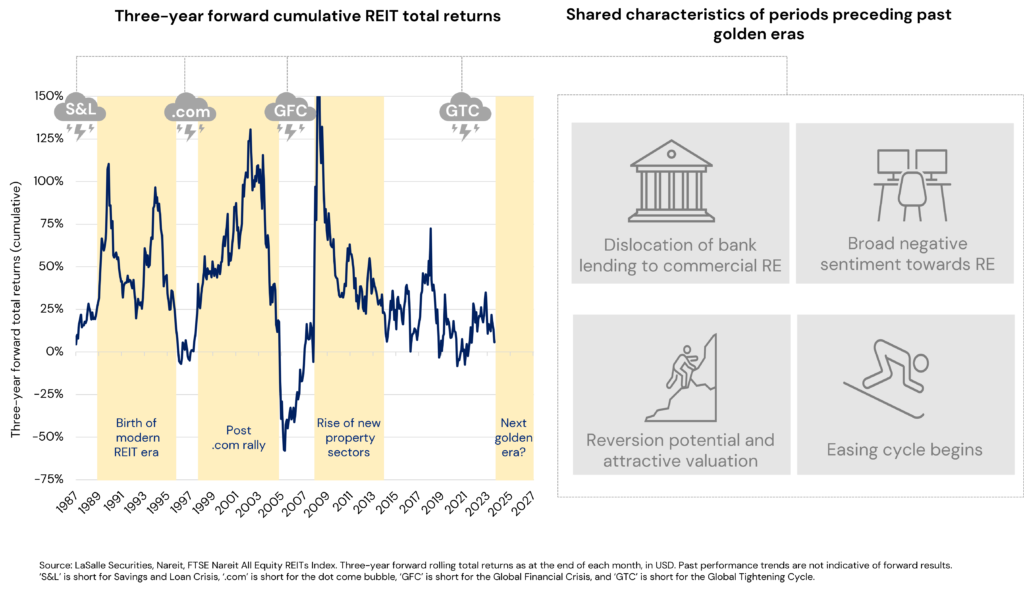
Recent history, marked by a post-pandemic recovery followed swiftly by the Great Tightening Cycle (GTC), presents important similarities to these historical periods of severe market challenges. For instance, real estate bank lending is dislocated. An AI-driven tech frenzy and fears of a generalized “commercial” real estate malaise mean REITs have underperformed compared to equities (see LMQ pg. 22). Meanwhile, signs of an easing or stabilization in financial conditions and a potential global monetary easing cycle are becoming more apparent (see LMQ pgs. 9, 10 and 30).
While history does not repeat itself, it does often rhyme. The presence of those elements in today’s market environment, and the potential for those concerns to flip to opportunities, may foretell the next REIT golden era. We discuss each of these factors in turn.

Challenged real estate lending represents an opportunity for REITs. The past two to three years have been characterized by a significant retrenchment in bank lending to real estate. According to the US Senior Loan Officer Survey (see LMQ pg. 16), the net balance between demand for loans and banks’ willingness to lend points to the widest undersupply of credit in the past ten years, except for during the depths of COVID-19. The shortage is evident in all styles of borrowing, from riskier construction loans to mortgages backed by traditional, defensive apartment assets.
This circumstance presents an opportunity for REITs given their strong financial positions and access to the capital markets. Having learned a painful lesson from the GFC, global REITs went into the GTC with their lowest leverage levels on record (see LMQ pg. 16), and nearly 90% of their debt on fixed rates and an average remaining term of seven years.2 Looking specifically at the US market, the overwhelming majority of REIT borrowing – nearly 80% – is from the unsecured market, at rates that are today almost 100 bps lower than a traditional mortgage. This relative advantage in both access and cost of capital positions REITs to potentially play the role of aggregator and to take market share.

“Commercial” real estate negativity is office-focused, but all real estate is not office. Headlines proclaiming the demise of commercial real estate usually involve a misleading generalization. Professionally managed, income-producing real estate generally should not be conflated with office specifically. It is well known that hybrid work and other factors have harmed office values. Office fundamentals are expected to remain relatively weak,3 with the sector’s growth outlook trailing nearly all other REITs globally. Office landlords will likely need to invest capital aggressively to maintain competitiveness.
These challenging office sector dynamics have unfairly cast a shadow over the broader real estate and REIT universe. In reality, office has over time become a smaller portion of the real estate landscape, especially in the public market; as of the date of this paper, only about 6% of global REITs by market capitalization are office focused (see LMQ pg. 20).4 The public market now offers a diverse sector menu comprising a wide range of dynamic sectors. These include industrial and logistics; forms of rental residential including multi- and single-family rental, manufactured housing and student housing; various formats of healthcare property; and exposure to tech-related real estate in the form of data centers and cell towers. Sectors other than office comprise the overwhelming majority of the public REIT market,5 and many of those sectors have growth outlooks that are forecast to produce earnings growth that is in line with or better than broader equities.6 That growth outlook is underpinned by a combination of secular demand drivers and declining supply levels, the other side of the higher interest rate coin.7
Media coverage naturally tends to focus on the national and trans-national arenas, but local political developments can be especially impactful for real estate investments. Such issues can fly under the radar, especially given many of the most relevant ones are only of interest to a specialist audience. For example, changes in policy around topics like the planning process, property taxes and transfer taxes (a.k.a. stamp duty) can have direct, measurable and immediate impacts on property cash flows and thus values. The distraction of the bright shiny lights of global geopolitics should not be allowed to excessively overshadow the critical local issues that impact real estate.

Underperformance may set the stage for a return to outperformance. The negativity around lending or financing concerns and the “death of office” have weighed on both the absolute and relative performance of REITs. The chart below shows the rolling one-year relative performance differential between REITs and equities; it indicates that REIT underperformance has reached its typical peak historical level before starting to reverse. Periods of underperformance have historically tended to reverse, and this instance is likely no different; indeed, the performance gap is already narrowing.
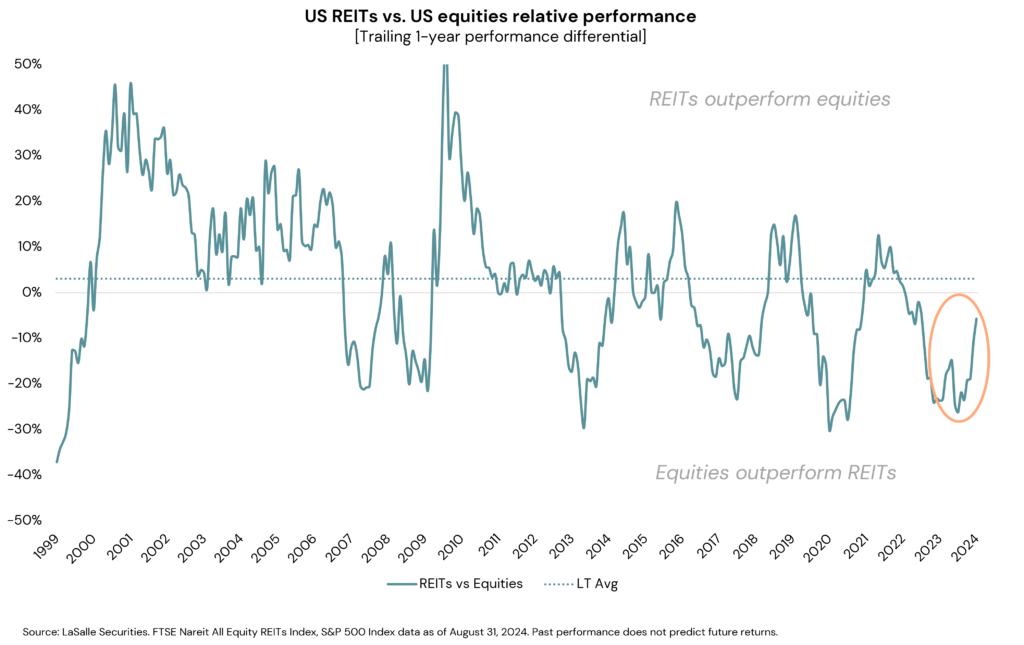

The start of a global monetary easing cycle. Real estate is a capital-intensive business that exhibits significant sensitivity to changes in financial conditions, an observation that holds for both directions of interest rate change. The downside of this dynamic was evident for much of 2022 and 2023, but the upside is likely coming into play. A global monetary easing cycle is now decidedly underway, heralded by the Fed’s 50 bps rate cut on September 18 (see LMQ pg. 31). REITs have generally performed well in periods leading up to and following a central bank easing cycle, as the chart below shows.
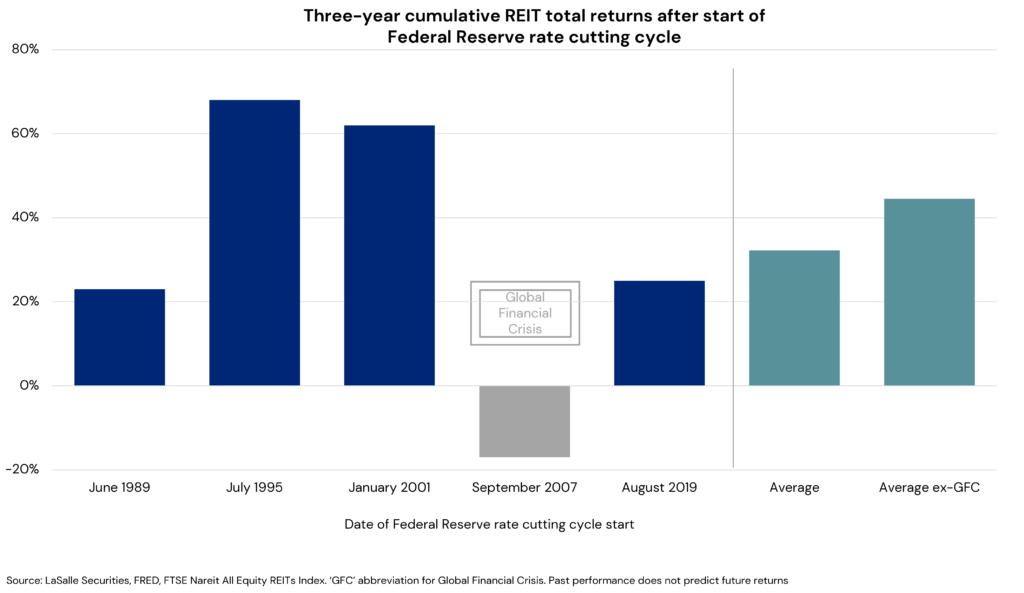
Over the past 25 years, REITs have produced total returns of 8% per annum, with 4-5 percentage points of that return coming from income. LaSalle’s base case underwriting for the next three years is for the REIT market to produce total returns of 9%, slightly above historical averages, with roughly four percentage points of that coming from income. That base case forecast incorporates today’s fundamental outlook and interest rate levels. Should any further easing in financial conditions occur, even only in the amount of 50 bps or 100 bps, those return expectations increase to 13% and 18% per annum, respectively, in line with previous “golden eras.”
Footnotes
1 This analysis based on LaSalle Securities analysis of historical macroeconomic, capital market and listed market trends. Source for the REIT performance data cited below are the FTSE Nareit indices.
2 Source for debt pricing comments in this paragraph: S&P Global Market Intelligence, Green Street Advisors, company financial releases, company research and market analysis conducted by LaSalle Securities.
3 There is considerable global variation in office performance, and there are certainly exceptions to this generalization, especially in select Asia-Pacific markets and the higher end of the European office quality spectrum. For more discussion of global office trends, see our ISA Outlook 2024 Mid-Year Update.
4 Source: LaSalle Securities. Percent of companies classified as office focused within the global listed universe defined as the constituents of the S&P Developed REIT, FTSE EPRA Nareit Developed and Nareit All Equity Indices. Sector classifications determined by LaSalle Securities.
5 As measured by market capitalization. Source: LaSalle Securities. Global listed universe defined by the constituents of the S&P Developed REIT, FTSE EPRA Nareit Developed and Nareit All Equity Indices. Sector classifications determined by LaSalle Securities.
6 As based on LaSalle Securities proprietary modelling and consensus earnings forecasts for the Bloomberg World Index, a proxy for broader equity markets.
7 Higher interest rates mean development proformas use higher exit yield assumptions and more expensive development finance. When interest rates are high, all else being equal, the rents required to justify development are higher.
8 Based on proprietary internal LaSalle Investment Management modeling of securities returns. There is no guarantee that such forecasted returns, or any other returns referred afterwards, will materialize.
This publication does not constitute an offer to sell, or the solicitation of an offer to buy, any securities or any interests in any investment products advised by, or the advisory services of, LaSalle Investment Management (together with its global investment advisory affiliates, “LaSalle”). This publication has been prepared without regard to the specific investment objectives, financial situation or particular needs of recipients and under no circumstances is this publication on its own intended to be, or serve as, investment advice. The discussions set forth in this publication are intended for informational purposes only, do not constitute investment advice and are subject to correction, completion and amendment without notice. Further, nothing herein constitutes legal or tax advice. Prior to making any investment, an investor should consult with its own investment, accounting, legal and tax advisers to independently evaluate the risks, consequences and suitability of that investment.
LaSalle has taken reasonable care to ensure that the information contained in this publication is accurate and has been obtained from reliable sources. Any opinions, forecasts, projections or other statements that are made in this publication are forward-looking statements. Although LaSalle believes that the expectations reflected in such forward-looking statements are reasonable, they do involve a number of assumptions, risks and uncertainties. Accordingly, LaSalle does not make any express or implied representation or warranty, and no responsibility is accepted with respect to the adequacy, accuracy, completeness or reasonableness of the facts, opinions, estimates, forecasts, or other information set out in this publication or any further information, written or oral notice, or other document at any time supplied in connection with this publication. LaSalle does not undertake and is under no obligation to update or keep current the information or content contained in this publication for future events. LaSalle does not accept any liability in negligence or otherwise for any loss or damage suffered by any party resulting from reliance on this publication and nothing contained herein shall be relied upon as a promise or guarantee regarding any future events or performance.
By accepting receipt of this publication, the recipient agrees not to distribute, offer or sell this publication or copies of it and agrees not to make use of the publication other than for its own general information purposes.
Copyright © LaSalle Investment Management 2024. All rights reserved. No part of this document may be reproduced by any means, whether graphically, electronically, mechanically or otherwise howsoever, including without limitation photocopying and recording on magnetic tape, or included in any information store and/or retrieval system without prior written permission of LaSalle Investment Management.
LaSalle Investment Management (“LaSalle”), the global real estate investment manager, announced today the acquisition of Buckeye85, a core industrial building located in the heart of metro Phoenix’s Interstate 10 Corridor. The acquisition was made on behalf of LaSalle Property Fund (LPF), the firm’s US core open-ended fund.

The 321,892 square foot Class A building was constructed in 2023 and is fully leased to Tempur-Pedic, a leading manufacturer of mattresses and pillows and a part of Tempur Sealy International, Inc. (NYSE: TPX). It’s situated on 20 acres at 10333 West Buckeye Road, at the southwest corner of 103rd Avenue and Buckeye Road/MC-85 Highway in Phoenix, Arizona. The property is strategically located two miles from a full-diamond interchange at I-10 and 107th Avenue, positioning it within a world-class e-commerce market that is home to companies like Amazon, McKesson, Pepsico, Kroger and Home Depot.
Jim Garvey, President and Portfolio Manager, LaSalle Property Fund said: “We are pleased to add Buckeye85 to our portfolio. Our conviction in well-located, Class A industrial assets remains strong, and we believe this acquisition will continue to support the strong relative performance of the fund.”
Matt Bogovich, Vice President of Transactions, added: “We are pleased to have acquired such a high-quality industrial asset in Phoenix. Buckeye85 stands out given its new construction, modern features, and prime location. This transaction is consistent with LPF’s objective to increase exposure to industrial properties, especially in locations with favorable supply and demand dynamics.”
LaSalle Property Fund invests in and manages a portfolio of diversified high-quality core real estate assets in major markets across the US in the industrial, multifamily, office, retail and niche sectors. Since its inception in 2010, LaSalle Property Fund has focused on creating and managing a portfolio with an emphasis on property types with strong growth potential and lesser risk of disruption from secular changes. The Fund’s assets are diversified across major and niche property sectors in major American markets, aiming to provide reliable returns.
About LaSalle Investment Management | Investing Today. For Tomorrow.
LaSalle Investment Management is one of the world’s leading real estate investment managers. On a global basis, LaSalle manages US$84.8 billion of assets in private and public real estate equity and debt investments as of Q2 2024. LaSalle’s diverse client base includes public and private pension funds, insurance companies, governments, corporations, endowments and private individuals from across the globe. LaSalle sponsors a complete range of investment vehicles, including separate accounts, open- and closed-end funds, public securities and entity-level investments. For more information please visit http://www.lasalle.com, and LinkedIn.
NOTE: This information discussed above is based on the market analysis and expectations of LaSalle and should not be relied upon by the reader as research or investment advice regarding LaSalle funds or any issuer or security in particular. The information presented herein is for illustrative and educational purposes and is not a recommendation, offer or solicitation to buy or sell any securities or to adopt any investment strategy in any jurisdiction where prohibited by law or where contrary to local law or regulation. Any such offer to invest, if made, will only be made to certain qualified investors by means of a private placement memorandum or applicable offering document and in accordance with applicable laws and regulations. Past performance is not indicative of future results, nor should any statements herein be construed as a prediction or guarantee of future results.



CHICAGO (September 17, 2024) – Elena Alschuler, LaSalle’s Americas Head of Sustainability has been recognized with the Nareit 2024 Sustainable Leadership Award on behalf of JLL Income Property Trust.
Nareit presented the inaugural Sustainability Impact Awards at its REITworks: 2024 Sustainability & Social Responsibility Conference in McLean, VA. The awards recognize REITs for implementing sustainable practices that demonstrate leadership, ingenuity, and environmental impact in the commercial real estate industry.
Elena was recognized for her leadership in sustainability in the built environment, and her collaboration with industry peers to share knowledge and develop best practices. This is exemplified in Elena’s recent role as chair for the CRREM North America Working Group which is working to develop decarbonization pathways to benchmark transition risk.

Nareit Senior Vice President of Environmental Stewardship & Sustainability, Jessica Long said: “We are excited to highlight Elena and JLL Income Property Trust who are raising the bar for advancing sustainability practices in their operations, buildings, communities, and across the broader REIT and commercial real estate industry.”
LaSalle Global Head of Climate and Carbon, Julie Manning said: “This award is a well-deserved recognition of Elena’s exceptional contributions to sustainable real estate practices. Her innovative strategies and tireless efforts have not only elevated LaSalle’s program but are also working to set new benchmarks for the entire industry. Elena’s work exemplifies our commitment to exploring sustainable solutions that can drive investment performance.”
JLL Income Property Trust, President and CEO, Allan Swaringen said: “At JLL Income Property Trust, we believe sustainability initiatives can drive value and mitigate risk. We integrate these sustainability principles in our portfolio construction, acquisitions and asset management activities, resulting in a tailored approach to each property in our portfolio. Elena has been at the forefront of driving these efforts, and this recognition by Nareit is a testament to her commitment.”
ENDS
About LaSalle Investment Management | Investing Today. For Tomorrow.
LaSalle Investment Management is one of the world’s leading real estate investment managers. On a global basis, LaSalle manages US$84.8 billion of assets in private and public real estate equity and debt investments as of Q2 2024. LaSalle’s diverse client base includes public and private pension funds, insurance companies, governments, corporations, endowments and private individuals from across the globe. LaSalle sponsors a complete range of investment vehicles, including separate accounts, open- and closed-end funds, public securities and entity-level investments.
For more information, please visit www.lasalle.com, and LinkedIn.
About JLL Income Property Trust, Inc. (NASDAQ: ZIPTAX; ZIPTMX; ZIPIAX; ZIPIMX)
JLL Income Property Trust, Inc. (NASDAQ: ZIPTAX; ZIPTMX; ZIPIAX; ZIPIMX), is a daily NAV REIT that owns and manages a diversified portfolio of high quality, income-producing apartment, industrial, grocery-anchored retail, healthcare and office properties located in the United States. JLL Income Property Trust expects to further diversify its real estate portfolio over time, including on a global basis.
About Nareit
Nareit serves as the worldwide representative voice for REITs and publicly traded real estate companies with an interest in U.S. real estate. Nareit’s members are REITs and other real estate companies throughout the world that own, operate, and finance income-producing real estate, as well as those firms and individuals who advise, study, and service those businesses. Nareit’s focus is to broaden and deepen REIT ownership to help a growing set of everyday American investors enjoy the benefits of holding real estate in a well-diversified portfolio, while increasing capital sources that invest in America’s future. Nareit is the exclusive registered trademark of the National Association of Real Estate Investment Trusts, Inc.®, 1875 I St., NW, Suite 500, Washington, DC 20006-5413. Follow us on REIT.com. Copyright© 2024 by Nareit®. All rights reserved.



A prudent person sees trouble coming and ducks.
A simpleton walks in blindly and is clobbered.
— Proverbs 22:3
King Solomon’s words of wisdom have been passed down to us for 3,000 years. They still resonate, especially in this modern translation,1 even though the “trouble” is no longer invading Assyrians or Babylonians but the type of danger we bring on ourselves through an all-too-human combination of ingenuity, hubris and ignorance.
Watch any movie from the 1930s to the 1960s and you will see actors inhaling tobacco smoke with abandon. We know better now. Like the generational awareness of the harm caused by tobacco products, real estate owners have gradually become aware of the dangers lurking in certain building materials and contaminated soil. Starting in the 1960s, societies have spent fortunes cleaning up “miracle products.” Asbestos, PCBs, dry cleaning solvents, herbicides and lead pipes were all considered state-of-the-art technologies at various points in human history. None of these inventions were designed with the intention of killing people. They all started with a noble purpose – whether suppressing catastrophic fires, insulating transformers, cleaning wool suits or producing a pleasing nicotine buzz that also curbed the appetite. The “externalities” associated with societal damage from the use of these products took decades to discover and billions to eradicate.
Greenhouse gas emissions share a common ancestry with these miracle products. Heating buildings with diesel fuels, running gas lines through city streets, producing electricity with coal-fired plants—these were all logical, economical, and sensible solutions to the problem of bringing energy to homes, businesses and buildings of all types. The industrial revolution accelerated the growth of cities and raised the quality of life for millions of people by dragging them out of rural poverty. As we now know, society’s dependence on fossil fuels creates new problems which must be dealt with.
The recognition that miracle products can carry hidden (or not so hidden) dangers follows a predictable pattern. Here is what the step-by-step process often looks like:

Evidence and awareness. An environmental problem often requires decades of scientific study and mountains of evidence to convince people that a change is necessary. Even as this evidence accumulates, vested interests organize counterattacks to convince society that the problem is non-existent or over-stated. Eventually the harm to human life becomes so obvious that denial becomes a “fringe position.”

Market demand. In many cases, the process of partial “market adjustment” can begin ahead of government action. Voluntary data collection and industry-led reforms start the slow process of change. In the case of greenhouse gases, the marginal contribution of each emitter is so small, and so embedded in society, that government interventions sometimes lag market-led shifts (e.g., the adoption of LED lighting or heat pumps).

Regulatory response. Yet, government interventions are almost always needed to accelerate and complete behavioral change to truly eliminate harm to the environment and to human life created by “externalities.” These regulations and policy responses often get pushback as competing outcomes are debated in the political arena. Economists agree that putting a price on carbon would be the most efficient and effective solution, but a market mechanism for carbon pricing requires government intervention — in the form of a carbon “tax” or to set up an emissions trading scheme.

Benchmarks and best practices. Eventually, the rise of data benchmarks and peer group comparisons begins to shed light on who, where and how successful “treatments” are applied to any environmental problem. Engineering and laboratory science helps inform this stage of the process, as does public health or industry group data. Integration with market investment processes and decisions leads to a focus on reversing years of damage to the environment and compliance with new regulations and guidelines. At this stage, market-driven and regulatory-driven changes start to converge.

Price integration. Feedback loops are established where type 1 errors (false positives) and type 2 errors (false negative—or overlooked problems) are exposed.2 In loosely regulated situations like climate change, the efficient market hypothesis (EMH) takes hold as the change process gets partially or fully priced by consumers and producers. Economists and policy analysts favor the practice of placing a “price” on an externality to compensate society for the harm. In practice, though, compensatory payments to offset environmental damage are often decided through the courts and litigation.

Continued market and regulatory evolution. The enforcement of tighter regulations also follows its own trajectory depending on the governance structure of a particular country or urban jurisdiction and the toxicity of the problem. The discipline of epidemiology, using population data and public health analysis, is especially helpful at this stage of refining the policy solutions.
The Transition from “Data” to “Wisdom”
For the de-carbonization of buildings, various markets and countries are well into Step 3 (Regulatory Response) and Step 4 (Benchmarks and Best Practices). In Europe the “theory of change” is focused more on EU-wide or national policies to promote energy disclosures through top-down regulatory solutions. In the United States, the emphasis is based more on voluntary pledges, market solutions and regulations that are based on specific local jurisdictions. In most developed countries, steps 5 (Price Integration) and 6 (Market and Regulatory Evolution) are underway, but both have a long way to go.
The rise of real estate sustainability benchmarks (like GRESB) has accelerated in recent years. In many cases, they have expanded to include social factors and tenant well-being alongside environmental metrics. The next hurdle, though, is to establish materiality tests that infuse meaning, and determine financial impacts based on the volumes of reporting that the industry has started to produce and disclose.
Reading through sustainability reports often reveals the triumph of reporting and public relations over salience or relevance. The conjoint challenges of reducing building emissions alongside improving the well-being of building users and the surrounding communities can be obscured by data denominated in less familiar metrics like tons of CO2 or Kilowatt hours. In time, and with experience, the emphasis will shift to what truly moves the needle on all elements of the “sustainable investing” paradigm—and which metrics give off misleading or meaningless “virtue” signals.
Financial metrics align most closely with the “fiduciary duty” of an investor. Moreover, stakeholders have decades of experience analyzing and interpreting financial data. It will take additional time and effort to convert environmental data into financial terms or to simply raise the consciousness of how to interpret energy and emission data in its own right. (LaSalle’s work on the “Value of Green” synthesizes studies of the evidence linking sustainability metrics and financial outcomes. An update on this work is below.)

In writing Proverbs, King Solomon gathered centuries of wisdom based on experience. In the modern world, we often believe that the steps to wisdom are built on a foundation of knowledge, information, and data. The famous “DIKW” hierarchy has been a mainstay of information sciences since the 1930s. Sustainability wisdom is still in the process of being formulated and likely requires more time to make progress. Fortunately, the foundations of this wisdom are already being put in place—first through data (the modern way to refer to many, many experiences), then information (organized and analyzed data), eventually leading to knowledge (patterns are identified and the “what” and “why” questions are answered) and finally reaching the status of accumulated wisdom (how to respond). This is a path that humans have traveled before. More lives are at stake this time around and the wisdom may not be easily agreed upon by all industries, countries and stakeholders. Nevertheless, the search for sustainability wisdom must continue and time is of the essence.
Revisiting LaSalle’s “Value of Green”
In September 2023, LaSalle published our ISA Focus report What is the value of green? Looking at the evidence linking sustainability and real estate outcomes. The report presents a framework on how sustainable attributes of properties can be viewed as both as drivers and protectors of value, along with showcasing findings from the broader literature. We continue to maintain a Value of Green tracker, monitoring research on this subject as it is produced. Some of the findings that have surfaced since the release of our initial report are worth highlighting:
Beyond the direct links between sustainability and historical investment performance in terms of return, rent and value premiums, more signals are emerging as available data on the topic grows, and becomes increasingly forward looking:
Beyond results based on backward-looking data, detailed case studies of investments into sustainable initiatives are being published. The JLL report “Future-Proof Your Investments“ showcased opportunities for sustainable New York offices; another example is CBRE’s report “The impact of on-site rooftop solar on logistics property values.”

Tobias Lindqvist
Strategist, Climate and Carbon Lead, London
Sources:
CBRE (March 2024) UK Sustainability Index Results to Q4 2023. CBRE
P. Torres, G. Bolino, P. Stepan (2024) The Green Tipping Point. JLL
T.Leahy (2022) London and Paris Offices: Green Premium Emerges. MSCI
P. Torres, J. del Alamo (July 2024) Future-proof your investments. JLL
D. Marina, J. Tromp, T. Vezyridis, O. Bruusgaard (July 2023) The impact of on-site rooftop solar PV on logistics property values. CBRE
O. Muir, Y. Chen, T. Metcalf et.al (Dec 2023) Green premium: Study of New York and London Real Estate finds strong evidence for a ‘green premium’. UBS
What can we learn from simulations?
The de-carbonization of buildings is taking place in a complex and ever-changing environment. It is a multi-dimensional problem replete with uncertain outcomes, regulatory change, shifting societal norms and markets, and the politicization of sensitive issues.
At the June 2024 MIT World Real Estate Forum, Professor Roberto Rigobon unveiled a “sustainability simulation” game patterned on his pathbreaking work on social preferences for the European Commission. The technique shows how the traditional economic conceit that we make “resource trade-offs” does not accurately capture how humans make decisions when faced with multi-dimensional choices.
In the simulation, the audience was given nine choices for different retrofit projects for a commercial building. Each choice resulted in simultaneous movement across three metrics that the audience had already established that they cared about — changes in NOI (profitability), CO2 emissions, and tenant satisfaction/well-being. The cost of the projects was amortized into the NOI calculations and the other metrics were also calibrated based on actual data from the US.
The simulation showed that a knowledgeable real estate audience rarely solves just for “pure profits” at the expense of tenant well-being or CO2 emissions. The simulation also mimicked reality—where sometimes profitability moves in synch with reduced CO2 emissions and other times it moves it moves in the opposite direction. The simulation was designed to show how the co-movement depends on the local market and the type of de-carbonization project. Tenant well-being and CO2 emissions could be implicitly linked to revenue when and if participants believe that occupancy, rents and capital raising are all interconnected.
Through their choices, the audience tried to optimize across all three priorities at once — leading to an interesting result that revealed their average willingness to “pay” to reduce a ton of CO2 emissions of about $200 ton. Yet, if asked directly how much they would pay to reduce a ton of greenhouse gas coming from a building, it seems unlikely that many would have volunteered to pay that much. This finding also shows how the language of profitability and returns is much more advanced than the metrics and concepts associated with either decarbonization or tenant satisfaction. And that all these metrics are linked, but not fully integrated in the minds of real estate professionals.
Only a few participants in the game focused only on reducing CO2 (at the expense of decent profits). And just a few focused exclusively on profitability at the expense of tenant satisfaction or CO2 emissions. This seems like a reasonable facsimile of what enlightened investors will do — especially when they know that their actions are being disclosed. As we learn more from these simulations, it is possible that policy makers will be able to refine the mix of incentives and regulations that govern the real estate industry.
Jacques Gordon
Cambridge, Massachusetts
LOOKING AHEAD >
Footnotes
1 The Message, translated from the Hebrew scriptures by Eugene Peterson (1993-2002).
2 These are all part of the learning that occurs with any “treatment hypothesis.” The science of public health provides solid evidence to weigh whether the “treatment” is helping, hurting or having no impact on the eradication of the underlying disease. In real estate, a good example of this is the gradual discovery that with certain types of asbestos, it is more dangerous to remove it than to “encapsulate” it in an existing structure. The science of “decarbonization” is still being established to determine whether, for example, the mass production of lithium batteries does as much harm as the burning of fossil fuels. For real estate and climate change, the “treatment” will likely focus on energy efficiency/ decarbonization interventions that are a combination of government penalties/incentives and voluntary actions. The effectiveness of these treatments will depend on compliance, market response, and how well interventions find acceptance through the political process.
Important Notice and Disclaimer
This publication does not constitute an offer to sell, or the solicitation of an offer to buy, any securities or any interests in any investment products advised by, or the advisory services of, LaSalle Investment Management (together with its global investment advisory affiliates, “LaSalle”). This publication has been prepared without regard to the specific investment objectives, financial situation or particular needs of recipients and under no circumstances is this publication on its own intended to be, or serve as, investment advice. The discussions set forth in this publication are intended for informational purposes only, do not constitute investment advice and are subject to correction, completion and amendment without notice. Further, nothing herein constitutes legal or tax advice. Prior to making any investment, an investor should consult with its own investment, accounting, legal and tax advisers to independently evaluate the risks, consequences and suitability of that investment.
LaSalle has taken reasonable care to ensure that the information contained in this publication is accurate and has been obtained from reliable sources. Any opinions, forecasts, projections or other statements that are made in this publication are forward-looking statements. Although LaSalle believes that the expectations reflected in such forward-looking statements are reasonable, they do involve a number of assumptions, risks and uncertainties. Accordingly, LaSalle does not make any express or implied representation or warranty, and no responsibility is accepted with respect to the adequacy, accuracy, completeness or reasonableness of the facts, opinions, estimates, forecasts, or other information set out in this publication or any further information, written or oral notice, or other document at any time supplied in connection with this publication. LaSalle does not undertake and is under no obligation to update or keep current the information or content contained in this publication for future events. LaSalle does not accept any liability in negligence or otherwise for any loss or damage suffered by any party resulting from reliance on this publication and nothing contained herein shall be relied upon as a promise or guarantee regarding any future events or performance.
By accepting receipt of this publication, the recipient agrees not to distribute, offer or sell this publication or copies of it and agrees not to make use of the publication other than for its own general information purposes.
Copyright © LaSalle Investment Management 2024. All rights reserved. No part of this document may be reproduced by any means, whether graphically, electronically, mechanically or otherwise howsoever, including without limitation photocopying and recording on magnetic tape, or included in any information store and/or retrieval system without prior written permission of LaSalle Investment Management.
This article first appeared in the September 2024 edition of PERE
LaSalle’s Isabelle Brennan sat down with peers from other leading alternative credit providers across the US to discuss the state of real estate debt across the United States.
US private lenders eye real estate opportunities as activity ramps up
With banks likely to remain on the sidelines amid regulatory changes, participants in PERE’s US debt roundtable anticipate openings to deploy capital both in refinancing and new acquisitions, Stuart Watson reports.
Over the past 18 months higher interest rates, uncertainty about property values, and questions over secular shifts in demand for some asset classes have combined to suppress activity in US commercial real estate lending markets. Meanwhile both money center and regional banks have scaled back activity in the face of concerns over the health of their balance sheets, and the expected introduction of stricter capital requirements aimed at reducing liquidity risk.
Want to read more?
This article first appeared in the Summer 2024 edition of PREA Quarterly
LaSalle’s Global Head of Research and Strategy, Brian Klinksiek, discusses how ex-US investors are viewing the US real estate market.
Foreign investors are an important—if far from dominant—source of capital for US commercial real estate. Since 2010, foreign investors have made up around 12% of total US investment activity, compared with the 30%–60% range for most other major developed markets, according to MSCI Real Capital Analytics (Exhibit 1). However, foreign investors also play a meaningful role as limited partners in funds. According to the PREA Investor Composition Survey, investors from outside the US in 2022 held nearly 18% of the NCREIF Fund Index—Open End Diversified Core Equity (NFI-ODCE) net asset value, a share that has risen steadily from less than 5% in 2012. Moreover, in some phases of the market, offshore capital has acted as the marginal buyer of certain types of real estate, giving an outsize impact on pricing.
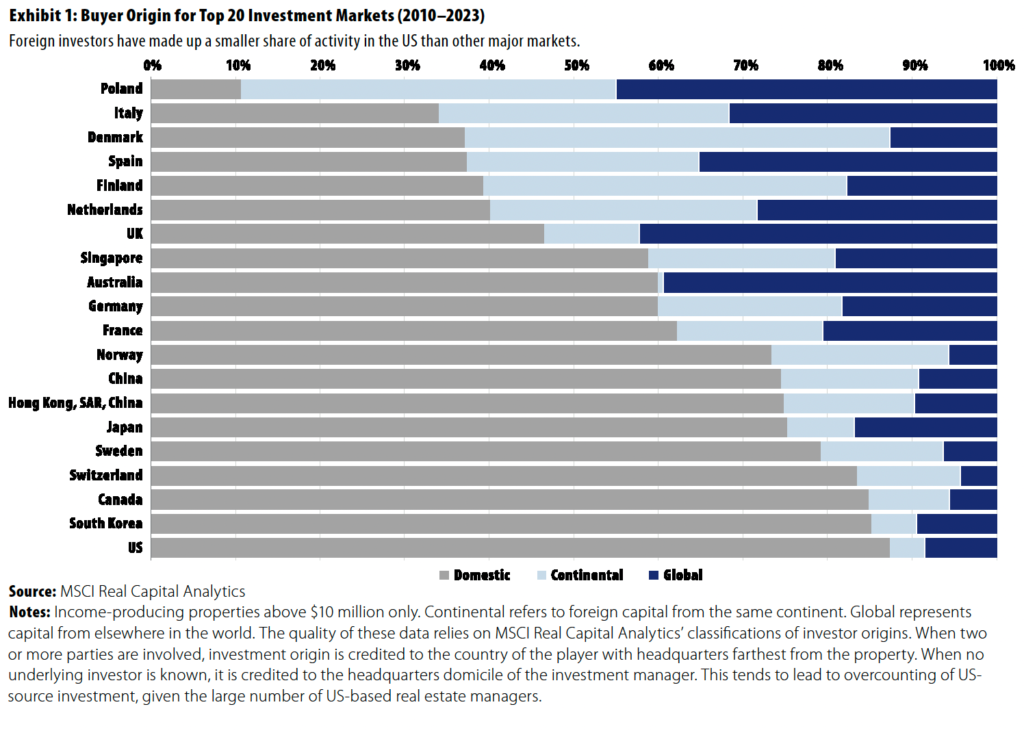
Investors broaden their real estate holdings outside their home countries for many reasons, including to diversify, expand the opportunity set, and avoid crowded capital markets at home. The drive to expand globally is especially strong for investors in countries with excess savings in the form of well-funded defined benefit pension systems (e.g., Northern Europe), mandatory retirement savings programs (superannuation in Australia), or sovereign wealth funds (many energy exporters). LaSalle has long been an advocate of “going global”; while not the focus of this article, LaSalle covers the case for global investing in its ISA Portfolio View report.
Want to read more?
Marisa Mendenhall is an Associate Vice President on the Sustainability team at LaSalle. Her duties include data management and analysis, sustainability reporting and compliance, solar analysis, and overseeing energy efficiency projects for our North American assets with other members of the Sustainability Team.
Prior to her current role, Marisa was a Manager of Sustainability Programs at RE Tech Advisors where she consulted commercial real estate owners on their sustainability programs in both the private and public sectors. Her duties included data collection and management, sustainability reporting, decarbonization prioritization, and program budget management. Marisa also has experience in business development and account management in the green technology space for buildings.
Marisa is a graduate of the University of Arizona. She also received a Certificate in Corporate Social Responsibility from the University of Colorado, Boulder.
Haya El-Merheby is a Sustainability Analyst on the Americas Sustainability Team. She focuses on data collection, quality, and reporting, working closely with properties. Haya manages key initiatives such as energy audits, green building certifications, and the roll-out of EV charging stations.
She is a graduate of the University of Waterloo with a Bachelor of Environmental Studies, majoring in Environment, Resources, and Sustainability. During her studies, she completed a year-long internship with the JLL PDS Energy and Sustainability consulting team, gaining experience in net zero carbon studies, GHG accounting projects, green building certifications, climate risk assessments, and sustainability strategy setting.
Katie Smidt is an Associate on LaSalle’s Global Sustainability team. She is responsible for the design and integration of strategic sustainability initiatives into each region to ensure consistency across our global business. Katie joined LaSalle in 2024 and has been working in the sustainability field since 2019.
Prior to LaSalle, Katie was a consultant at Longevity Partners and LORD Green Strategies, where she led the development and implementation of various sustainability projects, particularly sustainability strategy and sustainability data management, for over a dozen commercial real estate investment managers around the world.
Katie holds a Bachelor of Arts in Geography and Sociology with a focus on Sustainability from The University of Texas at Austin. She is an accredited LEED AP Operations + Maintenance and Sustainability Excellence Associate.
While traditional banks’ appetite for providing commercial real estate loans has declined, other lenders (including investment management firms such as LaSalle) have moved in to fill the funding gap. As a result, we have recently seen increasing interest from institutional investors in real estate debt.
But what is it about real estate debt that makes it a compelling investment? As the second largest of the “four quadrants” of real estate, it has a value in the US and Europe alone of approximately US $4.5 trillion, representing an enormous opportunity. Real estate debt historically has produced competitive risk-adjusted returns in addition to showing low correlation to other assets.
In our latest research, we examine the three-part case for investment, including:
Important notice and disclaimer
This publication does not constitute an offer to sell, or the solicitation of an offer to buy, any securities or any interests in any investment products advised by, or the advisory services of, LaSalle Investment Management (together with its global investment advisory affiliates, “LaSalle”). This publication has been prepared without regard to the specific investment objectives, financial situation or particular needs of recipients and under no circumstances is this publication on its own intended to be, or serve as, investment advice. The discussions set forth in this publication are intended for informational purposes only, do not constitute investment advice and are subject to correction, completion and amendment without notice. Further, nothing herein constitutes legal or tax advice. Prior to making any investment, an investor should consult with its own investment, accounting, legal and tax advisers to independently evaluate the risks, consequences and suitability of that investment.
LaSalle has taken reasonable care to ensure that the information contained in this publication is accurate and has been obtained from reliable sources. Any opinions, forecasts, projections or other statements that are made in this publication are forward-looking statements. Although LaSalle believes that the expectations reflected in such forward-looking statements are reasonable, they do involve a number of assumptions, risks and uncertainties. Accordingly, LaSalle does not make any express or implied representation or warranty, and no responsibility is accepted with respect to the adequacy, accuracy, completeness or reasonableness of the facts, opinions, estimates, forecasts, or other information set out in this publication or any further information, written or oral notice, or other document at any time supplied in connection with this publication. LaSalle does not undertake and is under no obligation to update or keep current the information or content contained in this publication for future events. LaSalle does not accept any liability in negligence or otherwise for any loss or damage suffered by any party resulting from reliance on this publication and nothing contained herein shall be relied upon as a promise or guarantee regarding any future events or performance.
By accepting receipt of this publication, the recipient agrees not to distribute, offer or sell this publication or copies of it and agrees not to make use of the publication other than for its own general information purposes.
Copyright © LaSalle Investment Management 2024. All rights reserved. No part of this document may be reproduced by any means, whether graphically, electronically, mechanically or otherwise howsoever, including without limitation photocopying and recording on magnetic tape, or included in any information store and/or retrieval system without prior written permission of LaSalle Investment Management.
Chicago (July 9, 2024) – LaSalle Investment Management (“LaSalle”), the global real estate investment manager, today announced that it has promoted Kyle Dupree to Head of Asset Management and Pat Pelling to Head of Transactions. Both are long-time LaSalle veterans who will report to Brad Gries, Head of Americas, in their new roles.

As Head of Asset Management, Kyle brings a wealth of experience executing asset-level strategies, honed through his years of experience on the asset management team. Having joined the firm in 2010, Kyle has demonstrated exceptional growth and leadership, and will be responsible for leading asset management initiatives and processes across various property sectors. He also provides strategic leadership for digital enterprise applications and spearheads the valuation process for U.S. private equity. Kyle is based in LaSalle’s San Diego office.
Pat works out of LaSalle’s New York office, and succeeds Brad as Head of Transactions. Pat has an impressive track record of success at the firm, with over 15 years of experience in both asset management and transactions positions. Most recently, Pat has been a key leader with the transactions group – sourcing, underwriting, and executing new investments. He has also served as a thought leader, driving new, strategic investment initiatives, programmatic partnerships and cultivating key relationships.
Brad Gries, Head of Americas at LaSalle Investment Management, commented: “These promotions highlight LaSalle’s continued focus on strategic leadership succession and our desire to foster the growth of talented people within our firm. Both Kyle and Pat are exceptionally good at what they do, and we are proud to welcome them into these leadership roles.”
ENDS
About LaSalle Investment Management | Investing Today. For Tomorrow.
LLaSalle Investment Management is one of the world’s leading real estate investment managers. On a global basis, LaSalle manages approximately US $87 billion of assets in private and public real estate equity and debt investments as of Q1 2024. LaSalle’s diverse client base includes public and private pension funds, insurance companies, governments, corporations, endowments and private individuals from across the globe. LaSalle sponsors a complete range of investment vehicles including separate accounts, open- and closed-end funds, public securities and entity-level investments. For more information please visit www.lasalle.com, and LinkedIn.
NOTE: This information discussed above is based on the market analysis and expectations of LaSalle and should not be relied upon by the reader as research or investment advice regarding LaSalle funds or any issuer or security in particular. The information presented herein is for illustrative and educational purposes and is not a recommendation, offer or solicitation to buy or sell any securities or to adopt any investment strategy in any jurisdiction where prohibited by law or where contrary to local law or regulation. Any such offer to invest, if made, will only be made to certain qualified investors by means of a private placement memorandum or applicable offering document and in accordance with applicable laws and regulations. Past performance is not indicative of future results, nor should any statements herein be construed as a prediction or guarantee of future results.



“You take the blue pill—the story ends, you wake up in your bed and believe whatever you want to believe. You take the red pill… all I’m offering is the truth.”
– Morpheus to Neo, The Matrix (1999)
We published the global chapter of the ISA Outlook 2024 on November 14, 2023, just before euphoria about a potential ‘V’-shaped property market turnaround emerged. Interest rates fell quickly as financial markets priced in several US Federal Reserve (Fed) rate cuts in 2024. For a time, it looked as though our prediction that it would take a little longer for markets to digest a renewed spike in rates would not age well.
In this Mid-Year Update, however, we look back to find an outlook with an uncanny resemblance to that of six months ago. This is not because nothing has changed, but because the mood has gone full circle. The landscape remains characterized by interest rate volatility, soft fundamentals in some markets, and gaping quality divides, but also by pockets of considerable strength. Another factor that has not changed is that financial conditions (i.e., interest rates) remain the dominant driver of the market, and that political and geopolitical uncertainties are in focus in many countries (see LaSalle Macro Quarterly, or LMQ, pages 4-6).1
In this report, we discuss five themes we see driving real estate markets for the rest of 2024 and beyond. At our European Investor Summit in May, our colleague Dan Mahoney argued that—like Neo in the Matrix—we should take the red pill and endeavor to see the market as it is, not as we’d like it to be. Taking the red pill requires a realistic view on property values. It reveals as unlikely a return to an environment of ultra-low interest rates or uniformly benign fundamentals in the “winning” sectors.
But it does not mean that there will not be attractive investment opportunities. Unlike the bleak dystopia of The Matrix, there are many reasons for optimism, as well as signs that the coming months will come to be seen as a favorable investment vintage. That said, investing successfully will require a balance of big-picture perspective and granular discernment, and a mix of patience and willingness to take risk.
Over the past year, we likened the interest rate path in most markets to a strenuous mountain trek: the relentless climb (2022), the range-bound altitude of an alpine ridge line (H1 2023), the unexpected upward turn in the trail (Q3 2023), and the mountain meadow of cooling inflation and expected rate cuts (Q1 2024). More recently, there have been upward turns in the interest rates trail whenever there have been signs of sticky inflation in the US and other key countries.

One thing is for sure: No map exists for this trail. While interest rates have big consequences for real estate capital markets, they are extremely difficult to predict. We continue to caution investors against overconfidence in their ability to forecast the path of long-term interest rates.
Mercifully, falling rates are not a necessary condition for a robust recovery in real estate transaction activity. Despite interest rates remaining elevated, property markets are already showing signs of finding their footing, such as renewed US CMBS issuance and resilient deal volumes in many markets and sectors.2 A key reason for this is that wherever interest rates have spiked over the past two and half years, especially Europe and North America,3 real estate prices have by now adjusted downward significantly. The relativities between expected returns for real estate and those for other asset classes now look more appropriate than they have in many months; in other words, more of the market is at or near fair value.4
That said, while lower rates are not necessary for real estate capital market normalization, greater stability in rates than we have been seeing would no doubt help. Interest rate volatility is the enemy of a smoothly functioning private real estate transaction market. Excessive movement in borrowing costs during due diligence periods can lead to dropped deals and re-trades. Moreover, when rates are volatile, the conclusions of fair value models are also volatile, impacting both buyers’ and sellers’ assessments of appropriate pricing. Looking at recent trends in the MOVE index,5,6 interest rate volatility appears to be gradually easing but is still elevated relative to recent history (see LMQ page 13).
Increasing stability in rates is welcome, but for now it is reasonable to expect continued strains in real estate capital markets that create both challenges and opportunities. Such conditions can represent favorable entry points for debt investors (lenders), distressed equity players and core investors seeking entry points below replacement
Over the past half-year, interest rates have been increasingly influenced by widening divergences between near-term growth, inflation and monetary and fiscal policy outlooks. Most notably, the bond yield gap between the US and other markets, especially the eurozone, has widened. US growth and inflation have surprised on the upside, in the face of softening or stability elsewhere. Markets currently expect only one Fed rate cut in 2024, down from up to four earlier in the year.7 Meanwhile, in early June the Bank of Canada became the first G7 central bank to cut rates since the great tightening cycle began, with the European Central Bank (ECB) following shortly after (see LMQ page 7).
Regional groupings can obscure divergences within them. The key driver of eurozone softness is Germany (see LMQ page 23), owing to its reliance on manufacturing exports and past dependance on Russian energy. Meanwhile, the Spanish economy remains strong due to healthy consumption and tourism. Within North America, Canada’s economy is underperforming the US because the structure of its residential mortgage market makes it more exposed to higher rates.8 These intra-regional variations may have a range of impacts on property markets, for example by shifting the relative short-term prospects for demand and value.
Japan and China represent long-standing divergences that persist.9 In China, a loosening bias remains in effect as inflation hovers at around 0%.10 In Japan, monetary policy is gradually normalizing, but so far without triggering a big increase in interest rates (at least compared to elsewhere). In March, the Bank of Japan (BOJ) abandoned negative interest rates and ended most unorthodox monetary policies, though it has since held policy interest rates at around zero. Japan’s economy becoming more “normal” is generally a positive, but interest rate differentials have pushed the yen to a 34-year low against the US dollar (see LMQ page 14), creating upside risks to inflation.11 But notably, Japan remains the one major global market in which real estate leverage remains broadly accretive to going-in yields.
Aside from reinforcing the potential benefits of diversification, what do these divergences mean for investors? Mechanically, any unexpected relative softening of interest rates should, all else equal, be beneficial for relative value assessments of real estate in that market. But firmer rates in the US have predictably come alongside a stronger US dollar. This points to practical limits to global monetary policy divergences; central bankers are keenly aware that weaker currencies come with inflationary risks. Moreover, it is worth asking how persistent macro divergences will be; current divergences are rooted in timing differences of expected rate cuts, rather than an anticipated permanent disconnect.
For several years, secular themes and structural shocks have dominated the trajectories of global property markets. But there is a clear cyclical pattern reemerging in the form of a pronounced upswing in vacancy across global logistics markets, and in US apartments. The return of cyclicality in those favored sectors is having significant impacts on their near-term prospects.
The softening trend is not new. In the ISA Outlook 2024, we identified hot sectors “coming off the boil.” Part of this was down to normalizing demand levels, but elevated new supply was also a key driver. As expected, the softening we observed has continued to deepen, leading to outright rent declines in certain markets, especially for apartments in US sunbelt metros.
Softening fundamentals are not to be ignored, but we recommend investors to have the conviction to “ride the wave” of excess supply. Wide variation in supply levels at the market and submarket level means that investors with granular market data and the discipline to incorporate it into their market targeting processes should be positioned to select the most attractive markets and submarkets.

Moreover, the forces that create cycles sow the seeds of their own reversal; we expect the current supply wave to moderate soon, as evidenced by sharply falling construction starts (see LMQ page 25). Many of the projects being completed today broke ground when credible exit cap rate assumptions were several hundred basis points lower than today. Higher interest rates upended development economics; far fewer new developments can now be justified on today’s mix of land prices, construction costs and financial conditions.
Finally, investors should be prepared to think about cash flows in both real and nominal terms. When cooling nominal rental growth comes alongside cooling inflation, as it does today, it is possible for that to be consistent with solid real rental growth, depending on the relative magnitude of each.
Beyond the reassertion of supply cycles in some markets, there is an evolving mix of secular stories that deserve attention. Some of these are so long-standing that they could almost be considered constants. These include structural shortages of housing in most of Europe, Canada and Australia, as well as the widespread changing definition of core real estate in favor of more operational niche sectors and sub-types.12 We continue to be strong advocates for investment in undersupplied living sectors, and for participating in the institutionalization and growth of niche sub-sectors such as single-family rental (SFR) and industrial outdoor storage (IOS).
More dynamic themes that deserve a closer look include the stabilization of retail real estate and divergent office investment prospects:
Other key secular themes driving investment opportunities today include the implications of artificial intelligence (AI) adoption for data center demand, student mobility for student accommodation in Europe and Australia and aging for senior housing.
Past experience of real estate cycles suggests that the best investment opportunities tend to arise in periods marked by significant uncertainty, volatility and pessimism, but also when early signs of improvement and stabilization are present—in other words, moments similar to today’s environment. Experience also reinforces that it is nearly impossible to time the market, so it is best to be selectively active throughout the cycle. By the time the “all clear” signal is sounded after a market crisis, it is too late to achieve the best risk-adjusted returns.
That said, “red pill” thinking means we must recognize that the coming capital market rebound is unlikely to be as sharp as it was after the Global Financial Crisis (GFC), given that central banks are unlikely to usher in ultra-loose policy. Seeing the market as it is requires accepting the likelihood that interest rates could remain sticky, and a realistic view of near-term fundamentals as a wave of supply impacts some sectors.
Footnotes
1 Also see our ISA Briefing, “Elections everywhere, all at once: Geopolitics and risk”, April 2024. In that note, we highlighted the various sources of political uncertainty this year and outlined how we recommend investors consider these risks. At the time of writing, political developments are particularly salient for short-term movements markets in France and the UK, given elections that have been called in those countries.
2 Source: MSCI Real Capital Analytics and Trepp
3 Japan and China are key exceptions that we cover in greater depth under the “deciphering divergence” header.
4 Of course, there is considerable variation embedded in this and any assessment of fair value. As always, the devil is in the detail on the assumptions that go into expected and required returns; at LaSalle, specific fair value inputs and conclusions remain a proprietary output.
5 The Merrill Lynch Option Volatility Estimate (MOVE) is a market-implied measure of volatility in the market for US Treasuries. It calculates options prices to reflect the expectations of market participants on future volatility. Observation made as of June 24, 2024.
6 Source: Bloomberg as of June 26, 2024.
7 For more discussion of the Canada-US divergence and the consequences of mortgage rate resets, see our ISA Briefing, ”The impact of residential mortgage resets”.
8 For more detailed discussion of the unique factors in the Japanese and Chinese macro environment, see our ISA Briefing, “Key economic questions for China and Japan”.
9 Source: Oxford Economics; Gavekal Dragonomics as of June 26, 2024.
10 Economic theory suggest that weak currency may contribute to inflationary forces because it pushes up the cost of imported goods.
11 See our PREA Quarterly article on “The Changing Definition of Core Real Estate” for a discussion of how the characteristics considered desirable in core properties is moving from traditional metrics like lease length, to observed qualities like the stability of cash flows. This shift elevates the appeal of niche sectors sub-sectors versus traditional sectors such as conventional office.
12 See our ISA Focus report “Revisiting the future of office”, published March 2023.
Important notice and disclaimer
This publication does not constitute an offer to sell, or the solicitation of an offer to buy, any securities or any interests in any investment products advised by, or the advisory services of, LaSalle Investment Management (together with its global investment advisory affiliates, “LaSalle”). This publication has been prepared without regard to the specific investment objectives, financial situation or particular needs of recipients and under no circumstances is this publication on its own intended to be, or serve as, investment advice. The discussions set forth in this publication are intended for informational purposes only, do not constitute investment advice and are subject to correction, completion and amendment without notice. Further, nothing herein constitutes legal or tax advice. Prior to making any investment, an investor should consult with its own investment, accounting, legal and tax advisers to independently evaluate the risks, consequences and suitability of that investment.
LaSalle has taken reasonable care to ensure that the information contained in this publication is accurate and has been obtained from reliable sources. Any opinions, forecasts, projections or other statements that are made in this publication are forward-looking statements. Although LaSalle believes that the expectations reflected in such forward-looking statements are reasonable, they do involve a number of assumptions, risks and uncertainties. Accordingly, LaSalle does not make any express or implied representation or warranty, and no responsibility is accepted with respect to the adequacy, accuracy, completeness or reasonableness of the facts, opinions, estimates, forecasts, or other information set out in this publication or any further information, written or oral notice, or other document at any time supplied in connection with this publication. LaSalle does not undertake and is under no obligation to update or keep current the information or content contained in this publication for future events. LaSalle does not accept any liability in negligence or otherwise for any loss or damage suffered by any party resulting from reliance on this publication and nothing contained herein shall be relied upon as a promise or guarantee regarding any future events or performance.
By accepting receipt of this publication, the recipient agrees not to distribute, offer or sell this publication or copies of it and agrees not to make use of the publication other than for its own general information purposes.
Copyright © LaSalle Investment Management 2024. All rights reserved. No part of this document may be reproduced by any means, whether graphically, electronically, mechanically or otherwise howsoever, including without limitation photocopying and recording on magnetic tape, or included in any information store and/or retrieval system without prior written permission of LaSalle Investment Management.
This article first appeared in the July-August 2024 edition of IREI (subscription required)
What the data tells you and what it does not
Chase McWhorter, Institutional Real Estate, Inc.’s managing director, Americas, recently spoke with Elena Alschuler, Head of Sustainability, Americas and Julie Manning, Global Head of Climate and Carbon at LaSalle, to examine the regional differences in interpreting physical climate-risk data. Their interview is published in the July/August issue of Institutional Real Estate Americas where they delve into the implications of climate migration on investors. The discussion sheds light on how investors incorporate climate-risk data into their investment decision-making processes.
Want to read more?
Chicago (June 3, 2024) – LaSalle Investment Management (“LaSalle”), the global real estate investment manager, today announced that Brad Gries has been named Head of the Americas. Brad, who previously served as Co-Head of the Americas, will retain his position as Chair of the LaSalle Americas Investment Committee, resume his role as Co-Chief Investment Officer for LaSalle Americas and maintain his role as part of the Global Management Committee.
As Head of the Americas, Brad will oversee all personnel, operational, and investment management activities across the region for LaSalle. As Co-Chief Investment Officer, Brad’s focus will be on setting investment strategy and execution for the firm, continue to be an active participant in the firm’s capital raising efforts as well as direct involvement in the formation and execution of joint ventures and large portfolio transactions. Kristy Heuberger, who was formerly Co-Head of the Americas, will be leaving LaSalle this summer to pursue new opportunities.
Brad has had a successful career at LaSalle since joining the firm in 2017 to lead the US Transactions team. In 2019, Brad also took on the role of Co-Chief Investment Officer for the Americas to help direct investment strategy and was appointed Co-Head of the Americas in 2021.
Prior to joining LaSalle, Brad held multiple leadership positions over 16 years at the real estate investment arm of DWS, most recently serving as Managing Director, Real Estate Transactions. In that role, he led the acquisition team responsible for new investment initiatives in the Central and Southeastern United States, including investments in all property types and across the risk spectrum.
Brad Gries, Head of Americas at LaSalle Investment Management, commented: “I am excited to continue leading our highly talented team, building on the great results we have achieved in the Americas. Kristy has been an incredible partner and it has been an honor to have worked closely with her over the past several years. I wish her the best in this next phase of her successful career.”
Mark Gabbay, Global Chief Executive Officer at LaSalle Investment Management, added: “We thank Kristy for her contributions in advancing our Americas platform over the past nine years and wish her the best in her next chapter. We have deep conviction in the Americas team under Brad’s leadership to continue delivering optimal outcomes for our investors and stakeholders and further propel the growth and development of our Americas business.”
ENDS
About LaSalle Investment Management | Investing Today. For Tomorrow.
LaSalle Investment Management is one of the world’s leading real estate investment managers. On a global basis, LaSalle manages approximately US $87 billion of assets in private and public real estate equity and debt investments as of Q1 2024. LaSalle’s diverse client base includes public and private pension funds, insurance companies, governments, corporations, endowments and private individuals from across the globe. LaSalle sponsors a complete range of investment vehicles including separate accounts, open- and closed-end funds, public securities and entity-level investments. For more information please visit www.lasalle.com, and LinkedIn.
NOTE: This information discussed above is based on the market analysis and expectations of LaSalle and should not be relied upon by the reader as research or investment advice regarding LaSalle funds or any issuer or security in particular. The information presented herein is for illustrative and educational purposes and is not a recommendation, offer or solicitation to buy or sell any securities or to adopt any investment strategy in any jurisdiction where prohibited by law or where contrary to local law or regulation. Any such offer to invest, if made, will only be made to certain qualified investors by means of a private placement memorandum or applicable offering document and in accordance with applicable laws and regulations. Past performance is not indicative of future results, nor should any statements herein be construed as a prediction or guarantee of future results.



Among the many fulfilling aspects of my work, the best moments come from witnessing the tangible impact of my analyses and the utility of the tools I create for my colleagues and the company at large.
Before I joined LaSalle, I was employed as a Research Associate at University College London (UCL), on a large project for international trade when the itch for a new professional challenge began. When I saw a LinkedIn posting for a position within LaSalle’s Research team, I researched the company and was very impressed. I decided to apply for the position. This marked the beginning of an enlightening decade-long journey with the company.
I began as an Associate armed with quantitative knowledge and the drive to learn, heading into an unfamiliar industry. The initial years were a steep climb, replete with new terms and immense learning. My role evolved from undertaking research assignments to contributing to company-wide projects. Today, I work with the North America Research, Asset Management, Portfolio Teams and IC, endeavoring to understand the blueprint of our investment performance, as well as supporting the deployment of existing and new investment strategies.
Among the many fulfilling aspects of my work, the best moments come from witnessing the tangible impact of my analyses and the utility of the tools I create for my colleagues and the company at large. The sense of contribution, collaboration and participation in the company’s success is immensely gratifying.
One defining moment that stands out has been my move to the US. It was a step that expanded my boundaries, placing me far from my comfort zone. It gave me the opportunity to connect with colleagues in crucial North American positions and contribute to significant business initiatives. The experience significantly heightened my confidence and reaffirmed my value as a professional.
Looking back, my career path has been marked by two transformative crossroads that significantly shaped my professional and personal trajectory. Initially, I worked as a Civil Environmental Engineer in an urban planning role in Italy. A desire for wider horizons led me to resign from that position and spend a few months in the US during my PhD studies, a move that eventually saw me relocating to the UK. There, I shifted gears into quantitative research in international trade at UCL. The final and most precipitous change came when I seized the opportunity to join LaSalle. This represented a new chapter in my career, diversifying my path yet retaining the same foundational elements. While these roles seem disparate, they all revolved around a common denominator – my passion for deciphering the complexities of the world through data and models, my desire for new knowledge, and the rewarding experiences I’ve gained from collaboration with innovative, talented individuals and industry-leading organizations.
Over the last several years, we have seen an increase in the number of institutional investors around the world interested in adding real estate debt to their portfolios.1 In some instances, this is to replace an allocation to traditional fixed income, while in others it is both an enhancement and a way to further diversify their current level of real estate holdings.
Real estate debt versus traditional fixed income
Real estate debt differs from traditional fixed income investments in a variety of ways, primarily through collateralization, income generation, differing risk factors, the potential for securitization and its direct relationship to underlying real estate assets. In the same way that investors looking for reliable income streams and relative stability across a number of fixed income products such as government bonds or corporate credit, they can also turn to real estate debt investments.
One key differentiator for the asset class is that it is typically secured by tangible collateral in the form of real estate. Further, real estate credit investments benefit from attractive positions within a capital structure, benefitting from a subordinated first-loss position from equity, and also from negative control structures which give lenders an ability to proactively protect capital in a downside scenario. In contrast, traditional fixed income investments such as corporate or government bonds are usually unsecured and rely solely on the creditworthiness of the issuer.
For many institutional investors, income generation is a key objective and something that real estate debt investments can generate primarily through interest payments on the loan. These interest payments are often higher than on traditional fixed income investments such as sovereign or investment-grade corporate bonds. Additionally, real estate debt may also offer the potential for additional income through loan origination and exit fees, or in some instances, profit participation. Like other investments in any asset class, real estate assets are subject to market fluctuations and economic cycles. There are, however, additional property-specific risks that investors should take into consideration. These include factors such as underlying occupancy and cash-flow drivers as well as capital markets. Investors should also consider the wider macroeconomic and credit-risk considerations that investors in listed fixed income must factor into their decision making. Lending against property embeds the possibility of active takeovers, also known as workouts, requiring hands-on asset management expertise.
In some instances, real estate debt can be securitized, meaning loans are packaged together and sold as securities in the market. This allows investors to gain exposure to real estate debt through mortgage-backed securities (MBS) or collateralized debt obligations (CDOs). Traditional fixed income investments, on the other hand, are typically traded as individual bonds or included in bond funds.
Lastly, real estate debt investments are directly tied to specific properties or real estate platforms. The performance of the underlying property and its cash flows can impact the value of the debt, along with a borrower’s ability to repay it. Traditional fixed income investments are generally linked to the creditworthiness and financial health of the issuer, without a direct connection to specific underlying assets.
So why should institutional investors consider real estate debt?
As with any other asset class, real estate debt has its own unique set of attributes which, as part of a diversified, risk-adjusted portfolio, may provide investors with compelling reasons to include it within their overall strategy.
Key benefits may include:
As always, it’s important that real estate debt, like any other asset class, is considered as a component part of an overall portfolio of investments constructed with the underlying objectives of the investor in mind. When properly integrated into a portfolio, real estate debt investments have the potential to offer institutional investors the opportunity to generate stable income, diversify their portfolios, align their investments with long-term liabilities, protect against inflation, target attractive risk-adjusted returns and, in some cases, adhere to regulatory requirements.
Understanding the capital structure
The term “capital structure” in real estate investment is used to represent layers of debt and equity within an investment structure, each with its own risk-return profile and repayment priority. Investors choose a position in the structure based on risk appetite, desired returns and level of control or ownership in the investment. LaSalle invests across all layers of the capital structure.
Common equity represents an ownership stake of the property. These investors bear the highest risk but also have the potential for the highest returns. They participate in the property’s cash flows and profit distributions only after others have been paid. They have the greatest exposure to the property’s performance and value appreciation but also face the greatest risk during market downturns or property underperformance.
Preferred equity represents a hybrid investment between debt and equity. These investors provide capital to the project but have a higher claim on profits and cash flows than common equity holders. They enjoy a priority in distribution but still hold a subordinate position to debt holders. They often receive a fixed return, similar to interest on debt, and may also have upside potential linked to a property’s appreciation in value.
Mezzanine debt sits between senior debt and equity in the capital structure. Mezzanine lenders provide loans that have secondary priority in terms of repayment but carry a higher risk profile compared to senior debt. As a result, they tend to offer higher interest rates or additional equity-like features to compensate for the increased risk.
Senior debt occupies the most senior position in the capital structure and has the highest priority for repayment in case of default or enforcement. Lenders providing senior loans hold the first lien on the property, meaning they have the first claim to cash flows and proceeds in the event of liquidation and are usually secured by asset level security. Typically, senior debt offers lower yields compared to other subordinated positions within the capital structure due to its lower risk profile.
1 INREV Investment Intentions Survey, 2017 – 2024
This publication does not constitute an offer to sell, or the solicitation of an offer to buy, any securities or any interests in any investment products advised by, or the advisory services of, LaSalle Investment Management (together with its global investment advisory affiliates, “LaSalle”). This publication has been prepared without regard to the specific investment objectives, financial situation or particular needs of recipients and under no circumstances is this publication on its own intended to be, or serve as, investment advice. The discussions set forth in this publication are intended for informational purposes only, do not constitute investment advice and are subject to correction, completion and amendment without notice. Further, nothing herein constitutes legal or tax advice. Prior to making any investment, an investor should consult with its own investment, accounting, legal and tax advisers to independently evaluate the risks, consequences and suitability of that investment. LaSalle has taken reasonable care to ensure that the information contained in this publication is accurate and has been obtained from reliable sources. Any opinions, forecasts, projections or other statements that are made in this publication are forward-looking statements. Although LaSalle believes that the expectations reflected in such forward-looking statements are reasonable, they do involve a number of assumptions, risks and uncertainties. Accordingly, LaSalle does not make any express or implied representation or warranty and no responsibility is accepted with respect to the adequacy, accuracy, completeness or reasonableness of the facts, opinions, estimates, forecasts, or other information set out in this publication or any further information, written or oral notice, or other document at any time supplied in connection with this publication. LaSalle does not undertake and is under no obligation to update or keep current the information or content contained in this publication for future events. LaSalle does not accept any liability in negligence or otherwise for any loss or damage suffered by any party resulting from reliance on this publication and nothing contained herein shall be relied upon as a promise or guarantee regarding any future events or performance. By accepting receipt of this publication, the recipient agrees not to distribute, offer or sell this publication or copies of it and agrees not to make use of the publication other than for its own general information purposes.
Copyright © LaSalle Investment Management 2024. All rights reserved. No part of this document may be reproduced by any means, whether graphically, electronically, mechanically or otherwise howsoever, including without limitation photocopying and recording on magnetic tape, or included in any information store and/or retrieval system without prior written permission of LaSalle Investment Management. GL001731MAY25
Michael Fraidakis is LaSalle’s Chief Investment Officer for Canada. He leads fund management responsibilities for all Canadian mandates and plays a primary role developing new investment strategies and associated capital raising. Michael is also Fund Manager of LaSalle Canada Property Fund.
Prior to joining LaSalle, Michael served as Managing Director, Head of Canadian Investments at BGO where he was responsible for the development and execution of investment strategies across all clients, funds, markets and sectors. He also previously held positions at Beutel Goodman Real Estate Group and the Cadillac Fairview Corporation. Michael began his real estate career in 1997 and has a wide range of multi-functional leadership experience across all asset classes and markets in Canada. Throughout his tenure, he has completed over C$20 billion in transactions.
Michael earned a Master of Business Administration in Finance and Real Property Development from the Schulich School of Business and a Bachelor of Administrative Studies (Honours) in Accounting and Finance from York University.
Toronto (May 6, 2024) – LaSalle Investment Management (“LaSalle”), the global real estate investment manager, has appointed Michael Fraidakis as Head of Alternative Investment Strategies and Chief Investment Officer, Canada, strengthening the firm’s senior team in the region. He will lead LaSalle’s existing flagship value-add fund series in Canada and play a primary role developing new investment strategies and associated capital raising.
Michael is an industry veteran with 27 years of multi-functional leadership experience across all real estate asset classes and markets in Canada reflecting over C$20 billion in completed transactions throughout his career. He joins LaSalle from BGO, where he was most recently Managing Director, Head of Canadian Investments, responsible for the development and execution of investment strategies across all clients, funds, markets, and sectors. Michael began his career at BGO as an analyst in 2002, and over the years established himself as the company’s lead underwriter in Canada. Michael led multiple growth initiatives including product and business development as well as growing the firm’s programmatic partnerships. Prior to BGO, Michael held roles in finance at Beutel Goodman Real Estate Group and the Cadillac Fairview Corporation.
As part of this newly created role, Michael will assume the responsibilities of Chris Lawrence, Head of Value-Add Strategies, Canada, who is set to retire in June this year. Michael joined LaSalle on April 15 and reports to John McKinlay, CEO of LaSalle Canada, in the firm’s Toronto office.
John McKinlay, CEO of LaSalle Canada, said: “We are proud to welcome Michael to the firm as we continue to scale our investments across Canada and especially as alternative property classes grow increasingly important to our institutional clients. By leveraging his extensive industry relationships and expanding relationships both domestically and abroad we will further strengthen our position in the market. His deep understanding of Canada’s real estate markets and inveterate experience driving growth initiatives and portfolio strategy is a great enhancement to our team.”
Michael holds a Master of Business Administration in finance and real property development from the Schulich School of Business, and a Bachelor of Administrative Studies (Honours) in accounting and finance from York University.
ENDS
About LaSalle Investment Management | Investing Today. For Tomorrow.
LaSalle Investment Management is one of the world’s leading real estate investment managers. On a global basis, LaSalle manages over US $89 billion of assets in private and public real estate equity and debt investments as of Q4 2023. LaSalle’s diverse client base includes public and private pension funds, insurance companies, governments, corporations, endowments and private individuals from across the globe. LaSalle sponsors a complete range of investment vehicles including separate accounts, open- and closed-end funds, public securities and entity-level investments. For more information please visit www.lasalle.com, and LinkedIn.
NOTE: This information discussed above is based on the market analysis and expectations of LaSalle and should not be relied upon by the reader as research or investment advice regarding LaSalle funds or any issuer or security in particular. The information presented herein is for illustrative and educational purposes and is not a recommendation, offer or solicitation to buy or sell any securities or to adopt any investment strategy in any jurisdiction where prohibited by law or where contrary to local law or regulation. Any such offer to invest, if made, will only be made to certain qualified investors by means of a private placement memorandum or applicable offering document and in accordance with applicable laws and regulations. Past performance is not indicative of future results, nor should any statements herein be construed as a prediction or guarantee of future results.



Isabelle Brennan rejoined LaSalle as a Senior Managing Director in 2024, having previously worked within the Investor Relations team between 2015 and 2017. As Product Specialist – Credit and Global Solutions, she works with clients on a global basis to drive capital raising efforts in these verticals, as well as ensuring that LaSalle’s strategies meet investor needs. She is a member of the Investor Relations Management Board.
Prior to joining LaSalle, Isabelle held similar roles across the Credit and Indirect platforms at CBRE IM and M&G Investments, with responsibility for capital raising and investor relations across these channels globally. Earlier in her career, Isabelle worked within the Indirect and Fund of Funds Investment teams at Henderson Global Investors, now Nuveen (EMEA) and Prupim, now M&G Real Estate (Global), underwriting, investing and managing multi-manager investments on behalf of global clients.
Isabelle received her Bachelor’s degree from Monash University, Melbourne, and holds an Master of Science in Real Estate from Cass Business School, London. She also holds UK qualifications in Psychology and Law. She is active across industry organizations, sitting on the INREV debt working group, and as Treasurer of the Cambridge Land Economy Advisory Board (CLEAB).
Chicago (April 29, 2024) – LaSalle Investment Management (“LaSalle”), the global real estate investment manager, today announced that Jeffrey Shuster will succeed Joseph Muñoz as President of LaSalle Value Partners US (LVP US), effective immediately, and will also lead LaSalle’s US high return strategies.
In his new role, Jeffrey will lead LVP US, LaSalle’s flagship value-add fund series in the United States and will also spearhead LaSalle’s expansion of high return investment offerings in the U.S.
Jeffrey joined LaSalle in 2020, most recently serving as the Head of Investments for LVP US where he was instrumental in shaping, developing, and executing the funds’ investment strategy. He has over 19 years of real estate experience across both equity and debt investing.
Prior to joining LaSalle, Jeffrey spent 12 years at Starwood Capital Group, where he held diverse leadership roles across acquisitions, joint venture management and asset management.
Jeffrey Shuster, incoming President of LVP US at LaSalle Investment Management, commented: “I am excited to have the opportunity to lead LaSalle Value Partners in the United States and to grow our high return franchise. We have deep conviction in LVP’s investment strategies and remain focused on delivering the premium investment returns that underpin our clients’ long-term success. I look forward to working with our investors in this new and expanded role, supported by my highly experienced colleagues and our integrated operating platform, to achieve their investment objectives.”
Brad Gries, Head of Americas at LaSalle Investment Management, added: “Jeffrey’s unique skillset and professional experience position him well to take on this role, having worked alongside the rest of our longstanding LVP US team to drive numerous successes for our high-return initiatives over the past four years. I look forward to working closely with Jeffrey to build upon LVP US’ contribution to our primary objective of delivering superior investment performance on behalf of our investors.”
END
About LaSalle Investment Management | Investing Today. For Tomorrow.
LaSalle Investment Management is one of the world’s leading real estate investment managers. On a global basis, LaSalle manages over US $89 billion of assets in private and public real estate equity and debt investments as of Q4 2023. LaSalle’s diverse client base includes public and private pension funds, insurance companies, governments, corporations, endowments and private individuals from across the globe. LaSalle sponsors a complete range of investment vehicles including separate accounts, open- and closed-end funds, public securities and entity-level investments. For more information please visit www.lasalle.com, and LinkedIn.
NOTE: This information discussed above is based on the market analysis and expectations of LaSalle and should not be relied upon by the reader as research or investment advice regarding LaSalle funds or any issuer or security in particular. The information presented herein is for illustrative and educational purposes and is not a recommendation, offer or solicitation to buy or sell any securities or to adopt any investment strategy in any jurisdiction where prohibited by law or where contrary to local law or regulation. Any such offer to invest, if made, will only be made to certain qualified investors by means of a private placement memorandum or applicable offering document and in accordance with applicable laws and regulations. Past performance is not indicative of future results, nor should any statements herein be construed as a prediction or guarantee of future results.



Kyle Dupree is Co-Head of US Asset Management Strategy and Initiatives at LaSalle, as well as residential sector lead. He is responsible for coordinating asset management initiatives and process across various property sectors. He also provides oversight for the operations group, leads digital leadership for enterprise applications and spearheads the valuation process for US private equity. As the residential sector lead, Kyle focuses on developing sector strategy, implementing best practices and ensuring operational excellence.
Before joining LaSalle in 2010, Kyle worked in the property management group at ConAm Management Corporation. He began his real estate career in 2004.
Kyle holds an International Master of Business Administration from the University of San Diego and a Bachelor of Arts in International Relations from the University of California Santa Barbara
Louis Bowers is the Global Chief Financial Officer of LaSalle. His duties include financial reporting, planning and forecasting, and helping drive the firm’s strategic priorities together with the other members of the Global Management Committee.
Prior to his current role, Louis was JLL’s Global Head of Financial Planning and Analysis, where he helped lead JLL’s efforts to pivot its reporting segments to global business lines and implement a new globally standardized cost allocation methodology as well as a new global planning / forecasting platform. He was also responsible for JLL’s budgeting and forecasting processes, periodic financial reporting to senior leadership and the Board of Directors and providing ongoing support for quarterly earnings. He also served as JLL’s Global Controller and Principal Accounting Officer from August 2015 until December 2021. Prior to joining JLL, Louis served in various positions at Retail Properties of Americas, Inc, a multi-tenant retail REIT, as well as a member of KPMG’s audit practice.
Louis is a graduate of the University of Illinois Urbana-Champaign.
275 Slater is a 20-story office building located in the heart of Ottawa’s central business district. The building, which was originally built in 1968, required significant capital expenditure and operational improvements, creating opportunities to enhance its sustainability performance and overall value for the LaSalle Canada Property Fund.
275 Slater is located in the heart of the central business district in Canada’s capital and fourth-largest city. It benefits not only from its proximity to transport links and access to amenities, but also from a diverse tenant base that includes foreign embassies, industry advocacy groups, professional services firms, and ground-floor food and retail. Occupancy rate has historically been in the 85%-90% range, demonstrating the asset’s utility in the market and desirability for tenants wanting a highly efficient CBD location.
The LaSalle Canada Property Fund’s management team believes that the high occupancy and rent rates at 275 Slater result in large part from delivering sustainability performance that meets the expectations of top tenants in the market.
LaSalle’s Canadian Asset Management team designed a multi-year capital improvement strategy, focused on making the asset more sustainable and energy efficient.
Their focus areas were:
275 Slater has achieved ENERGY STAR certifications annually since 2020, with a recent score of 77, placing it in the top 25% of comparable buildings across Canada. Additionally, it has obtained LEED Platinum certification, the highest level of recognition.
Please see the important information regarding ratings and certifications at the bottom of this page.









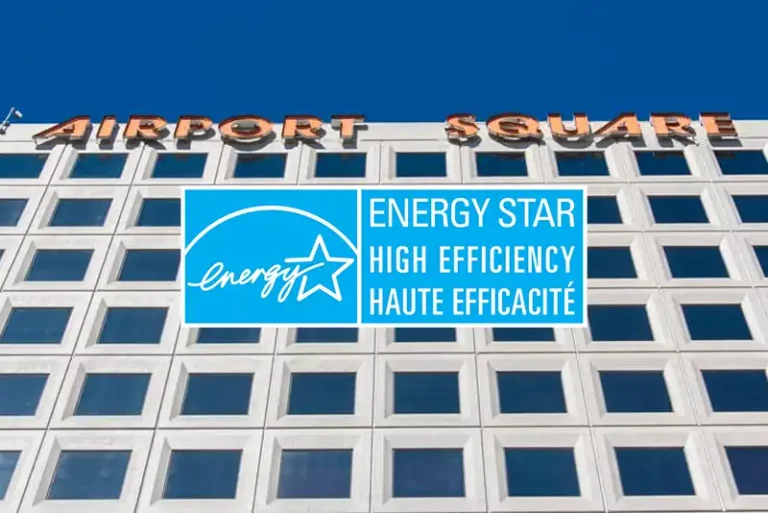 Office
Office
Airport Square, Vancouver
A South Vancouver office tower with strong environmental credentials
 Retail
Retail
Guildford Town Centre
One of Canada’s most productive shopping centers in a rapidly growing area
 Office
Office
Maison Manuvie, Montréal
An award-winning office building in downtown Montréal with strong environmental credentials.
 Residential
Residential
Rideau & Chapel, Ottawa
A new-build residential and retail development in the heart of Canada’s capital
 Industrial
Industrial
Toronto Industrial Portfolio
Strategically located warehouse facilities serving the Greater Toronto Area
Important information
The assets presented are meant for illustrative purposes only, are subject to change without notice and are not meant as a projection or estimate of the nature of any future investments to be made by the Fund or returns on any such investments. This information has been prepared by LaSalle in order to illustrate the type of assets held and/or transactions completed by the Fund; transactions for properties exhibiting the same or similar characteristics may not be available or profitable in the future.
Important information about sustainability
A decision to invest should consider all characteristics or objectives disclosed in the offering document. Please refer to the offering document before making any final investment decision.
Except where specified either in this webpage or any other documents, any sustainability or impact goals, targets, commitments, incentives, initiatives or outcomes referenced in any information, reporting or disclosures published by LaSalle are not being marketed to investors or promoted and do not bind any investment decisions made in respect of, or the management or stewardship of, any funds managed by LaSalle for the purposes of Regulation (EU) 2019/2088 on sustainability-related disclosures in the financial services sector. Any measures in respect of such sustainability or impact goals, targets, commitments, incentives, initiatives or outcomes may be overridden, may not be implemented or may not be immediately applicable to the investments of any funds managed by LaSalle (in each case, at LaSalle’s sole discretion).
Information about 275 Slater’s ratings and certifications
Alexandra Levy serves as Head of Debt Capital Markets for LaSalle in the Americas. She is a critical partner for the Portfolio, Asset Management, and Transactions teams seeking to optimize terms and credit structures across all investments. Allie serves as a voting member on LaSalle’s Americas Debt Investment and Private Equity Investment Committees.
Allie began her career in real estate debt capital markets in 2006 and has experience on both the borrower and lender side of the business. Before joining LaSalle, she served as Head of Capital Markets and Development Finance for Great Wolf Resorts, a Blackstone portfolio company, and closed more than US $2.6 billion in debt transactions. Prior to her time at Great Wolf Resorts, Allie spent more than six years at GGP, ultimately taking on a role as Director of Capital Markets, and she previously served as a senior underwriter in JPMorgan Chase’s Real Estate Banking division.
Allie earned a Master of Business Administration in Finance, Accounting, and International Business from The University of Chicago Booth School of Business and a Bachelor of Arts in Political Science and Anthropology from the University of Pennsylvania.
Recognition has grown substantially in recent years that climate risk can shape real estate investment outcomes. This owes to an increasing frequency and severity of loss events,1 surging insurance premiums,2 improving data availability and a mounting reporting burden driven by regulations.3 Investors have had to move quickly from acquiring basic climate risk literacy, to sourcing good quality climate risk data, to most recently, leveraging that data into improved investment decisions. There is a clear and rising likelihood that investors on the lagging edge of this process may underperform.
At LaSalle, we have sought to share insights from our own climate risk journey, combining that with broader analysis of our industry’s climate risk challenges and opportunities. In 2022, we partnered with the Urban Land Institute (ULI) on a report, How to choose, use, and better understand climate-risk analytics, which addressed the difficulties in selecting and evaluating climate data from an ever-changing and increasingly crowded—and sometimes contradictory—data provider landscape. In April, we released a new report with ULI, Physical Climate Risks and Underwriting Practices in Assets in Portfolios, which looks at how investors are taking these data and seeking to make better-informed buying, selling and portfolio construction decisions based on them.
While the joint ULI report takes an industry-wide view, this ISA Briefing looks at the topic through the lens of LaSalle’s own investment process. We present three case studies of our evaluation of climate risk on a regional, market and asset-level scale. These examples – one each from each of our global investment regions – illuminate how we are taking account of climate risk and lay out our views on issues investors should be thinking about.
In 2023, the US recorded 28 weather/climate disaster events for which losses exceeded $1 billion, the highest recorded number of distinct events exceeding that threshold.4 But of course, these events were not uniformly distributed across the country. To better understand the geographic predisposition of parts of the country to these hazards, LaSalle’s US Research and Strategy team developed two separate climate risk indexes, evaluating current and future climate risk. The indexes encompass a range of climate hazards, such as heatwaves, floods and wildfires, with earthquakes added as a non-climate threat. The current climate risk index harnesses machine learning to scrutinize hyper-local data from the Federal Emergency Management Agency (FEMA). Meanwhile, the future climate risk projections rely on data from the Rhodium Group data set, as analyzed by ProPublica and assuming an RCP 8.5 scenario.5
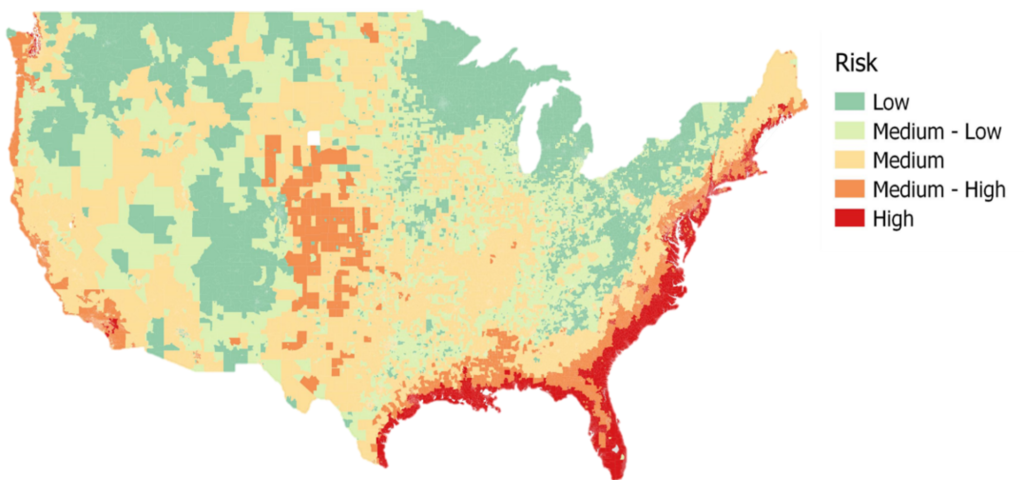
Looking at climate risk at a regional scale has been useful in several ways. First, it can accelerate analysis of new opportunities by acting as a “yellow flag,” directing resources early in the underwriting process toward deeper analysis into asset-specific climate risk issues that may turn out to be red flags. Second, regional climate risk can be integrated into market-targeting tools, weighing it alongside other factors that influence real estate performance (for example, demographic variables such as population growth and real estate variables like the prospects for rental growth). To this end, LaSalle has embedded these climate risks scores into our proprietary Target Market Analyses (TMAs). Thirdly, it can help frame inquiry into how metro-level performance factors, such as migration patterns, can interact with climate risk over time.
On that last point, the map appears to beg a question about recent migration trends that have favored the Sunbelt.6 Are people disproportionally moving to at-risk places, and if so, why? An important follow-on question that is germane for investment strategy is whether climate change may eventually cause a reversal of recently observed migration patterns. Indeed, we do observe a discernible, moderately positive correlation7 (+29%) between climate risk exposure and increased migration over the past five years. This pattern holds, and even intensifies, when considering population growth projections for the next five years (+47% correlation).8
The implication is that regions facing severe climate challenges continue to draw new residents. This suggests that environmental risks may not yet be so widely recognized as to shape behavior. That said, a mere 8% of market value within the NCREIF Property Index’s (NPI) apartment asset base is situated in markets we classify as high-risk.9 This suggests the impact in the near-term on institutional real estate investors will be limited, at least until climate change is severe enough to routinely impact markets in the next less risky band, which encompasses 16% of total NPI apartment value.10 Either way, investors looking to the long-term would be wise to consider how people will respond to growing climate hazards in high-risk markets. If a major reaction is that Sunbelt denizens relocate back to the Rustbelt, that could have significant implications for regional economic growth and real estate market prospects.
Below the regional level, it is at the scale of an individual metro area where different degrees of exposure to climate risk can be evaluated with more granularity. It is often at this level where both in-place and planned efforts to mitigate the potential impacts of climate hazards can be identified. As we discussed in our 2022 ULI report, such measures can confound traditional climate risk data if they ignore its impact.
For example, when overlaying LaSalle’s global portfolio with raw data from our climate risk providers, Amsterdam and its broader ‘Randstad’ region stand out as especially exposed to sea-level rise. Not considering any protective infrastructure, we estimate that 52% of Amsterdam and 38% of Rotterdam commercial property would have a significant exposure to severe flood.11

Thankfully, the Dutch have been building dams and levees to protect their low landmass from flooding for centuries.12 Modern infrastructure investment accelerated in the wake of the 1953 North Sea flood – a combination of a severe European windstorm and high spring tide that caused the sea to flood land up to 5.6 meters above mean sea level.13 The ‘Deltawerken’ (Delta Works), now complete, consists of a set of storm surge barriers, locks and dams mainly located in the south of the country. But the Dutch flood defense program extends beyond the Delta Works,14 encompassing almost 1,500 constructed barriers, including more than 20,000 kilometers of dikes, enough to encircle the country over 15 times. In fact, the Delta Works program has evolved into the Delta Programme, a continuous project that take future effects of climate change into account, with a target of 100% of the Dutch population protected by floods not exceeding a 1 in 100,000-year event by 2050.15
The presence of these flood defense programs is of imperative importance when considering the Dutch markets for investments. We find that many climate risk data providers do not adjust for the Netherlands’ formidable stock of anti-flood infrastructure investment which mitigates much of the risk. Investors who act as uncritical “takers” of unadjusted climate risk stats may thus excessively underweight the Dutch market.
Below the regional and market level, the asset level is where the outcomes of climate hazards have the most direct impact on a building’s structural integrity or the ability to access and operate a property. An asset manager’s actions can directly influence a building’s capacity to withstand climate-related hazards. This tends to be the most impactful when such interventions are made during the design phase of the development.
For example, take the case of a LaSalle logistics development in Osaka, Japan, a city that has historically been vulnerable to flooding due to its geographical location, with much of the urban area made up of flat lowlands that make natural drainage a challenge in the event of tsunamis and heavy rainfall.16 The local city planning assesses the maximum level water could rise above sea level by submarket in the event of a flood. The flood height varies by location while considering additional factors such as the city’s infrastructure (i.e., floodgates and seawalls) and the overall elevation of the submarket. In the case of one of LaSalle’s Osaka Bay logistics developments, the subject warehouse is at a site where water levels could rise to three meters above sea level in the case of a flood.17
Seawalls, ranging in height from 5.7-7.2 meters protect the asset from extreme floods coming from the sea. To further mitigate the flood risk in the case of extreme rainfall or failure of the sea walls, the warehouse is designed with an elevated floor plate that puts the ground level 1.4 meters above mean sea level, and places key building equipment on the second floor, minimizing potential damage to the asset in the event of flood. This effort resulted in a 4.4 meter clearance above sea level (i.e., sea level + 1.4 meter buffer + 3 meters = 4.4 meters), which is above the required 3.5 meters above sea level (i.e., sea level + 1.4 meter buffer + 2.05 meters = 3.45 meters) for the location. In addition, the property management team has been trained and equipped to minimize flood damage on the first floor by closing the doors and shutters and placing sandbags in any gaps. By incorporating considerations to mitigate flood risk when designing the warehouse, the asset is well positioned to support tenants’ business continuity plans in the event of a flood.
Footnotes
1 Source: National Centres for Environmental Information of the National Oceanic and Atmospheric Administration (NOAA). See Billion Dollar Weather and Climate Disasters
2 Source: The Climbing Costs to Insure US Commercial Real Estate, MSCI, November, 29 2023
3 The TCFD framework which has now been absorbed by IFRS’ ISSB, serves as the framework with which other international reporting standards setters seek to align such as the US SEC who voted in favour of The enhancement and standardization of climate-related disclosure, or the UK Government and the Sustainability Standards Board of Japan who will align its disclosure standards with ISSB.
4 According to the National Centers for Environment Information (NCEI). $1 billion threshold adjusted for inflation in historical periods. See https://www.ncei.noaa.gov/access/billions/.
5 RCP refers to Representative Concentration Pathway, a standard for modeling future climate scenarios of greenhouse gas concentration in the atmosphere. RCP 8.5 represents an extreme case scenario. See this Intergovernmental Panel on Climate Change (IPCC) glossary for more detail.
6 For more discussion on this trend, see our recent ISA Briefing, US migration trends and (U)rbanization.
7 Cross-sectional correlation between the LaSalle current climate risk index and the population change in the top 45 US metro areas between December 2018 and December 2023.
8 Cross-sectional correlation between the LaSalle future climate risk index and population change in the top 45 US metro areas between December 2023 and December 2028 based on Moody’s forecast as of February 2024.
9 Source: LaSalle analysis of data from NCREIF, FEMA.
10 Source: LaSalle analysis of data from NCREIF, FEMA.
11 Source: LaSalle analysis of MSCI data.
12 Source: The Dutch experience in flood management: A history of institutional learning
13 Source: The devastating storm of 1953, The History Press
14 Source: Dutch primary flood defenses, Nationaal Georegister
15 See Delta Programme 2024
16 See Osaka city – Flood disaster prevention map outline from the Osaka City Office of Emergency Management.
17 Estimates of maximum flood depth are based on historical records of natural disasters such as earthquakes, river floods and tsunamis that have occurred as reported by Japan’s Ministry of Land, Infrastructure and Tourism.
18 A superficial view of markets is that transactions are based on agreement on value. More accurately, buyers and sellers agree on a price, but their willingness to transact is based on disagreement on value. A seller, for example, may have a less bullish view on NOI growth prospects than a buyer. We expect the same disagreement on climate-related risk/reward trade-offs to be increasingly important.
This publication does not constitute an offer to sell, or the solicitation of an offer to buy, any securities or any interests in any investment products advised by, or the advisory services of, LaSalle Investment Management (together with its global investment advisory affiliates, “LaSalle”). This publication has been prepared without regard to the specific investment objectives, financial situation or particular needs of recipients and under no circumstances is this publication on its own intended to be, or serve as, investment advice. The discussions set forth in this publication are intended for informational purposes only, do not constitute investment advice and are subject to correction, completion and amendment without notice. Further, nothing herein constitutes legal or tax advice. Prior to making any investment, an investor should consult with its own investment, accounting, legal and tax advisers to independently evaluate the risks, consequences and suitability of that investment.
LaSalle has taken reasonable care to ensure that the information contained in this publication is accurate and has been obtained from reliable sources. Any opinions, forecasts, projections or other statements that are made in this publication are forward-looking statements. Although LaSalle believes that the expectations reflected in such forward-looking statements are reasonable, they do involve a number of assumptions, risks and uncertainties. Accordingly, LaSalle does not make any express or implied representation or warranty, and no responsibility is accepted with respect to the adequacy, accuracy, completeness or reasonableness of the facts, opinions, estimates, forecasts, or other information set out in this publication or any further information, written or oral notice, or other document at any time supplied in connection with this publication. LaSalle does not undertake and is under no obligation to update or keep current the information or content contained in this publication for future events. LaSalle does not accept any liability in negligence or otherwise for any loss or damage suffered by any party resulting from reliance on this publication and nothing contained herein shall be relied upon as a promise or guarantee regarding any future events or performance.
By accepting receipt of this publication, the recipient agrees not to distribute, offer or sell this publication or copies of it and agrees not to make use of the publication other than for its own general information purposes.
Copyright © LaSalle Investment Management 2024. All rights reserved. No part of this document may be reproduced by any means, whether graphically, electronically, mechanically or otherwise howsoever, including without limitation photocopying and recording on magnetic tape, or included in any information store and/or retrieval system without prior written permission of LaSalle Investment Management.
Report Summary: Physical climate risk data can be a powerful tool for managing asset and portfolio risk and returns. Learn what strategies leading firms are using to manage physical climate risks and navigate market challenges. The latest report from the Urban Land Institute and LaSalle Investment Management builds on their previous report, How to Choose, Use, and Better Understand Climate Risk Analytics, to describe how leading firms are leveraging physical climate-risk data in underwriting practices. With insight into asset- and portfolio-level risk becoming increasingly easy to obtain, new challenges lie in effective interpretation and integration of information into investment practices. Relying on research and interviews with industry leaders, this report provides a nuanced exploration of this emergent issue.
Physical Climate Risks and Underwriting Practices in Assets and Portfolios is structured into three sections, each addressing different aspects of the industry’s response to climate-risk data:
Section 1. Explore the current state of the industry, finding that:
• Leading firms actively coach their teams on physical risk.
• Regulatory trends affect, but do not motivate physical risk assessment.
• Different geographies approach physical with their own level of urgency.
• Investment managers tend to focus on fund risk, capital providers on portfolio risk.
• Tools to understand and price physical risk are still in a nascent stage of development.
Section 2. Examines the application of climate data in decision making. Key findings include:
• Aggregate physical risk is a screening tool; individual hazard risk is actionable information.
• Climate value at risk remains opaque; the utility of the single number offers value but needs increased transparency.
• Atypical hazard risk (e.g., flood in a desert) merits increased attention.
• External consultants can frequently fill skill gaps, especially for firms with less in-house expertise.
• While no predominant timeframe or Representative Concentration Pathway (RCP) emerged as industry standard, the 2030 and 2050 benchmarks were the most commonly referenced time horizon.
Section 3. Assess the impact of physical climate risk on acquisition, underwriting, and disposition practices; finding that:
• Leading firms start with a top-down assessment of physical risk.
• Market concentration of physical risk is analogous to other concentration risks—a nuanced analysis is required.
• Capital expenditure for resilience projections is a key forecast but rife with uncertainty.
• Local-market climate mitigation measures are important to understand but difficult to forecast.
• Exit cap rate discount for estimated physical risk is an increasingly commonly used tool, frequently 25 to 50 basis points.
• Firms infrequently disclose physical risk but the market needs increased transparency.

Important Notice and Disclaimer
This publication does not constitute an offer to sell, or the solicitation of an offer to buy, any securities or any interests in any investment products advised by, or the advisory services of, LaSalle Investment Management (together with its global investment advisory affiliates, “LaSalle”). This publication has been prepared without regard to the specific investment objectives, financial situation or particular needs of recipients and under no circumstances is this publication on its own intended to be, or serve as, investment advice. The discussions set forth in this publication are intended for informational purposes only, do not constitute investment advice and are subject to correction, completion and amendment without notice. Further, nothing herein constitutes legal or tax advice. Prior to making any investment, an investor should consult with its own investment, accounting, legal and tax advisers to independently evaluate the risks, consequences and suitability of that investment.
LaSalle has taken reasonable care to ensure that the information contained in this publication is accurate and has been obtained from reliable sources. Any opinions, forecasts, projections or other statements that are made in this publication are forward-looking statements. Although LaSalle believes that the expectations reflected in such forward-looking statements are reasonable, they do involve a number of assumptions, risks and uncertainties. Accordingly, LaSalle does not make any express or implied representation or warranty, and no responsibility is accepted with respect to the adequacy, accuracy, completeness or reasonableness of the facts, opinions, estimates, forecasts, or other information set out in this publication or any further information, written or oral notice, or other document at any time supplied in connection with this publication. LaSalle does not undertake and is under no obligation to update or keep current the information or content contained in this publication for future events. LaSalle does not accept any liability in negligence or otherwise for any loss or damage suffered by any party resulting from reliance on this publication and nothing contained herein shall be relied upon as a promise or guarantee regarding any future events or performance.
By accepting receipt of this publication, the recipient agrees not to distribute, offer or sell this publication or copies of it and agrees not to make use of the publication other than for its own general information purposes.
Copyright © LaSalle Investment Management 2024. All rights reserved. No part of this document may be reproduced by any means, whether graphically, electronically, mechanically or otherwise howsoever, including without limitation photocopying and recording on magnetic tape, or included in any information store and/or retrieval system without prior written permission of LaSalle Investment Management.
Washington / New York (April 11, 2024) – A new global report from the Urban Land Institute (ULI) and LaSalle Investment Management (LaSalle), a leading real estate investment management firm, offers a new framework to help the real estate industry act on climate risk disclosure data. Across the real estate industry, practitioners understand physical climate risk to assets and portfolios poses a financial risk, but there are still many challenges to enacting on the data being collected and disclosed.
This new framework is the latest tool for real estate investors and other practitioners to evaluate the costs of action and inaction when it comes to investing in resilience. The report, Physical Climate Risks and Underwriting Practices in Assets and Portfolios, is the second in a series by ULI and LaSalle. Building on the first report that outlined how to source and interpret reliable climate risk data, the second provides a market overview, adaptable framework, and recommendations based on emerging best practices for incorporating physical climate risk in the underwriting process.
“Physical climate risk data collection and disclosure is the first step the real estate industry can take to further invest in and build resilient infrastructure,” said Lindsay Brugger, head of Urban Resilience at ULI. “Data drives action and doing nothing incurs deeper costs — from higher insurance premiums to asset repair or replacement. Focusing on the underwriting process, the framework offers investment managers a methodology for developing risk-adjusted returns so deals can be adapted in alignment with a firm’s fund or portfolio objectives.”
“Of the $850 billion of commercial real estate tracked by NPI, LaSalle estimates $285 billion, or 34% is situated in high and medium-high climate risk zones in the US,” said Julie Manning, Global Head of Climate and Carbon at LaSalle Investment Management. “This report helps provide guidance that investment managers can follow to factor the climate risk data they have available to them and improve outcomes at the asset and portfolio level. We want to lead the conversation across the industry and collaborating with ULI is a great conduit to amplify the discussion that will ultimately benefit investors of all kinds with more resilient real estate portfolios.”
The framework is broken down into three steps for decision making based on individual asset risks, local market risks, and ongoing risk mitigation efforts:
1. Evaluate the level of exposure to physical climate risk and financial implications;
2. Identify hazard mitigation strategies and estimate associated costs; and
3. Determine risk-adjusted return and whether or not that return meets firm objectives
The redevelopment will also look to meet future tenant requirements and evolving work trends with high-quality amenities to promote in-person interaction and facilitate a hybrid working, including an auditorium, business centre, bars and restaurants, event spaces and a media broadcast studio.
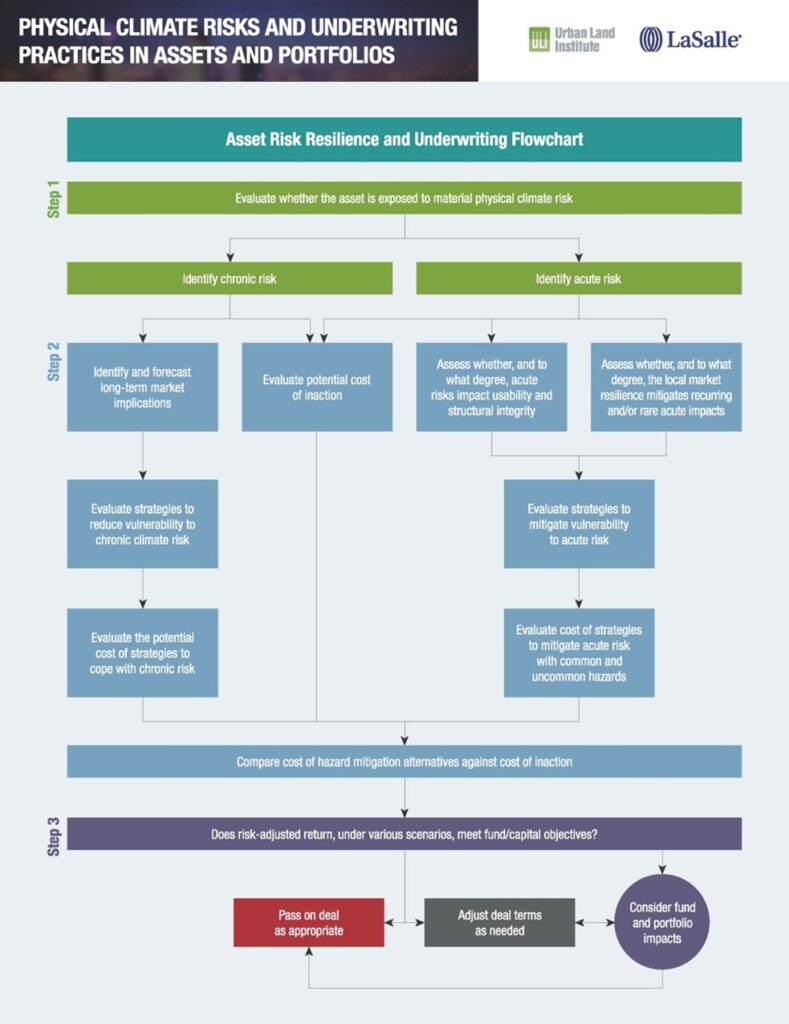
As climate impacts continue to influence real estate markets around the world, improving understanding of physical climate risk and adjusting pricing to reflect risk are growing imperatives. Firms can better navigate the complexities of physical climate risk and capitalize on emerging opportunities by leveraging this new report’s insights and guidance. Prioritizing knowledge diffusion and empowering informed decision-making processes is key to effectively managing and mitigating incoming climate risks in the evolving real estate industry, whether at a community or individual building scale.
The full report and downloadable framework can be found on ULI’s Knowledge Finder.
REPORTERS AND EDITORS: For more information, please contact:
ULI
LaSalle
Drew McNeill
About the Urban Land Institute
The Urban Land Institute is a non-profit education and research institute supported by its members. Its mission is to shape the future of the built environment for transformative impact in communities worldwide. Established in 1936, the institute has more than 48,000 members worldwide representing all aspects of land use and development disciplines. For more information on ULI, please visit uli.org, or follow us on Twitter, Facebook, LinkedIn, and Instagram.
About LaSalle Investment Management
LaSalle Investment Management is one of the world’s leading real estate investment managers. On a global basis, LaSalle manages over US $89 billion of assets in private and public real estate equity and debt investments as of Q4 2023. LaSalle’s diverse client base includes public and private pension funds, insurance companies, governments, corporations, endowments and private individuals from across the globe. LaSalle sponsors a complete range of investment vehicles including separate accounts, open- and closed-end funds, public securities and entity-level investments. For more information please visit www.lasalle.com, and LinkedIn.



Simone Caschili serves as a Senior Analytics Strategist on LaSalle’s Research and Strategy team, spearheading the analytics initiatives in North America, with keen focus on investment performance and supporting the deployment of investment strategies.
Prior to joining LaSalle in 2014, Simone held an Associate Research position at University College London, applying complex network analysis to international trade and maritime industry studies. He began his career in Sardinia, Italy, as a consultant at the Regional Urban Planning Office.
Simone holds a PhD in Environmental and Urban Planning from University of Cagliari, Italy. He is an active contributor to the NCREIF Information Management Committee and invited speaker at conferences and webinars.
Alissa Schachter joined LaSalle in March 2024 as Senior Vice President, Americas Marketing and Communications. In this role, she is responsible for the development and execution of LaSalle’s internal and external communication strategies across the region. In addition, Alissa spearheads initiatives to drive the growth and reinforcement of the company’s brand, while also providing support for capital raising and deployment efforts.
Alissa has extensive experience in marketing strategy development and execution in the real estate and asset management industries. Prior to joining LaSalle, Alissa lead marketing for the national real estate practice at RSM US.
Alissa holds a Bachelor of Arts in Business Marking from Indiana University Bloomington.
Roughly 60% of the world’s population lives in countries facing major elections in 2024, markets representing 65% of the institutional investable real estate universe.1 Elections are, of course, the cornerstone of the democratic process, which in turn underpins the appeal of the most transparent, investable markets; that said, elections come with the possibility of policy changes that may impact returns. Today’s geopolitical risks, whether they be this continuing election super-cycle (see LaSalle Macro Quarterly, or LMQ, page 4), or the various ongoing conflicts and trade disruptions, prompt important questions about how to manage investment risks related to these themes.
One of the protagonists in the Oscar-winning film Everything Everywhere All at Once says that being “’right’ is a small box invented by people who are afraid.” LaSalle’s risk management philosophy emphasizes optimizing risk/return trade-offs rather than minimizing risk-taking, while recognizing the limitations of point-estimate predictions and base-case scenarios — that is, attempts at “being right.” Today’s geopolitical events are especially likely to confound any forecaster seeking to be exactly right.
How should an investor manage their assets in the context of “unknowables” about which engaging in guesswork is tempting, but being “right” is elusive? What frameworks do we have to mitigate geopolitical risks? We propose six recommendations to keep in mind for investors taking stock of the many elections, and several conflicts, that may impact markets in 2024.
There are many examples of ex ante predictions of elections’ investment implications having been overstated. For instance, leading up to the 2016 US presidential election, there were widespread predictions that the US economy would be significantly negatively impacted by Donald Trump’s anti-immigration and protectionist stance were he elected.2 In the event, equity markets rebounded strongly after a short-lived hit and the US economy proved resilient to the changes in rhetoric and policy that came with a new president.3
Looking ahead to the US elections later this year, almost certainly a rematch between Biden and Trump, coverage of the candidates’ differences should be accompanied by awareness of their similarities. Both candidates seek to prioritize domestic production, which could lead to greater levels of on- or near-shoring of supply chains.4 Moreover, election prediction odds (see LMQ page 6) suggest divided control of the two houses of Congress and the presidency is likely; divided government has typically been associated with relative stability in domestic policy, which is generally positive for markets.5 Both of these factors — at least in isolation — point to the potential for news cycle hype to overstate long-term market impacts of this particular election.
Financial theory tells us that systematic risks are undiversifiable.6 Systematic factors are those with significant, far-reaching implications that affect the price of all assets. But financial theory also entertains that different assets may have different sensitivities to the same set of factors; an asset’s “beta” signifies the responsiveness of its price to a given factor. This is a useful way to think about an investment’s sensitivity to political and geopolitical events. For example, a property in a metro area whose economy is heavily driven by government spending would likely have a high sensitivity to political changes. Another example could be that a property located in the Baltic States, ex-Soviet countries on the border with Russia, is likely to be especially sensitive to developments concerning relations between Russia and the West. Investors should be mindful of assets’ expected sensitivities to geopolitics, whether assessed empirically or, as is more often the case given a lack of data, estimated through intuition.
Systemic risks go beyond systematic factors; they involve severe shocks that have the potential to re-align entire markets in unpredictable ways. An example of such an extreme event is the remote but non-negligible potential that today’s so-called “proxy wars”7 escalate into a broader active conflict between great powers.8 The challenge of incorporating such eventualities into investment decision making is not only estimating appropriate probabilities that such events may occur, but establishing ideal strategic responses should they do so. Catastrophic shocks are exceedingly rare and have the potential to create winners and losers in asset markets that are difficult or impossible to predict.9 It may be more fruitful for investors to focus on more incremental — and more likely — eventualities that have the added benefit of being easier to model.
Media coverage naturally tends to focus on the national and trans-national arenas, but local political developments can be especially impactful for real estate investments. Such issues can fly under the radar, especially given many of the most relevant ones are only of interest to a specialist audience. For example, changes in policy around topics like the planning process, property taxes and transfer taxes (a.k.a. stamp duty) can have direct, measurable and immediate impacts on property cash flows and thus values. The distraction of the bright shiny lights of global geopolitics should not be allowed to excessively overshadow the critical local issues that impact real estate.
To a certain extent, political risks can be managed through diversification. This is especially true when they involve isolated events that impact one country or subnational division such as a specific city, province or state. But often political events are part of a broader arc with potentially far-reaching consequences. A smattering of small seeds can grow from obscurity into a thicket. Nothing illustrates this better than the rise of populism, nationalism and protectionism around the world, themes set to dominate elections this year and beyond. The very notion of “globalized nationalism” may sound like an oxymoron, but it has become a fact.10 While diversification is an essential portfolio construction concept that helps manage many types of risk, including political risk, care must be taken to recognize when what may appear to be “specific” risks are part of a broader pattern that is difficult to “diversify away.”
Geopolitical and political risks are difficult to incorporate into traditional financial analysis. We find that thinking through scenarios can be helpful in identifying investment themes that may emerge from geopolitical trends. These can point to strategies to avoid — as well as potential new ones to pursue. The “Looking Ahead” section of this note expands on some of the key themes we have been tracking.
As geopolitical events are difficult to control and plan for, one may conclude, similarly to that same protagonist in the Everything Everywhere film, that “nothing matters.” But uncertainty is no excuse for ignoring geopolitical risks. We do stop short of directly feeding geopolitical themes into our formal risk management program, where the focus is on the specific risks that can actively be managed for our clients.11 However, it remains important to observe and understand macro conditions from a holistic perspective. The work done in our regional research teams — particularly that focused on capital markets, the signals that foreshadow potential inflection points and the local political themes that impact real estate — is critical to this effort.
We have argued that political and geopolitical risks are difficult to incorporate into investment processes, but that considering “what ifs” can be useful in uncovering relevant investment themes. Below are three potential real estate implications of the current geopolitical backdrop that we are monitoring today:
Footnotes
1 LaSalle analysis of data from Time and our proprietary investable universe estimates. See LMQ page 5 for more detail.
2 Sources: “What do financial markets think of the 2016 election?” Brookings Institution paper, Wolfers and Zitzewitz, 2016. The article predicted that “a Trump victory would trigger an 8-10% sell-off”. See also “The Consequences of a Trump Shock,” a Project Syndicate article by Simon Johnson, 2016. He predicted Trump’s election would “likely cause the stock market to crash and plunge the world into recession.”
3 On the news of the 2016 election result, Standard & Poor’s 500-stock index initially fell 5% but ended the day up more than 1%, according to Refinitiv. The US avoided a recession until the emergence of the COVID-19 pandemic, according to Oxford Economics.
4 Source: “Biden vs Trump: Key policy implications of either presidency,” Economist Intelligence Unit, 2023.
5 Sources: “What to Expect From Divided Government.” PIMCO article, Cantrill, 2022. According to the article, “the equity markets historically have tended to do well in years of split government.”
6 Source: The Handbook of Risk Management: Implementing a Post-Crisis Corporate Culture. P. Carrel, 2012. “Systematic or market risk refers to the inherent danger present throughout the entire market that cannot be mitigated by diversifying your portfolio. Broad market risks include recessions, periods of economic weakness, wars, rising or stagnating interest rates, fluctuations in currencies or commodity prices, and other ‘big-picture’ issues like climate change. Systematic risk is embedded in the market’s overall performance and cannot be eliminated simply by diversifying assets.”
7 According to the Oxford Dictionary, “proxy wars are the replacement for states and non-state actors seeking to further their own strategic goals yet at the same time avoid engaging in direct, costly, warfare.” Various observers have argued that the Russia-Ukraine and Israel-Gaza conflicts are proxy wars. For example, see “IKs the ware in Ukraine a proxy conflict?” Kings College London report, Hugues (2022).
8 According to a research brief by RAND: “Great power wars — conflicts that involve two or more of the most powerful states in the international system. These have historically been among the most consequential international events.”
9 Source: “What a third world war would mean for investors,” The Economist, 2023. The article highlights the virtual impossibility of positioning an investment portfolio to outperform through prior world wars, even if the investor had correctly predicted that these conflicts would occur.
10 For further discussion of the global spread of nationalism, see “How cynical leaders are whipping up nationalism to win and abuse power”, The Economist, 2023; “Demonizing nationalist parties has not stemmed their rise in Europe,” The Economist, 2022; “The new nationalism,” The Economist, 2016.
11 We do, however, utilize tools that correlate to geopolitical risk. For example, the JLL Global Real Estate Transparency Index (GRETI) supports our monitoring of evolving investment conditions around the globe. Whilst the model does not explicitly consider political risk, the two are inexplicably linked through the inclusion of a number of governance and regulation data points.
12 Source: “A global economic policy uncertainty index from principal component analysis,” Finance Research Letters, Peng-Fei Dai, 2019.
13 Source: “What are the impacts of the Red Sea shipping crisis,” J.P. Morgan, 2024.
14 Source: “The Great Rewiring: How Global Supply Chains Are Reacting to Today’s Geopolitics,” Center for Strategic & International Studies, 2022.
15 Sources: “The business costs of supply chain disruption,” Economist Intelligence Unit, 2021 and “Why Deglobalization Makes US Inflation Worse,” Project Syndicate, Moyo, 2022.
This publication does not constitute an offer to sell, or the solicitation of an offer to buy, any securities or any interests in any investment products advised by, or the advisory services of, LaSalle Investment Management (together with its global investment advisory affiliates, “LaSalle”). This publication has been prepared without regard to the specific investment objectives, financial situation or particular needs of recipients and under no circumstances is this publication on its own intended to be, or serve as, investment advice. The discussions set forth in this publication are intended for informational purposes only, do not constitute investment advice and are subject to correction, completion and amendment without notice. Further, nothing herein constitutes legal or tax advice. Prior to making any investment, an investor should consult with its own investment, accounting, legal and tax advisers to independently evaluate the risks, consequences and suitability of that investment.
LaSalle has taken reasonable care to ensure that the information contained in this publication is accurate and has been obtained from reliable sources. Any opinions, forecasts, projections or other statements that are made in this publication are forward-looking statements. Although LaSalle believes that the expectations reflected in such forward-looking statements are reasonable, they do involve a number of assumptions, risks and uncertainties. Accordingly, LaSalle does not make any express or implied representation or warranty, and no responsibility is accepted with respect to the adequacy, accuracy, completeness or reasonableness of the facts, opinions, estimates, forecasts, or other information set out in this publication or any further information, written or oral notice, or other document at any time supplied in connection with this publication. LaSalle does not undertake and is under no obligation to update or keep current the information or content contained in this publication for future events. LaSalle does not accept any liability in negligence or otherwise for any loss or damage suffered by any party resulting from reliance on this publication and nothing contained herein shall be relied upon as a promise or guarantee regarding any future events or performance.
By accepting receipt of this publication, the recipient agrees not to distribute, offer or sell this publication or copies of it and agrees not to make use of the publication other than for its own general information purposes.
Copyright © LaSalle Investment Management 2024. All rights reserved. No part of this document may be reproduced by any means, whether graphically, electronically, mechanically or otherwise howsoever, including without limitation photocopying and recording on magnetic tape, or included in any information store and/or retrieval system without prior written permission of LaSalle Investment Management.
Greg Miller, CFA, is a Managing Director with LaSalle Global Solutions and a Securities Global Portfolio Manager focusing on the global retail, triple net lease, and industrial sectors.
Greg joined LaSalle Securities in 2009. Over the course of his career with LaSalle, Greg analyzed a wide range of sectors and geographies.
He earned an Master of Business Administration from the University of Maryland and Bachelor of Arts in finance from The University of Oklahoma. Greg holds the Chartered Financial Analyst designation.
CHICAGO, LONDON, SINGAPORE (26 February 2024) – LaSalle Investment Management (“LaSalle”), the global real estate investment manager, has strengthened its global investor and client relations capabilities with the appointment of Isabelle Brennan, Senior Managing Director, Credit and Global Solutions Product Specialist. The newly created role underscores LaSalle’s commitment to strategic growth as it continues to focus on diversifying its investment products, and strengthening its client offering and coverage, to drive long-term growth.
Isabelle will rejoin LaSalle on 1 May 2024 from CBRE Investment Management, where she served as a Senior Director in the Client Solutions team. During her tenure she held a variety of roles, including supporting clients’ access to real estate credit investments across EMEA and the US, global Indirect solutions, and managing relationships with U.K. and Irish clients and consultants for their investments across the global suite of real estate and infrastructure solutions. Prior to this, she developed her expertise across real assets credit and client solutions as a Director at M&G Investments, overseeing global investor relationships on behalf of the Real Estate Finance platform.
Before joining M&G Investments, Isabelle was at LaSalle and held responsibilities across capital raising and relationship management for clients in the UK, Ireland and the Netherlands, in addition to being a Product Specialist for EMEA credit strategies.
In her new role, Isabelle will report into Samer Honein, Global Head of Investor Relations, partnering with the Investor Relations team to promote Credit and Global Solutions to existing and prospective clients around the world. She will also join the Investor Relations Management Board and will be based in London.
Samer Honein, Global Head of Investor Relations at LaSalle Investment Management, said: “Isabelle’s return to LaSalle will provide a significant boost to the Investor Relations team. She brings a wealth of credit and client solutions experience and is well-placed to provide deep-rooted insights to facilitate client access to real estate credit and indirect investments. We look forward to leveraging Isabelle’s expertise as we continue to build our client base and strengthen our offering.”
About LaSalle Investment Management | Investing Today. For Tomorrow.
LaSalle Investment Management is one of the world’s leading real estate investment managers. On a global basis, LaSalle manages approximately $89 billion of assets in private and public real estate equity and debt investments as of Q3 2023. LaSalle’s diverse client base includes public and private pension funds, insurance companies, governments, corporations, endowments and private individuals from across the globe. LaSalle sponsors a complete range of investment vehicles, including separate accounts, open- and closed-end funds, public securities and entity-level investments.
For more information, please visit www.lasalle.com, and LinkedIn.
NOTE: This information discussed above is based on the market analysis and expectations of LaSalle and should not be relied upon by the reader as research or investment advice regarding LaSalle funds or any issuer or security in particular. The information presented herein is for illustrative and educational purposes and is not a recommendation, offer or solicitation to buy or sell any securities or to adopt any investment strategy in any jurisdiction where prohibited by law or where contrary to local law or regulation. Any such offer to invest, if made, will only be made to certain qualified investors by means of a private placement memorandum or applicable offering document and in accordance with applicable laws and regulations. Past performance is not indicative of future results, nor should any statements herein be construed as a prediction or guarantee of future results.



In the past decade, the urbanization narrative in the United States has shifted from the “rebirth of cities” to the “rise of the suburbs.”1 What are the drivers of this shift, and how does it impact real estate? In this ISA Briefing, we tackle these questions and share our outlook for how future dynamics could impact migration and urbanization trends.
Demographics is destiny
Demographic cohort effects are a key driver of the current shift. The generic, or median, location preferences of a cohort change as that cohort ages; as the relative growth of different age groups ebbs and flows it impacts the national trend towards urban and suburban location preference.
In the US, there are two outsized cohorts, the Baby Boomers and the Millennials, which as they age have a disproportionate impact on national averages (see chart below). In the early 2010s, the bulk of the Millennial cohort was in their 20s, and as young adults they had a preference for living in urban locations. In the present decade the same cohort is aging into their 30s and 40s, entering a life stage that tends to prefer living in suburban locations. Young families move to the suburbs to seek more space and because the local school funding system in the US tends to mean suburban schools are better funded. This shift began in the latter half of the 2010s as the older members of the cohort reached their mid-30s but was accelerated by the Covid-19 pandemic in 2020.

Sunbelt supremacy
Regional shifts also accelerated in the late 2010s as migration to the southern Sunbelt markets increased,2 driven in part by households moving in search of more affordable living and warmer weather compared to northern cities. While in-migration to high-cost metros slowed throughout the 2010s, and eventually turned negative, inflows to Sunbelt metros accelerated through 2016 before slowing because of lower international immigration. This also contributed to a national shift toward suburban living because Sunbelt metros such as Houston, Dallas, Atlanta and Phoenix lack the dominant central city with a strong central business district that is characteristic of older cities like New York, Boston, Chicago and Washington, DC.
As these Sunbelt metros grew faster, it led to a shift in the mix of apartments nationally towards suburban locations. This is shown in the NCREIF Property Index (NPI) data in the chart below. It shows that the NPI’s share of apartments in the south has increased since 2018; the same time when the share of suburban apartments started reversing the gains achieved in urban apartment share in the 2010s. (This analysis is done based on unit count, so is not driven by trends in relative values.)

Post-pandemic realities
The pandemic not only accelerated the urban and regional shifts already underway, but it set into motion a new set of forces that influence where households choose to live. The enduring popularity of remote work requires more space for a home office, which is cheaper in the suburbs, and commuting only a couple days per week makes living further from city centers more palatable. Owners of suburban apartments and shopping centers have benefitted as a result.
Conversely, having fewer downtown workers has hurt office values and urban retail, and the reduction in activity is a contributor to the increase in crime that has occurred in urban areas. Although violent crimes have come down after a pandemic-era spike, theft and property crimes increased in 2022 according to the FBI.3 Both types of crime remain significantly below the highs of the early 1990s, but public awareness seems elevated relative to the hard data. The crime issue extends into city neighborhoods as well, which can motivate some residents to move out of the city.
Evidence of an urban rebound
Despite the challenges, residents returned to urban areas as the pandemic receded. Chicago and San Francisco saw the number of occupied units in urban submarkets4 decline 4.0% and 7.4% from peak to trough during the early days of the pandemic.5 But they have since recovered; as of September 2023, Chicago had 6.6% more occupied units in urban submarkets compared to the prior peak and even hard-hit San Francisco had 1.9% more. The decline in urban renters was smaller in Sunbelt markets, with just a 1.2% and 1.4% decline in Dallas and Atlanta, respectively, and the rebound has been greater with 9.9% and 8.2% more occupied urban units compared to the previous peak.

At the same time, the relative affordability of the Sunbelt has declined. Home values have increased 47.8% in Dallas, 56.3% in Atlanta and 57.5% in Phoenix since 2019 as compared to 26.4% in New York, 36.0% in Boston and 21.3% in San Francisco.6 While major Sunbelt markets remain less expensive compared to Gateway cities, the narrowing of the relative affordability gap should, all else equal, reduce their draw.
Clarifying “urbanization” in DTU+E
As is typically the case, the “rise of the suburbs” narrative overstates the situation, but there are real dynamics behind the shift from urban growth to suburban growth that real estate investors need to pay attention to and build strategies around. At LaSalle, we have long sought to capture secular changes shaping real estate around the world through our Demographics, Technology, Urbanization and Environmental factors (DTU+E) framework. However, the term “urbanization” in this context is often misinterpreted as a one-direction shift towards urban places, when it is better understood as “urban and regional change,” which encompasses broader population shifts within and across metropolitan areas.
Indeed, it was with this lens that LaSalle Research and Strategy forecasted the suburban shift in the mid-2010s and redirected our apartment investment strategy from urban submarkets (what we labeled “Millennial Magnets” at the time) to suburban locations. In 2016, we recommended targeting apartments in the best school districts, which are mostly suburban. We continued to reinforce that focus as our internal target market recommendations shifted towards the suburbs and our risk assessments flagged the challenges facing urban markets. It is not sensible to assume “urbanization” is a one-way street, or that the direction of flow doesn’t change.
Globalizing the urban/suburban debate
To this point, our comments have applied to the US. Elsewhere in the globe, comparisons of suburban versus urban patterns can get tricky for a range of reasons. Even the terminology is challenging. In Australia, all neighborhoods other than CBDs are called “suburbs,” even if they are adjacent to the CBD. In Hong Kong, one might consider transit-centric high-rise New Towns to be “suburbs,” but they do not at all resemble American ones. At some point, the right question is simply: What locations are attracting people?
Looking at it this way requires a deeper dive into demographic, social and urban planning considerations that differ significantly from the US situation. For example, in Japan and Germany, declining rural populations is paired with migration into key cities. In Canada, very strong international in-migration combined with “greenbelts” that limit urban sprawl have led to an intensification of urban density. In the UK, which also has greenbelts, planning restrictions have had the unintended consequence of pushing demand for suburban living into rail-connected satellite cities that are discontinuous to the main built-up area of the metro. To dig into all these and other variations is beyond the scope of this ISA Briefing. However, applying the same lenses of demographic cohort effects, relative affordability and urban structure is a globally relevant approach.
LOOKING AHEAD
1 This is the US definition of a suburb. The concept of what is urban is both hard to define and varies in different markets around the world. In the US urban is generally understood as a dense area at the center of a metropolitan area. Suburbs are defined in contrast to that as being less dense areas that are still highly economically linked to the overall metropolitan area.
2 Commentary in this paragraph based on LaSalle analysis of Census Bureau data.
3 Federal Bureau of Investigation Crime Data Explorer, https://cde.ucr.cjis.gov/LATEST/webapp/#/pages/explorer/crime/crime-trend
4 Urban submarkets as defined by RealPage as the most densely populated submarket(s) in a given market based on a metro’s Central Business District, the highest concentration of the market’s tallest multifamily assets, and/or higher rent per square foot than the market average. This includes the following RealPage submarkets: The Loop, Streeterville/River North, and Lincoln Park/Lakeview in Chicago; Downtown and SoMa in San Francisco; Buckhead, Downtown, Midtown, and Northeast in Atlanta; and Oak Lawn/Park Cities and Intown in Dallas.
5 Data from RealPage as of September 2023
6 Zillow, as of September 2023
7 “Doom loop” refers to a situation in which cities get stuck in a self-reinforcing loop of lower tax revenues requiring cuts to city services that reduce the quality of life which cause residents to leave and further reductions in tax revenues and the loop repeats ad infinitum.
Important Notice and Disclaimer
This publication does not constitute an offer to sell, or the solicitation of an offer to buy, any securities or any interests in any investment products advised by, or the advisory services of, LaSalle Investment Management (together with its global investment advisory affiliates, “LaSalle”). This publication has been prepared without regard to the specific investment objectives, financial situation or particular needs of recipients and under no circumstances is this publication on its own intended to be, or serve as, investment advice. The discussions set forth in this publication are intended for informational purposes only, do not constitute investment advice and are subject to correction, completion and amendment without notice. Further, nothing herein constitutes legal or tax advice. Prior to making any investment, an investor should consult with its own investment, accounting, legal and tax advisers to independently evaluate the risks, consequences and suitability of that investment.
LaSalle has taken reasonable care to ensure that the information contained in this publication is accurate and has been obtained from reliable sources. Any opinions, forecasts, projections or other statements that are made in this publication are forward-looking statements. Although LaSalle believes that the expectations reflected in such forward-looking statements are reasonable, they do involve a number of assumptions, risks and uncertainties. Accordingly, LaSalle does not make any express or implied representation or warranty, and no responsibility is accepted with respect to the adequacy, accuracy, completeness or reasonableness of the facts, opinions, estimates, forecasts, or other information set out in this publication or any further information, written or oral notice, or other document at any time supplied in connection with this publication. LaSalle does not undertake and is under no obligation to update or keep current the information or content contained in this publication for future events. LaSalle does not accept any liability in negligence or otherwise for any loss or damage suffered by any party resulting from reliance on this publication and nothing contained herein shall be relied upon as a promise or guarantee regarding any future events or performance.
By accepting receipt of this publication, the recipient agrees not to distribute, offer or sell this publication or copies of it and agrees not to make use of the publication other than for its own general information purposes.
Copyright © LaSalle Investment Management 2024. All rights reserved. No part of this document may be reproduced by any means, whether graphically, electronically, mechanically or otherwise howsoever, including without limitation photocopying and recording on magnetic tape, or included in any information store and/or retrieval system without prior written permission of LaSalle Investment Management.
CHICAGO (January 11, 2024) – LaSalle Investment Management (LaSalle) has closed on the acquisition of Canal Crossing Logistics Center, a core industrial warehouse located in Phoenix, AZ. The acquisition was made on behalf of the firm’s U.S. core open-ended fund LaSalle Property Fund (LPF).
The property is 100% leased to a leading provider of alternative aftermarket, specialty salvage and recycled auto parts to repair and accessorize vehicles. The tenant is a wholly owned subsidiary of LKQ Corporation (Nasdaq: LKQ), which has operations in North America, Europe and Taiwan. The property is centrally located in the Sky Harbor Airport submarket, offering immediate access to major transportation corridors and connectivity to the Phoenix metropolitan area. Built in 2015, the property features a highly functional site plan with Class A building specifications.
Jim Garvey, President and Portfolio Manager, LaSalle Property Fund said: “This acquisition is a great fit for our portfolio and reflects our strategy to increase the Fund’s industrial allocation through investment in infill submarkets within high-growth metropolitan markets.”
Matt Bogovich, Vice President of Transactions added: “We are pleased to have acquired such a high-quality industrial asset in a strategic infill submarket of Phoenix. The Airport Submarket is the most established industrial cluster in the MSA, and this asset stands out given its newer construction and modern features.”
About LaSalle Property Fund
LaSalle Property Fund invests in and manages a portfolio of diversified high-quality core real estate assets in major markets across the US in the industrial, multifamily, office, retail and niche sectors. Since its inception in 2010, LaSalle Property Fund has focused on creating and managing a portfolio with an emphasis on property types with strong growth potential and lesser risk of disruption from secular changes. The Fund’s assets are diversified across major and niche property sectors in major American markets, aiming to provide reliable returns.
About LaSalle Investment Management | Investing Today. For Tomorrow.
LaSalle Investment Management is one of the world’s leading real estate investment managers. On a global basis, LaSalle manages over $89 billion of assets in private and public real estate equity and debt investments as of Q3 2023. LaSalle’s diverse client base includes public and private pension funds, insurance companies, governments, corporations, endowments and private individuals from across the globe. LaSalle sponsors a complete range of investment vehicles including separate accounts, open- and closed-end funds, public securities and entity-level investments. For more information please visit http://www.lasalle.com, and LinkedIn.
NOTE: This information discussed above is based on the market analysis and expectations of LaSalle and should not be relied upon by the reader as research or investment advice regarding LaSalle funds or any issuer or security in particular. The information presented herein is for illustrative and educational purposes and is not a recommendation, offer or solicitation to buy or sell any securities or to adopt any investment strategy in any jurisdiction where prohibited by law or where contrary to local law or regulation. Any such offer to invest, if made, will only be made to certain qualified investors by means of a private placement memorandum or applicable offering document and in accordance with applicable laws and regulations. Past performance is not indicative of future results, nor should any statements herein be construed as a prediction or guarantee of future results.



Chase McWhorter, Institutional Real Estate, Inc.’s managing director, Americas, recently spoke with Richard Kleinman, Americas Head of Research and Strategy and co-CIO at LaSalle, to discuss what institutional real estate investors can expect in the new year.
They covered a wide range of topics in their conversation, including the biggest unknowns for 2024, sector outlooks, credit, capital fundraising and key differences between the real estate markets in the US and Canada.
MONTREAL (December 20, 2023) – Ivanhoé Cambridge (“IC”) announced today that it has syndicated a 49% stake of Vaughan Mills shopping center to LaSalle Investment Management (“LaSalle”), as part of a syndication process. The 49% share represents one of the largest retail transactions Ivanhoé Cambridge has made over the past few years.
Per the syndication terms, Ivanhoé Cambridge and LaSalle will serve as co-owners, as IC will continue to act as asset manager in executing the property business plan.
“We are thrilled to share the news of this enhanced partnership with LaSalle, a sophisticated player who will contribute to the continued success of this property,” said Annie Houle, Head of Canada at Ivanhoé Cambridge. “Vaughan Mills is a prominent shopping center that has stood out over the past twenty years, highlighting the strength of retail.”
“We are pleased to continue to build a successful relationship with Ivanhoé Cambridge, a valued best-in-class global partner and real estate leader,” said Stephen Robertson, Head of Canada Transactions at LaSalle.
Stuart Sziklas, Senior Managing Director and Portfolio Manager at LaSalle, added, “Winning retail centers have remained quite resilient through cycles, and Vaughan Mills’ leasing and occupancy track record highlights its premier location and status in the market.”
Located in Vaughan, Ontario, Vaughan Mills is visited by over 13 million people annually. The shopping center stands out thanks to its unique positioning, a distinctive 1.7 km, 1 level “race track-style” configuration, and its retail offering of both regular and outlet brands, with a strong focus on entertainment and leisure.
Vaughan Mills is 97% leased, with a significant mix of international and national brands. The shopping center underwent an expansion in 2015 and is certified BOMA Best Platinum, the highest level for this program supporting smart and sustainable building operations worldwide.
CBRE Limited acted as real estate advisors and RBC Capital Markets Realty Inc. acted as financial advisors to Ivanhoé Cambridge.
About Ivanhoé Cambridge
Ivanhoé Cambridge develops and invests in high-quality real estate properties, projects and companies that are shaping the urban fabric in dynamic cities around the world. It does so responsibly, with a view to generate long-term performance. Ivanhoé Cambridge is committed to creating living spaces that foster the well-being of people and communities, while reducing its environmental footprint.
Ivanhoé Cambridge invests internationally alongside strategic partners and major real estate funds that are leaders in their markets. Through subsidiaries and partnerships, the company holds interests in 1,500 buildings, primarily in the industrial and logistics, office, residential and retail sectors. Ivanhoé Cambridge held C$77 billion in real estate assets as of December 31, 2022, and is a real estate subsidiary of CDPQ (cdpq.com), a global investment group. For more information: ivanhoecambridge.com.
About LaSalle Investment Management | Investing Today. For Tomorrow.
LaSalle Investment Management is one of the world’s leading real estate investment managers. On a global basis, LaSalle manages over $89 billion of assets in private and public real estate property and debt investments as of Q3 2023. LaSalle’s diverse client base includes public and private pension funds, insurance companies, governments, corporations, endowments and private individuals from across the globe. LaSalle sponsors a complete range of investment vehicles including separate accounts, open- and closed-end funds, public securities and entity-level investments. For more information please visit http://www.lasalle.com, and LinkedIn.



CHICAGO (December 11, 2023) – LaSalle Investment Management (LaSalle) is pleased to announce it has been named a Best Place to Work in Money Management for 2023 by Pensions & Investments (P&I). This marks the eighth consecutive year LaSalle has received this prestigious recognition.
Presented by Pensions & Investments, the 12th annual survey and recognition program is dedicated to identifying and recognizing the best employers in the money management industry.
Kristy Heuberger, LaSalle Americas Co-Head, said: “Being honored as a ‘Best Place to Work’ for an eighth year is a testament to the foundational elements of LaSalle’s success: our people and our culture. We’re proud that the culture every employee at LaSalle works hard to foster continues to be recognized.”
Brad Gries, LaSalle Americas Co-Head, added: “Our culture is reflected in everything we do at LaSalle, whether it’s providing exceptional client service,driving investment performance, developing talent, growing careers, or simply making LaSalle a place that people enjoy coming to work. We thank our employees for continuing to make our firm a Best Place to Work in Money Management.”
P&I Chief Operating Officer Nikki Pirrello said: “A strong workplace culture that supports talent, advocates progress and drives innovation is paramount to driving the best outcomes and these asset managers demonstrate that. Congratulations to the 2023 honorees for their commitment to employee well-being, attractive incentive structures and talent development that demonstrate how investing in your employees can elevate our industry to greater heights.”
P&I Executive Editor Julie Tatge said: “As their employees attest, the companies named to this year’s Best Places to Work list demonstrate a commitment to building and maintaining a strong workplace culture. Even as firms grappled with volatile markets and ongoing stresses from the pandemic, their employees said they felt strong support from their managers, enabling them to do their best work.’’
Pensions & Investments partnered with Best Companies Group, a research firm specializing in identifying great places to work, to conduct a two-part survey process of employers and their employees. The first part consisted of evaluating each nominated company’s workplace policies, practices, philosophy, systems and demographics. This part of the process was worth approximately 25% of the total evaluation. The second part consisted of an employee survey to measure the employee experience. This part of the process was worth approximately 75% of the total evaluation. The combined scores determined the top companies. For a complete list of the 2023 Pensions & Investments Best Places to Work in Money Management winners and write-ups, go to www.pionline.com/BPTW2023.
About LaSalle Investment Management | Investing Today. For Tomorrow.
LaSalle Investment Management is one of the world’s leading real estate investment managers. On a global basis, LaSalle manages over $89 billion of assets in private and public real estate property and debt investments as of Q3 2023. LaSalle’s diverse client base includes public and private pension funds, insurance companies, governments, corporations, endowments and private individuals from across the globe. LaSalle sponsors a complete range of investment vehicles including separate accounts, open- and closed-end funds, public securities and entity-level investments. For more information please visit http://www.lasalle.com, and LinkedIn.



Noel Cabello is a Senior Vice President within the office, life science and medical office asset management group of LaSalle. He oversees a portfolio of commercial real estate investments located in markets throughout the US West Coast. In his role, he provides strategic direction for all facets of asset performance which include leasing, operations and capital projects. Noel also leads disposition activities within his portfolio as well as supports acquisition activities in West Coast markets.
Noel brings nearly 20 years’ experience in the real estate industry to LaSalle. Prior to joining the firm, he was with Farmers Insurance Group where Noel was responsible for a US$800 million direct investment strategy in office, industrial, retail and multifamily. Noel also previously worked in asset management at Colony Capital on real estate debt and equity investments across the United States in all asset classes. Prior to Colony Capital, he has worked as an asset manager at Bank of America and in real estate consulting at RCLCO.
Noel holds a Bachelor of Science in Industrial Engineering and Operations Research from the University of California, Berkeley.
CHICAGO (Dec. 5, 2023) – The US and Canadian real estate markets continue to see subdued transaction volume and a wait-and-see approach from investors amid their respective central banks’ campaigns to snuff out inflation through interest rate hikes. LaSalle’s Insights, Strategy and Analysis (ISA) Outlook 2024 makes the case that secular trends, not cyclical trends, may hold answers as to where winning property types will land in 2024, with the early half of the year looking similar to 2023 and the potential for a rebound later in the year.
The report will be released in regional chapters throughout November and December, and can be viewed at: www.lasalle.com/Outlook2024.
The ISA Outlook 2024 looks at five key themes from a global and regional level:
On a broad basis in the Americas, the report observes a potential recovery later in 2024, a continued focus on interest rates and their impact and the potential for supply weighing on real estate fundamentals.
Brian Klinksiek, Global Head of Research and Strategy at LaSalle, said: “Significant unknowns remain in the global real estate market as we head into 2024, including interest rates, geopolitical tensions, and whether major economies may tip into recession. While it’s very difficult to time markets, data on previous down cycles suggest that it’s often during unsettled periods that savvy investors can find strong value in real estate, making this a potentially strong vintage for investment.”
Select ISA Outlook 2024 findings for North America include:
Rich Kleinman, Co-CIO and Head of Research & Strategy for the Americas at LaSalle, said, “Looking at real estate investment solely through the lens of interest rates means you’re missing the bigger picture as we believe sectors and markets will adjust to rates at varying speeds. Investors with dry powder, flexibility and who can identify price gaps are likely to come out as winners in this transitional market.”
Chris Langstaff, Head of Research & Strategy for Canada at LaSalle, said, “Looking to 2024, we expect that in the midst of a continued softening of the Canadian economy in the near term, the strong migration trends will support long-term growth of the Canadian economy. This will particularly benefit the apartment and industrial sectors when economic growth resumes.”
About LaSalle Investment Management | Investing Today. For Tomorrow.
LaSalle Investment Management is one of the world’s leading real estate investment managers. On a global basis, LaSalle manages approximately $89 billion of assets in private and public real estate property and debt investments as of Q3 2023. LaSalle’s diverse client base includes public and private pension funds, insurance companies, governments, corporations, endowments and private individuals from across the globe. The firm sponsors a complete range of investment vehicles including separate accounts, open- and closed-end funds, public securities and entity-level investments. For more information, please visit www.lasalle.com, and LinkedIn.
Forward looking statement
The information discussed above is based on the market analysis and expectations of LaSalle and should not be relied upon by the reader as research or investment advice regarding LaSalle funds or any issuer or security in particular. The information presented herein is for illustrative and educational purposes and is not a recommendation, offer or solicitation to buy or sell any securities or to adopt any investment strategy in any jurisdiction where prohibited by law or where contrary to local law or regulation. Any such offer to invest, if made, will only be made to certain qualified investors by means of a private placement memorandum or applicable offering document and in accordance with applicable laws and regulations. Past performance is not indicative of future results, nor should any statements herein be construed as a prediction or guarantee of future results.



With shifting interest rates, dynamic occupier fundamentals and deepening bifurcation within sectors, ISA Outlook 2024 asks how real estate investors should respond to rapidly changing market conditions. To answer these questions and more, we published four separate chapters covering the global and regional outlooks over the course of November and December.
Download the full document now, or individual chapters covering the Global, European, North American and Asia Pacific outlooks are available in the tabs below.
The global macroeconomic context for real estate remains unsettled, and more so than earlier in 2023. Until late summer, interest rates in most major markets exhibited high volatility, but little overall trend. They moved mainly sideways, owing to cooling inflation and expectations that central banks were reaching the end of their tightening cycles. This was helpful in setting a pricing baseline for real estate investors. But the outlook for rates and thus real estate pricing has become more unsettled of late.
What does this mean for real estate and how does it intersect with other key trends?

Global Head of Research and Strategy

Managing Director, Global Research and Strategy
European property markets have been waiting for a peak in European Central Bank and Bank of England policy rates, for an end to the war in Ukraine and for bid-ask pricing spreads to resolve. Investors ready to move out of waiting mode in 2024 can benefit from rebased prices, opportunities to solve capital stack equations, and strong fundamentals in many sectors.
In this chapter of ISA Outlook 2024, we examine the state of the European market and conclude with recommendations for specific investment strategies – underpinned by realism and targeted toward areas of forecast resilient income growth.

Europe Head of Research and Strategy

Europe Head of Core and Core-plus Research and Strategy

Europe Head of Debt and Value-add Capital Research and Strategy
Against a volatile macroeconomic backdrop and with growth expected to slow, we believe that in 2024 it will be the trajectory of interest rates that will have the greatest impact on real estate values in the US and Canada.
As investors continue to adapt to cooler conditions, this chapter of ISA Outlook 2024 examines the current landscape and looks ahead to the coming year, including where we see select opportunities emerging, as well as variation between the two markets. We conclude with three broad strategic themes and recommended strategies where investors may consider deploying their capital.

Americas Head of Research and Strategy

Canada Head of Research and Strategy
The sheer size and complexity of the Asia Pacific region means real estate markets and investment opportunities are as diverse as the region itself.
In the final chapter of ISA Outlook 2024, we discuss this complexity and how China’s new economies – such as high-tech manufacturing and biotechnology – are growing rapidly and, after more than two decades, Japan is hoping to bid sayōnara to deflation. In other key parts of the region – Australia, Hong Kong, Singapore and South Korea – central banks are near the end of their rate-hiking campaigns in a bid to lower inflation which, as in the rest of the world, could lead to a rebound in transaction activity.

China Head of Research and Strategy

Senior Strategist, Asia Pacific Research and Strategy
Published every year since 1993, LaSalle’s annual ISA Outlook is designed to help our clients and partners navigate the year ahead. It brings together smart perspectives and investment ideas from our teams around the world, based on what we see across our more than 1,500 assets that span geographies, property types and risk profiles.
As always, we welcome your feedback. If you have any questions, comments or would like to learn more, please get in touch by using our Contact Us page.
Matt Wapelhorst is a Senior Analyst on the Research and Strategy team. He works with medical office and other niche property types as well as much of the Americas’ Midwest region. Matt’s role also includes supporting the remainder of the research team with client presentations, global publications and more.
Prior to starting at LaSalle in 2021, Matt worked as a research associate at an appraisal firm based in Chicago, Illinois where he built a foundation of knowledge for the commercial real estate industry. He produced reports based on market data at the local, regional, metro and national level for properties across the United States.
Matt holds a Bachelor of Science in Public Affairs (Public Financial Management) from Indiana University.
Kristina Meyer is a Managing Director on LaSalle’s Investor Relations team. She oversees the Investor Relations global operations team responsible for driving the fundraising efforts on all of LaSalle’s institutional products. This includes fundraise tracking and reporting, responding to prospective investor requests and working closely with portfolio managers, Research & Strategy and the Legal and Compliance teams on the launch of new commingled funds. Additionally, Kristina serves as President and General Securities Principal for LaSalle Investment Management Distributors (LIMD), responsible for supervising the North America institutional and retail sales channels.
Prior to joining LaSalle in 2015, Kristina was an Asset Manager at Mid-America Asset Management, Inc. overseeing the daily operations of retail properties owned by institutional clients and private entities in the Midwest.
Kristina graduated from the University of Wisconsin – Madison with a Bachelor of Business Administration in Real Estate and Urban Land Economics and earned a Master of Business Administration from the Kellogg School of Management at Northwestern University.
Located at 900 De Maisonneuve Ouest in the heart of Canada’s second-largest city, Maison Manuvie is a 27-story, award-winning office building that is home to Manulife’s (Manuvie’s) Quebec headquarters. Built between 2015 and 2017, the building includes a café, a conference centre, an outdoor terrace, more than 125 bicycle parking spaces and 45,200 square meters of office space. Its convenient location provides tenants direct access to the amenities at RÉSO and underground connections to both McGill and Peel subway stations.
In 2021, LaSalle obtained a 50% stake in Maison Manuvie as part of a joint venture alongside lead tenant Manulife. Its prime location in downtown Montréal and range of amenities meant that it was 97% leased at the time of acquisition, with well over a decade remaining on the average lease.
Since then, the building has maintained nearly 100% occupancy on a long-term basis. Through annual building surveys, numerous tenants have voiced that sustainability initiatives matter and that they are satisfied with the building’s sustainability efforts.
Like LaSalle, Manulife incorporates ESG considerations into each stage of the real estate value chain and in June 2021, announced its strategy to meet a greenhouse gas reduction target of 80% as they work to transition to a low-carbon economy, complementing LaSalle’s own commitments.
Some of the building’s key sustainability related features include:
At the time LaSalle acquired its stake in the building, it already boasted exceptional sustainability credentials, including LEED Gold CS and ENERGY STAR® certifications, Building Energy Challenge’s Improved Energy Performance Award and a 2019 BOMA BEST® certification, making it the only building in Greater Montréal that had been awarded the Platinum level.
Working together, LaSalle and Manulife have helped Maison Manuvie achieve LEED Platinum, the highest distinction for sustainable buildings on the Leadership in Energy and Environmental Design Certification Green Building rating system. The system is recognized globally as an indicator of sustainability achievement and leadership. Maison Manuvie was the first building in Québec to achieve Wired Platinum certification as well, for buildings with the most reliable and secure internet connections.
Maison Manuvie was also recognized by the Canada Green Building Council as a Net Zero Carbon Building (ZCB). Achieving ZCB-performance certification means taking responsibility for all carbon emissions associated with building operations and eliminating climate impacts. Using utility and other data sources, this certification evaluates building performance annually.






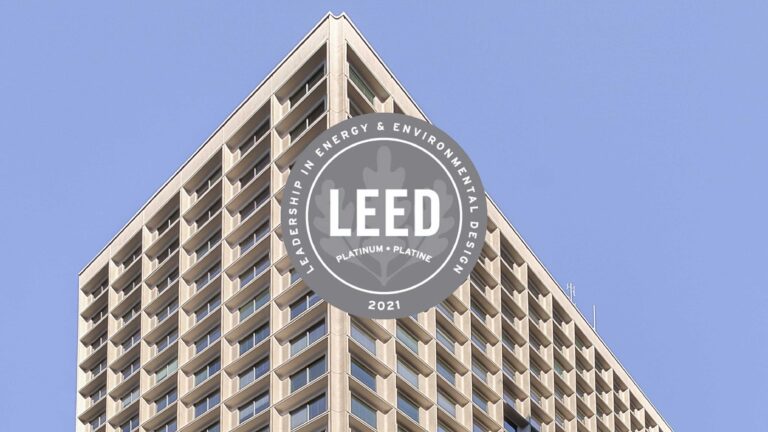 Office
Office
275 Slater, Ottawa
A revitalized office building in Ottawa’s central business district.
 Office
Office
Airport Square, Vancouver
A South Vancouver office tower with strong environmental credentials
 Retail
Retail
Guildford Town Centre
One of Canada’s most productive shopping centers in a rapidly growing area
 Residential
Residential
Rideau & Chapel, Ottawa
A new-build residential and retail development in the heart of Canada’s capital
 Industrial
Industrial
Toronto Industrial Portfolio
Strategically located warehouse facilities serving the Greater Toronto Area
Important information
The assets presented are meant for illustrative purposes only, are subject to change without notice and are not meant as a projection or estimate of the nature of any future investments to be made by the Fund or returns on any such investments. This information has been prepared by LaSalle in order to illustrate the type of assets held and/or transactions completed by the Fund; transactions for properties exhibiting the same or similar characteristics may not be available or profitable in the future.
Important information about sustainability
A decision to invest should consider all characteristics or objectives disclosed in the offering document. Please refer to the offering document before making any final investment decision.
Except where specified either in this webpage or any other documents, any ESG or impact goals, targets, commitments, incentives, initiatives or outcomes referenced in any information, reporting or disclosures published by LaSalle are not being marketed to investors or promoted and do not bind any investment decisions made in respect of, or the management or stewardship of, any funds managed by LaSalle for the purposes of Regulation (EU) 2019/2088 on sustainability-related disclosures in the financial services sector. Any measures in respect of such ESG or impact goals, targets, commitments, incentives, initiatives or outcomes may be overridden, may not be implemented or may not be immediately applicable to the investments of any funds managed by LaSalle (in each case, at LaSalle’s sole discretion).
Information about Maison Manuvie’s ratings and certifications
Evan Bogoslavsky is an analyst at LaSalle Debt Investors and is responsible for assisting in loan origination, financial reporting, and asset management of debt investments across all real estate property sectors.
Prior to joining LaSalle, Evan interned with Goldman Sachs, where he assisted the Real Estate Acquisitions group with debt and equity investments across all asset classes throughout the United States. He also held an internship with International Capital, a Dallas-based LP investor in Sun Belt multifamily developments and value-add assets.
Evan graduated from Southern Methodist University in 2023. He received a Bachelor of Business Administration in Finance with Honors and a Specialization in Alternative Asset Management from SMU’s Cox School of Business.
CHICAGO, June 29, 2023 — LaSalle Investment Management (“LaSalle”) has completed a joint venture with UDR, Inc. (NYSE: UDR) to create a portfolio of core multifamily assets in key markets across the US. Under the terms of the agreement, UDR will contribute a seed portfolio of four assets into the joint venture and retain a 51 percent ownership position in the aggregate portfolio, while also acting as asset manager.
The investment presents LaSalle a unique opportunity to partner with a best-in-class operator in a preferred sector with immediate and diversified scale in multifamily markets that are ranked highly by LaSalle’s global Research and Strategy group. The partnership capitalizes on the secular shift to product in high-barrier-to-entry markets in addition to attractive rent price points, strong operating history, and long-term expected NOI growth.
Mark Gabbay, Global CEO of LaSalle, said: “We are pleased to have sourced a high-quality investment for our limited partner, alongside a best-in-class sponsor and operator in UDR. The US multifamily market has remained one of the top-performing and most resilient asset classes in recent years, and we look forward to expanding this portfolio with UDR in the years ahead.”
About LaSalle Investment Management | Investing Today. For Tomorrow.
LaSalle Investment Management is one of the world’s leading real estate investment managers. On a global basis, LaSalle manages over $78 billion of assets in private and public real estate property and debt investments as of Q1 2023. LaSalle’s diverse client base includes public and private pension funds, insurance companies, governments, corporations, endowments and private individuals from across the globe. LaSalle sponsors a complete range of investment vehicles including separate accounts, open- and closed-end funds, public securities and entity-level investments. For more information please visit www.lasalle.com and LinkedIn.
About UDR, Inc.
UDR, Inc. (NYSE: UDR), an S&P 500 company, is a leading multifamily real estate investment trust with a demonstrated performance history of delivering superior and dependable returns by successfully managing, buying, selling, developing and redeveloping attractive real estate communities in targeted U.S. markets. As of March 31, 2023, UDR owned or had an ownership position in 58,411 apartment homes including 415 homes under development. For over 51 years, UDR has delivered long-term value to shareholders, the best standard of service to residents and the highest quality experience for associates.
NOTE: This information discussed above is based on the market analysis and expectations of LaSalle and should not be relied upon by the reader as research or investment advice regarding LaSalle funds or any issuer or security in particular. The information presented herein is for illustrative and educational purposes and is not a recommendation, offer or solicitation to buy or sell any securities or to adopt any investment strategy in any jurisdiction where prohibited by law or where contrary to local law or regulation. Any such offer to invest, if made, will only be made to certain qualified investors by means of a private placement memorandum or applicable offering document and in accordance with applicable laws and regulations. Past performance is not indicative of future results, nor should any statements herein be construed as a prediction or guarantee of future results.



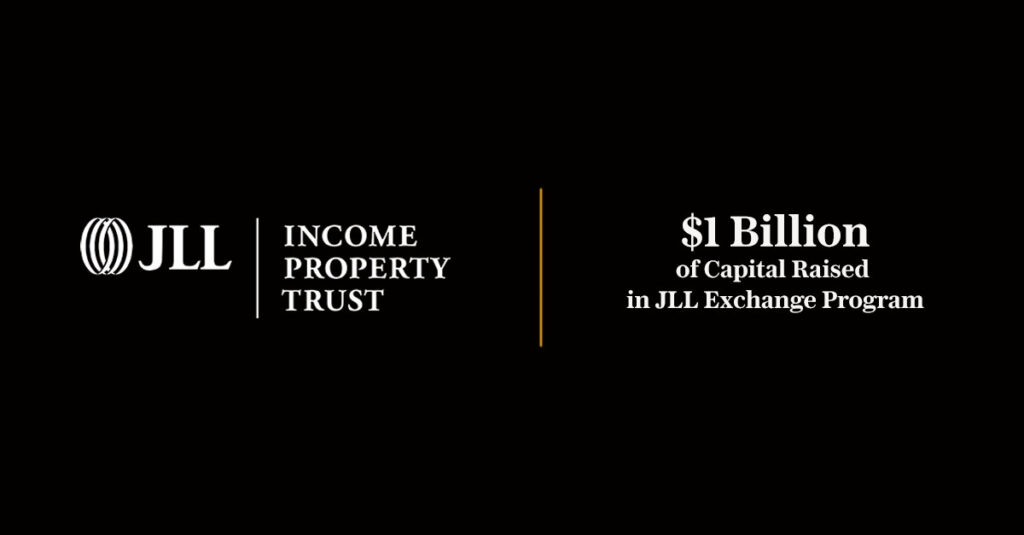
Chicago (June 6, 2023) – JLL Income Property Trust, an institutionally managed daily NAV REIT (NASDAQ: ZIPTAX; ZIPTMX; ZIPIAX; ZIPIMX) with more than $7 billion in portfolio assets, today announced it has attracted more than $1 billion through JLL Exchange (“JLLX”), its 1031 like kind real estate exchange program..
The JLLX platform is a sophisticated tax deferral and estate planning tool that utilizes both a traditional 1031 exchange along with a potential 721 UPREIT exchange. The JLLX program provides institutional quality properties through its unique Delaware Statutory Trust (“DST”) structure, where owners of appreciated investment real estate can conduct a 1031 exchange by reinvesting proceeds from the sale of their real estate to acquire interests in the DST. After a required holding period, DST properties may be reacquired in exchange for interests in JLL Income Property Trust’s UPREIT structure through a 721 exchange.
JLL Exchange provides investors the opportunity to reinvest proceeds from their sale of real estate held for investment into a broadly diversified, institutionally managed, perpetual NAV REIT, while also deferring taxes, maintaining their allocation to real estate and enjoying a wide range of estate planning benefits. JLL Income Property Trust benefits by attracting strategically aligned long-term investors through the 1031 exchange market.
Since its inception in 2020, JLLX has provided investors with more than $1 billion of DST interests through 18 distinct 1031 exchange offerings ranging from single property DSTs to diversified, multi-property portfolios. JLL Income Property Trust has also completed 6 full-cycle 721 UPREIT transactions totaling nearly $470 million. In a full-cycle UPREIT, real estate is exchanged on a tax-deferred basis for partnership interests in JLL Income Property Trust, offering the potential for owners of the exchanged property to achieve meaningful diversification, current income and the opportunity to realize long-term appreciation.
“We are extremely pleased by the market’s strong, sustained response to the JLLX platform,” said Allan Swaringen, President and CEO of JLL Income Property Trust. “Financial advisors have recognized the compelling potential tax and estate planning benefits from the JLLX offerings, and view it as a way to provide more holistic financial planning for their high net worth property owner clients.”
“By offering higher-quality, institutional, DST solutions, competitive fees and institutional management, JLLX has established itself as a preferred 1031 exchange solution for high net worth and ultra-high net worth investors,” said Drew Dornbusch, Head of JLL Exchange.
For more information on JLL Income Property Trust, please visit our website at www.jllipt.com.
About JLL Exchange
The JLL Exchange program offers private placements through the sale of interests in Delaware Statutory Trusts (DSTs) holding real properties. For more information, visit www.jllexchange.com.
About JLL Income Property Trust, Inc. ((NASDAQ: ZIPTAX; ZIPTMX; ZIPIAX; ZIPIMX)
JLL Income Property Trust, Inc. is a daily NAV REIT that owns and manages a diversified portfolio of high quality, income-producing residential, industrial, grocery-anchored retail, healthcare and office properties located in the United States. JLL Income Property Trust expects to further diversify its real estate portfolio over time, including on a global basis. For more information, visit www.jllipt.com.
About LaSalle Investment Management
LaSalle Investment Management is one of the world’s leading real estate investment managers. On a global basis, LaSalle manages approximately $78 billion of assets in private and public real estate property and debt investments as of Q1 2023. LaSalle’s diverse client base includes public and private pension funds, insurance companies, governments, corporations, endowments and private individuals from across the globe. LaSalle sponsors a complete range of investment vehicles including separate accounts, open- and closed-end funds, public securities and entity-level investments. For more information, please visit https://www.lasalle.com.
Valuations, Forward Looking Statements and Future Results
This press release may contain forward-looking statements with respect to JLL Income Property Trust. Forward-looking statements are statements that are not descriptions of historical facts and include statements regarding management’s intentions, beliefs, expectations, research, market analysis, plans or predictions of the future. Because such statements include risks, uncertainties and contingencies, actual results may differ materially from those expressed or implied by such forward-looking statements. Past performance is not indicative of future results and there can be no assurance that future dividends will be paid.



Through history, residential rent controls have tended to appear at times of external shock and dislocation.1 COVID-19 and the subsequent inflationary spike have proven to be such a catalyst. Changes to rent regulations can potentially reshape the risk-reward profile of residential investments, impacting values over both short and long timescales. As we set out in a previous piece, A New Wave of Residential Rent Control, the introduction of rent control measures can also have unintended consequences that distort the market. While often sold as a solution to spiralling housing costs, in practice they can have the opposite effect to their intent, deterring the construction of new rental housing, thus leading to further increases in rents.
Our findings in that report still hold true, but an update is needed because the “great reflation” period has seen a groundswell of support for further rent regulations, especially in Europe. The pandemic opened the door to unprecedented government intervention, and there has been a heightened willingness among politicians to introduce forms of rent control. But there continues to be vast differences across countries, regions and cities, reflecting varying political appetites for intervention. What is the impact of these recently enacted measures and which markets have been most impacted?
Rent regulation starting positions vary widely
Regulations take many different guises including broad brush limits on initial rent levels (e.g., in France, Ireland), market-wide caps to annual rental increases (Germany, Sweden) or caps limited to buildings of a certain age or in certain areas deemed to be stretched (Denmark, Catalonia, New York City, California). Beyond rent-setting, lease length, security of tenancy and eviction protections are additional factors to consider. Crucially, regulation should be viewed on a spectrum rather than as a binary determination.
In “unregulated” rental markets, such as England, most of the US and select European countries (e.g., Finland, Poland and Czechia), rents can typically be freely set at the outset of a tenancy, with the landlord permitted to increase them at the end of the agreement (typically 12 months) by any amount. This allows landlords in these markets to mark rents to market levels quickly. Even in markets that are usually considered to be unregulated, other legal limitations should also be considered; for example, the UK parliament is currently considering a law which would end no-fault evictions in England and Wales.
Elsewhere in Europe, in parts of Canada, and in several US states like California, Oregon and New York, the most typical form of rent control is limiting annual rent escalations for existing tenants. The devil is in the detail of these specific regulations. California, Oregon and New York City’s regulations, for example, apply to a subset of older assets; in Toronto (and all of Ontario) they apply to all but the newest. In the case of Oregon, a limit of 7% increase plus CPI is not much of a limitation on investment economics,2 while in New York City, rent increases are set by a regulatory body and can have a significant impact.
Europe’s generally more constraining rent increase caps mean that in-place rents are normally significantly below open-market rents for new leases. Limiting annual rent increases for in-place tenants prevents rents from being marked to market, usually resulting in tenants being “stickier”, staying in their homes in the knowledge that the rents they are paying are below what they would pay under a new lease. This has the effect of higher occupancy levels and lower expenses on unit turnover and voids. Catch-up between in-place and market rents occurs gradually, even during periods of weakness in market rents.
As a result of these factors, heavily regulated markets tend to experience stable in-place cash flow growth, without the cyclicality of less restrictive markets. This is highlighted on the below chart, which shows that residential rental growth in the UK has been far more volatile than regulated European markets. Given steady, non-cyclical growth, regulated residential in Europe has been able to deliver a higher level of long-run growth than most of the commercial sectors. These attributes of stability and low-but-dependable growth can be appealing to core investors, especially in lower inflation environments.
Rental growth and volatility
[Average per annum since 2000* and standard deviation]
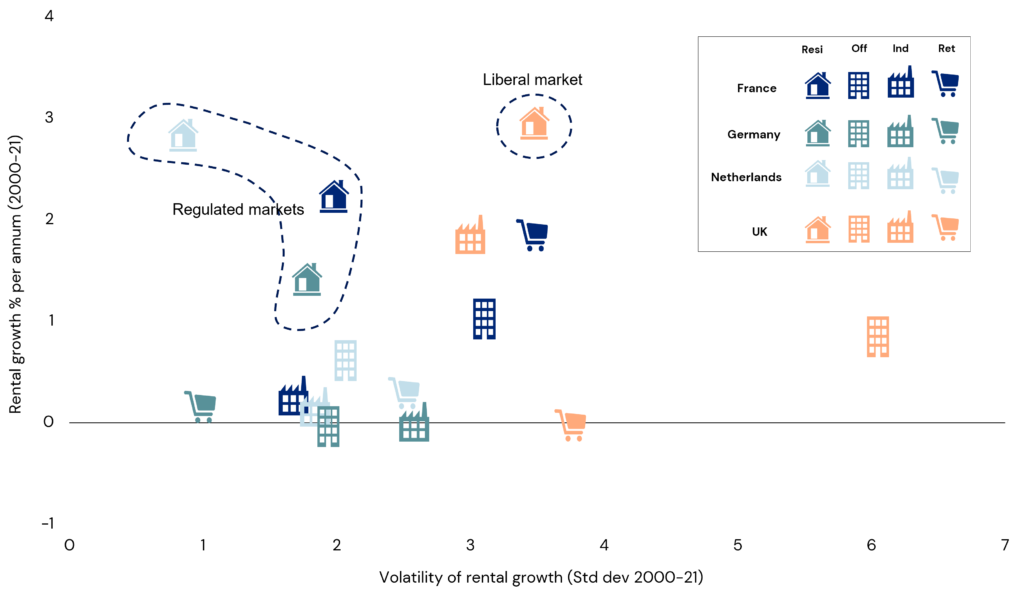
Source: LaSalle (May 2023), MSCI (December 2021)
Variety of cash flows can be a positive – but beware regulatory surprises
If regulations are known and stable, they can be priced in, limiting the risks to informed investors. A bigger concern comes from new, unforeseen regulations during the ownership of an asset. So-called “stroke-of-the-pen” risks may cause underwritten rent levels and growth to suddenly change. This remains a persistent threat as long as some policymakers are willing to support new rent controls. The factors which have made residential such a compelling sector in recent years, namely the undersupply of housing and tailwinds supporting demand, have exacerbated the threat, as rents in many major markets have increased as a share of average household income. The bout of high inflation seen in 2022-23 has put even more pressure on household finances and motivated politicians to act. The result has been new regulations brought in across Europe and North America, although some are some supposedly temporary.
Another wave of new regulation—Europe
Since beginning of 2022, several European markets have introduced new rental regulations, including in Scotland, France, Spain, Denmark and the Netherlands (see map). In other markets, such as Germany, new regulations are now being discussed.
The impact of these is just beginning to play out, but they are having meaningful effects already, with significant variation by market and asset profile. During this period of high inflation, these caps have created a double hit for some residential owners, limiting rental growth at the same time as operating expenses rose quickly.
Rental regulations introduced over 2022-2023
[Lighter colored markets considered unregulated]
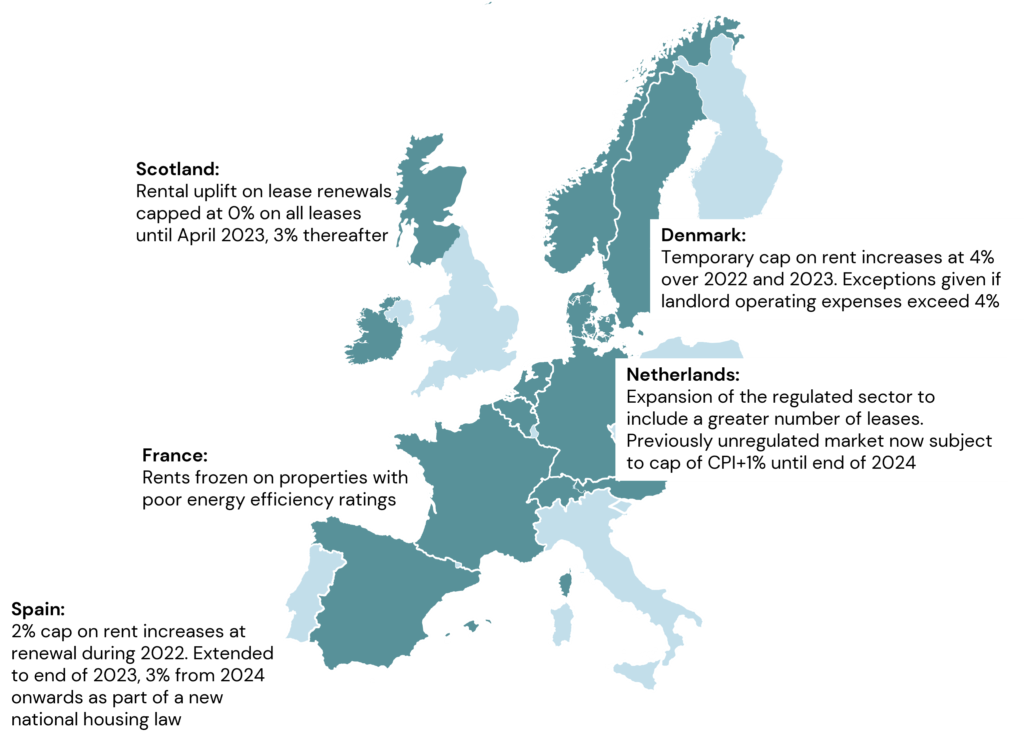
Source: LaSalle (May 2023)
In some markets, recent regulatory changes are less disruptive. For example, the cap to indexation at 4% in Denmark may result in below-inflation rental growth for one or two years. Should inflation revert to historic levels as anticipated, this is unlikely to meaningfully damage performance on assets held over the long term, but potentially mean negative real cashflow growth for landlords in the near term. This is because inflation exceeded the cap in 2022 and will expect it will likely do so again in 2023. Residential assets in regulated markets have only been able to deliver inflationary in-place rent growth when inflation is at “normal” levels. This is because regulators in Denmark and elsewhere have tended to prevent double-digit nominal increases even when justified by inflation.
The Scottish government’s decision to ban rent increases completely in September 2022 was potentially more disruptive. Some developers and investors indicated that construction of badly needed new for-rent supply was not viable in such an environment. Being unable to underwrite rental growth would likely discourage private investment in Scotland’s housing market, exacerbating the housing shortages which necessitated the rent controls in the first place. The Scottish government backtracked in April 2023, replacing the freeze with a still tight 3% cap.
Once regulations are introduced they are often very difficult to unwind, as few politicians will publicly campaign to reverse policies which will result in their voters paying more in rent. Evidence of this can already be seen in Spain, which introduced supposedly temporary caps to rent increases that have been extended beyond their original end dates and has further tightened regulations with the introduction of a wide-ranging national housing law.
Less constraining changes in the US
In parts of the US, rent control gained traction in the late 2010s, reversing a two-decade trend toward less regulation. But most cases, new measures have been relatively mild. In 2019, Oregon and California enacted statewide caps on annual rent increases for existing tenants, but limited the restrictions to older properties and set the level of the caps high.3 A notable example of a more severe new rent ordinance comes from St. Paul, Minnesota. Voters there approved an ordinance in 2021 that limited rental increases to 3% across all buildings and for renewals and new leases alike. Developers responded by halting construction projects in the city, with residential permits falling by 30%. Less than a year later, the St. Paul city council revised the ordinance to more closely resemble the legislation in California and Oregon.4
Despite the advances of rent control legislation in a small number of states and cities in recent years, many more jurisdictions have rejected it. In 2022 alone, new rent regulations were introduced by state legislators in 19 states and did not receive enough support to pass. Most recently, in April 2023, Florida passed an outright ban on rent control in that state while at the same time allocating new funding for the development of affordable housing.
Living with increased regulation
Despite the risks of regulatory change, regulated residential assets can potentially offer investors a favourable return given low risks, particularly when compared to the more challenged office sector. That said, the devil is in the details, given widely varying regulatory frameworks across cities, states and countries. With changes to policies underway, managing the risks of greater regulation is now more important than ever for investors. To do so, we recommend an approach that encompasses vigilance, diversification and identification of less-regulated proxies for residential—we detail each of these strategies below.
Brian Klinksiek’s article appears in Issue 12 of Summit, the official publication of AFIRE, the association for international real estate investors focused on commercial property in the United States.
Even as the US has exported trends that have transformed global property markets, several key trends originating in Europe are likely to shape property in the US and globally in the years ahead.
The opportunity to take ideas and best practices from one part of the world and implement them in another is, alongside diversification benefits, one of the great advantages of investing real estate capital across borders. Cyclical and secular themes tend to go global, albeit with leads and lags. Having a global perspective can give an investor an early-mover advantage over other players.
Historically, a common (but not exclusive) pattern has been for concepts to debut in US before emerging elsewhere. This was mirrored in my own career trajectory, which was shaped by the export of American business models. I moved from Chicago to London in 2009, and later to Hong Kong, to help my colleagues implement strategies in sectors that were established in the US but had been nascent elsewhere, such as multifamily apartments and self-storage. LaSalle has long tracked these differences in sector institutionalization and maturity on its “Going Mainstream” framework.
Patrick Pelling is Head of US Transactions at LaSalle, where he leads a team of 20+ investment professionals that are responsible for sourcing, underwriting and executing new investments as well as dispositions across the United States. Pat is also responsible for leading new investment initiatives and formulating and maintaining key relationships with investment partners.
Prior to his current role, Pat spent time in both LaSalle’s Transactions and Asset Management teams. Most recently, he was a Managing Director with the Transactions group responsible for sourcing and executing new investments in the Central US and East Coast on behalf of all LaSalle’s Custom Account clients and Funds. Before joining LaSalle in 2014, Patrick worked in JLL’s Work Dynamics group.
Patrick holds a bachelor’s degree in Economics from Northwestern, and an Master of Business Administration from Northwestern’s Kellogg School of Management.
Robert Turcott is a Managing Director of Acquisitions and is the national Industrial and Logistics team leader on the US Transactions team. In his role, he leads industrial investment initiatives for LaSalle’s advised funds and separate accounts, spanning various risk profiles from opportunistic to core. Robert is responsible for overseeing investment strategy, direct deal structuring and sourcing, evaluation of the existing portfolio, and expansion of LaSalle’s joint venture operating partnerships. With a successful 20-year track record in commercial real estate, Robert has executed hundreds of transactions over his career, representing over US $4 billion in value.
Prior to joining LaSalle, Robert was Vice President for KTR Capital Partners, a New York based value-add industrial fund manager, for four years. Prior to KTR, he was a Senior Development Manager for six years at McShane Development Company, a privately owned and diversified real estate company based in Chicago. Before McShane, he held multiple analyst roles with Equity Office Properties Trust, a publicly traded office REIT, also located in Chicago.
Robert holds a Master of Business Administration in Finance and Real Estate Investment with honors from Kellstadt Graduate School of Business in Chicago and a Bachelor of Business Administration in Business Management and Marketing from the University of Wisconsin-Madison. Robert is a member of NAIOP Chicago Chapter and is AP LEED Certified.

Chicago (April 25, 2023) – JLL Income Property Trust, an institutionally managed daily NAV REIT (NASDAQ: ZIPTAX; ZIPTMX; ZIPIAX; ZIPIMX) with approximately $7 billion in portfolio assets, announced today the acquisition of Louisville Logistics Center, a one-million-square-foot, newly constructed Class A industrial property strategically located in the top-tier industrial submarket of South Louisville, Kentucky. The purchase price was approximately $82 million.
Louisville Logistics Center is leased through 2032 to a nationally recognized, global transportation and logistics company with more than $100 billion in annual revenues and with an S&P “A” credit rating. The lease contains 2% annual rent escalations, along with two 10-year renewal options.
Constructed in 2022, the Louisville Logistics Center is a state-of-the-art, cross dock distribution center featuring 40-foot clear heights. The tenant has invested significant capital into equipment and technology specifically customized for their operations in the property. Louisville is also home to major air and ground distribution hubs for UPS. UPS’s investment and success in the market has made Louisville one of the more desirable and proven logistics locations in the central United States.
“Louisville’s central geographic location, irreplaceable transportation infrastructure, and strong interstate highway access make it a desirable and strategic location for both regional and national logistics,” said Allan Swaringen, President and CEO of JLL Income Property Trust. “The property’s new construction, significant improvements by the tenant, and a 10-year lease to an investment-grade Fortune 100 company, make this an attractive addition to our carefully constructed warehouse portfolio. Further, pricing on this quality of property is nearly 150 basis points improved over market pricing eighteen months ago. For investors like us with access to capital, these market conditions should present some exceptional investing opportunities.”
Louisville’s central location at the confluence of major highways allows distribution to over half the US population within a day’s drive via interstate highways I-24, I-64, I-65, I-71 and I-75, reinforcing JLL Income Property Trust’s research-led industrial strategy focused on acquiring properties with primary access to critical hubs of distribution and transportation infrastructure. The property is also within 20 miles of major distribution hubs including UPS Worldport (Air Distribution Hub), UPS Centennial Hub (Ground Distribution Hub), and the Louisville International Airport.
This investment brings JLL Income Property Trust’s aggregate industrial allocation to nearly $2.2 billion, or 32 percent of the portfolio, across 59 properties in 13 targeted warehouse markets.
For more information on JLL Income Property Trust, please visit our website at www.jllipt.com.
About JLL Income Property Trust, Inc. (NASDAQ: ZIPTAX; ZIPTMX; ZIPIAX; ZIPIMX)
JLL Income Property Trust, Inc. is a daily NAV REIT that owns and manages a diversified portfolio of high quality, income-producing residential, industrial, grocery-anchored retail, healthcare and office properties located in the United States. JLL Income Property Trust expects to further diversify its real estate portfolio over time, including on a global basis. For more information, visit www.jllipt.com.
About LaSalle Investment Management
LaSalle Investment Management is one of the world’s leading real estate investment managers. On a global basis, LaSalle manages approximately $79 billion of assets in private and public real estate property and debt investments as of Q4 2022. LaSalle’s diverse client base includes public and private pension funds, insurance companies, governments, corporations, endowments and private individuals from across the globe. LaSalle sponsors a complete range of investment vehicles including separate accounts, open- and closed-end funds, public securities and entity-level investments. For more information, please visit www.lasalle.com.
Valuations, Forward Looking Statements and Future Results
This press release may contain forward-looking statements with respect to JLL Income Property Trust. Forward-looking statements are statements that are not descriptions of historical facts and include statements regarding management’s intentions, beliefs, expectations, research, market analysis, plans or predictions of the future. Because such statements include risks, uncertainties and contingencies, actual results may differ materially from those expressed or implied by such forward-looking statements. Past performance is not indicative of future results and there can be no assurance that future dividends will be paid.



Chicago (April 19, 2023) – LaSalle Investment Management (“LaSalle”) announced it has earned BREEAM certifications for 26 of its US properties. Seventeen industrial and 9 retail properties totaling more than 10 million square feet earned certifications, further highlighting LaSalle’s commitment to achieving sustainability goals across its portfolio.
BREEAM is a leading global sustainability assessment platform developed by BRE, a 100-year-old building science center developing science-led solutions to built environment challenges. BREEAM stands out among sustainability assessments given its uniquely holistic approach to evaluation — which goes beyond environmental factors, considering sustainable attributes such as resilience and health and well-being.
Elena Alschuler, LaSalle Head of Americas Sustainability, said: “To meet our net zero carbon goals, and ensure we’re on track to construct a portfolio that will stand the test of time and continue to be attractive to buyers and tenants, implementing sustainability best practices across a variety of assets will continue to be critical. We’re very proud to have achieved BREEAM certifications on 26 properties, and look forward to growing that number in the future.”
Added Breana Wheeler, US Director of Operations at BRE: “As the threat of climate risks poses an ever-increasing risk for the commercial real estate sector — and vice versa — we are thrilled to work with an industry leader like LaSalle to help set a standard for achieving meaningful sustainability goals. With over two dozen BREEAM-certified properties, LaSalle continues to demonstrate a strategic, portfolio-wide approach to meet the rising industry demand for improved ESG performance that aligns perfectly with BREEAM’s science-driven methodology, and we look forward to a continued partnership focused on thoughtful sustainable growth across the U.S. and beyond.”
The 26 BREEAM certifications add to LaSalle’s continued recognition by credible third-party sources, including the recent WELL Health-Safety certification of more than 190 properties in North America and Asia Pacific, and LEED certifications for several of its US and Canadian properties. To find out more about LaSalle’s sustainability efforts, read LaSalle’s recently published Sustainability in Focus.
About LaSalle Investment Management | Investing Today. For Tomorrow.
LaSalle Investment Management is one of the world’s leading real estate investment managers. On a global basis, LaSalle manages approximately $82 billion of assets in private and public real estate property and debt investments as of Q2 2022. LaSalle’s diverse client base includes public and private pension funds, insurance companies, governments, corporations, endowments and private individuals from across the globe. LaSalle sponsors a complete range of investment vehicles including separate accounts, open- and closed-end funds, public securities and entity-level investments. For more information, please visit lasalle.com,or LinkedIn.
Forward looking statement
The information discussed above is based on the market analysis and expectations of LaSalle and should not be relied upon by the reader as research or investment advice regarding LaSalle funds or any issuer or security in particular. The information presented herein is for illustrative and educational purposes and is not a recommendation, offer or solicitation to buy or sell any securities or to adopt any investment strategy in any jurisdiction where prohibited by law or where contrary to local law or regulation. Any such offer to invest, if made, will only be made to certain qualified investors by means of a private placement memorandum or applicable offering document and in accordance with applicable laws and regulations. Past performance is not indicative of future results, nor should any statements herein be construed as a prediction or guarantee of future results.



CHICAGO (April 10, 2023) – LaSalle Investment Management (“LaSalle”) is proud to announce that it has received the 2022 ENERGY STAR® Partner of the Year Award – Sustained Excellence from the U.S. Environmental Protection Agency and the U.S. Department of Energy for the fifth consecutive year.
Each year, the ENERGY STAR program honors a select group of businesses and organizations that have made outstanding contributions in the transition to a clean energy economy. ENERGY STAR award winners lead their industries in the production, sale, and adoption of energy-efficient products, homes, buildings, services, and strategies. These efforts are essential to fighting the climate crisis, protecting public health, and creating a clean energy future for everyone.
Elena Alschuler, LaSalle Americas Head of Sustainability, said: “Earning the ENERGY STAR Partner of the Year award for five consecutive years is a testament to LaSalle’s commitment, at every level, to sustainability throughout our portfolio. Through a standardized approach to data, including using ENERGY STAR Portfolio Manager to assess the efficiency of our properties on an ongoing basis, we have been able to achieve significant momentum and results in our sustainability and energy saving efforts.”
EPA Administrator Michael S. Regan said: “As we accelerate historic efforts to address climate change, public-private partnerships will be essential to realizing the scale of our ambition. I applaud this year’s ENERGY STAR award winners for working with EPA to deliver a clean energy future that saves American consumers and businesses money and creates jobs.”
To celebrate the 30th Anniversary of ENERGY STAR, EPA offered special one-time recognition to all organizations who certified five or more buildings in 2022. Through this effort LaSalle achieved ENERGY STAR Certification across 37 buildings earning recognition as a Certification National Premier Member.
These achievements add to LaSalle’s strong track record of ESG best practices and distinctions. Industry organizations continue to recognize LaSalle for ESG leadership and maintaining its distinction as an employer of choice. LaSalle has received the following U.S. and global awards in the past year:
About LaSalle Investment Management | Investing today. For tomorrow.
LaSalle Investment Management is one of the world’s leading real estate investment managers. On a global basis, LaSalle manages over $79 billion of assets in private and public real estate property and debt investments as of Q4 2022. LaSalle’s diverse client base includes public and private pension funds, insurance companies, governments, corporations, endowments and private individuals from across the globe. LaSalle sponsors a complete range of investment vehicles including separate accounts, open- and closed-end funds, public securities and entity-level investments. For more information, please visit https://www.lasalle.com, and LinkedIn.
About ENERGY STAR
ENERGY STAR® is the government-backed symbol for energy efficiency, providing simple, credible, and unbiased information that consumers and businesses rely on to make well-informed decisions. Thousands of industrial, commercial, utility, state, and local organizations rely on their partnership with the U.S. Environmental Protection Agency (EPA) to deliver cost-saving energy efficiency solutions. Since 1992, ENERGY STAR and its partners helped American families and businesses avoid more than $500 billion in energy costs and achieve more than 4 billion metric tons of greenhouse gas reductions. More background information about ENERGY STAR’s impacts can be found at www.energystar.gov/impacts.
Forward looking statement
The information discussed above is based on the market analysis and expectations of LaSalle and should not be relied upon by the reader as research or investment advice regarding LaSalle funds or any issuer or security in particular. The information presented herein is for illustrative and educational purposes and is not a recommendation, offer or solicitation to buy or sell any securities or to adopt any investment strategy in any jurisdiction where prohibited by law or where contrary to local law or regulation. Any such offer to invest, if made, will only be made to certain qualified investors by means of a private placement memorandum or applicable offering document and in accordance with applicable laws and regulations. Past performance is not indicative of future results, nor should any statements herein be construed as a prediction or guarantee of future results.



US private real estate returns went negative in Q4 2022 as the impact of higher interest rates continued to ripple through to market pricing and appraised values. This trend is expected to continue through the first half of 2023 with stability projected to return later in the year.
Returns in the fourth quarter showed negative appreciation and income returns in line with previous quarters, resulting in negative total returns for both the NPI and ODCE. The slowdown in returns was most significant for industrial, with retail delivering the highest returns of the major sectors (this is a notable shift from trends of the last 5+ years). Looking ahead, the dominant theme in sector performance is expected to be the under-performance of offices.
This note provides details on the fourth quarter performance of the NPI and ODCE indices, summarizes the outlook for future returns, and provides some information regarding insights from the first release of data related to the new NCREIF subtypes.
Highlights from the Q4 data releases include:
Yoshi Yamasaki is a Portfolio Associate at LaSalle and serves in the Global Portfolio Management team for a large global real estate investment mandate investing in joint ventures, co-investments and club deals.
Formerly, Yoshi was the Project Manager for the launch and capital raising of LaSalle Investor Opportunity VI (LAO VI), a Pan-Asia opportunistic real estate fund while he served in LaSalle’s Investor Relations team in Chicago. During his time in Investor Relations, LAO VI raised over US$1.4 billion globally from various public pension funds, sovereign wealth funds, and financial institutions. Prior to this role, Yoshi was involved in LaSalle’s Investor Relations team in Tokyo.
Yoshi’s career in Real Estate began in 2015 when he joined Mitsui Fudosan’s Acquisitions team in its Real Estate Services Department. In Mitsui Fudosan, Yoshi worked on various development projects, mainly Industrial, Retail, and Data Centers for Mitsui Fudosan’s balance sheet and its affiliated public REITs.
Yoshi is a CFA Charterholder and earned a Bachelor of Arts in Law from Keio University.
Shivani Varma is a Vice President for LaSalle Global Solutions and is focused on acquisitions and investment management for indirect real estate opportunities in North America. She has broad investment experience, including real estate acquisitions, dispositions and real estate valuations across various asset types and has successfully completed over US$3.0 billion in total transactions.
Shivani’s career in Real Estate began in 2006 with Unitech, one of India’s largest real estate developers. She also worked as a real estate acquisitions analyst between 2013 and 2017 at Thor Equities, looking mainly at retail and office mixed-use investments. Between 2017 to 2020, Shivani worked with Harbor Group International as a part of the transactions team looking at acquisitions, dispositions and valuations for the firm across multifamily and commercial assets. Prior to joining LaSalle in 2022, Shivani worked at Global Asset Capital as an acquisitions director, looking at real estate investments across all asset classes.
Shivani received an Master of Science in Real Estate Investments from New York University’s Schack institute of Real Estate and a Master of Business Administration from Amity Business School, India.
Andy Buchanan is a Managing Director of LaSalle Global Solutions. He is responsible for deal sourcing, underwriting, negotiation and execution as well as portfolio and asset management duties on behalf of a series of separate accounts focused on co-investments, joint ventures, and other indirect strategies. Andy oversees a team of investment professionals and sits on the LaSalle Global Solutions Americas Regional Investment Committee.
Andy began his career in Real Estate in 2010. Before joining LaSalle in 2014 he worked as a Financial Analyst at Equity Office Properties and had experience in boutique multifamily brokerage. Prior to his current role in Global Solutions, he worked in the Americas Transaction group supporting underwriting, approval, due diligence, legal and closing processes.
Andy holds a Bachelor of Arts in Economics from the University of Illinois.
CHICAGO, SINGAPORE (Feb. 27, 2023) – LaSalle Investment Management (“LaSalle”) is pleased to announce it has earned the WELL Health-Safety Rating for 193 office and multifamily properties in North America and Asia Pacific through the International WELL Building Institute (“IWBI”), 43 properties more than last year. LaSalle increased its tally to 127 properties in the US and 66 properties and in Asia Pacific.
According to IWBI, this represents one of the largest and most diverse WELL Health-Safety rated portfolios globally. IWBI also confirmed that LaSalle received ratings on the most multifamily residential properties out of all entities that earned WELL-Health Safety certifications in 2022.
The WELL Health-Safety Rating is an evidence-based, third-party verified rating focusing on operational policies, maintenance protocols and emergency plans to promote overall occupant health and ensure emergency preparedness. To achieve the WELL Health-Safety Rating, the properties implemented or demonstrated features such as improved air and water quality management, health service resources, emergency preparedness programs, enhanced cleaning and sanitation procedures and stakeholder engagement and communication. The WELL Health-Safety Rating can instill confidence in those who come through the building as well as the broader community.
David DeVos, LaSalle Global Head of Sustainability, said: “Tenants are prioritizing healthy spaces where they feel safe, so it is critical to exemplify our commitment to safety to drive tenant demand and, ultimately, portfolio performance. Earning WELL Health-Safety Ratings across our portfolios in North America and Asia is a testament to our focus on tenant safety and ensuring we’re continuing to be at the forefront of the industry in providing the best spaces possible for tenants, no matter where they are.”
Added Jessica Cooper, Chief Product Officer, IWBI: “LaSalle is a demonstrated leader in real estate assets. Already engaged in WELL, LaSalle is showcasing continued leadership to scale the impact of health and well-being globally, achieving the WELL Health-Safety Rating across Asia and the Americas. IWBI congratulates LaSalle for continued achievement of the rating and investment in people-first places.”
The WELL Health-Safety Rating provides a centralized source and governing body to validate efforts made by owners and operators. It leverages insights drawn from the IWBI Task Force on COVID-19, in addition to guidance on the spread of COVID-19 and other respiratory infections developed by the World Health Organization, U.S. Centers for Disease Control and Prevention, global disease control and prevention centers and emergency management agencies, as well as recognized standard-making associations such as ASTM International and ASHRAE, and leading academic and research institutions, as well as core principles already established by IWBI’s WELL Building Standard, the premier framework for advancing health in buildings and spaces of all kinds.
LaSalle’s properties were awarded the WELL Health-Safety Rating following the successful completion of third-party documentation review by GBCI to confirm it has met the feature specific intents and requirements.
About LaSalle Investment Management | Investing Today. For Tomorrow
LaSalle Investment Management is one of the world’s leading real estate investment managers. On a global basis, LaSalle manages over $79 billion of assets in private and public real estate property and debt investments as of Q4 2022. LaSalle’s diverse client base includes public and private pension funds, insurance companies, governments, corporations, endowments and private individuals from across the globe. LaSalle sponsors a complete range of investment vehicles including separate accounts, open- and closed-end funds, public securities and entity-level investments. For more information please visit https://www.lasalle.com, and LinkedIn.



Joseph Diamond is the Portfolio Controller for LaSalle Value Partners US. His current responsibilities include preparing all aspects of financial reporting for the Fund Series.
Joe started his career with Ernst & Young in the business tax services sector.
Joe earned a Bachelor of Science and Master of Applied Science from the University of Illinois and is also a Certified Public Accountant.
Brian Gorz is the Chief Financial Officer of LaSalle Value Partners US, responsible for financial planning, analysis, cash management and reporting. Brian works closely with the investment, asset management and capital functions to support the Funds strategy and activity.
Brian earned a Bachelor of Arts from the University of Illinois and is also a Certified Public Accountant.
Brian Wilkinson is a Senior Vice President at LaSalle and serves as an Asset Manager for LaSalle Value Partners US. Brian has been a dedicated member of the LVP US team since 2021 and oversees a portfolio of commercial and residential investments located in markets throughout the United States. In his role, he provides strategic direction for all facets of asset performance which includes leasing, operations, financing and capital projects. Brian also leads disposition activities within his portfolio as well as supports acquisition activities.
Prior to his current responsibilities, Brian spent five years in LaSalle’s Asset Management group focusing on assets for open-ended funds and separate account clients. Before joining LaSalle, Brian was an Associate with NPV Advisors, a real estate valuation and advisory firm, where he specialized in the valuation of multi-family and office assets for lenders and institutional clients. He has been active in the real estate industry since 2013.
Brian holds a Bachelor of Arts degree from The University of Chicago.
Zachary Bublitz is a Senior Vice President of LaSalle Value Partners US responsible for portfolio management and fund operations. Since joining LaSalle in 2014, Zac has also held asset management, capital formation and transaction responsibilities.
Zac earned a Master of Business Administration from the Kellogg School of Management at Northwestern University and a Bachelor of Business Administration from the University of Notre Dame.
Michelle Gottlieb is a Senior Vice President and asset manager with a focus on the Western region of the United States. She has extensive experience across property sectors, responsible for over US$4 billion of portfolio properties over her tenure.
Michelle earned a Bachelor of Business Administration from the University of Wisconsin and a Master of Business Administration from the Kellogg School of Management at Northwestern University.
Amanda Hassan is a Senior Vice President responsible for the sourcing and evaluation of investment opportunities for LaSalle Value Partners US. Since joining LaSalle in 2014, she has completed over US $3.5 billion in property transactions across property sectors throughout the United States and has also held asset management, portfolio management and capital formation responsibilities. Prior to her current role, she worked in the Americas Transaction group supporting underwriting, approval, due diligence, legal and closing processes.
Amanda earned a Bachelor of Science in Finance from the University of Illinois and a Master of Business Administration with a concentration in Real Estate Finance and Investment from the Kellstadt Graduate School of Business at DePaul University.
Jeffrey Shuster is President of LaSalle Value Partners US and leads LaSalle’s high return strategies in the United States.
Prior to joining LaSalle, Jeff spent 12 years at Starwood Capital Group where he completed over US $6 billion of real estate private equity transactions. His roles included acquisitions sourcing, structuring and underwriting, managing joint venture partner relationships as well as positions in asset management on behalf of Starwood’s Opportunity Fund and Property Trust platforms. Prior to Starwood, Jeff began his career with Bear Stearns in the Commercial Mortgages group where he underwrote over $2 billion of CMBS debt.
Jeff earned a Bachelor of Science in Economics with a concentration in Real Estate and Finance from the Wharton School at the University of Pennsylvania.
Amy Barsich is Managing Director and CFO for the LaSalle Canada Property Fund and Canadian value-add funds. She is responsible for the development and oversight of all financial and reporting aspects of the Funds. Amy works closely with Portfolio Management on creation and implementation of Fund strategy. She began her real estate career with LaSalle in 2000 and has worked with the firm’s Canadian business since 2003.
Prior to joining LaSalle, Amy began her career in public accounting and worked for George S. Olive LLP.
Amy holds a Master of Business Administration (MBA) from Purdue University (2007) and a Bachelor of Science in Accounting from Butler University (1998). She is also a Certified Public Accountant.
Trevor Thompson-Harry is Deputy Fund Manager for LaSalle’s value-add strategies in Canada and is also responsible for debt strategy, sourcing, and execution across all LaSalle investments in Canada. He began his commercial real estate career in 2008 and has experience across capital markets, public equities, REITs, portfolio and asset management, lending, fund structuring, capital raising and investor relations/reporting.
Prior to LaSalle, Trevor was with Scotiabank’s Global Banking and Markets group in institutional sell-side equity research covering Canadian Real Estate and REITs. Prior to Scotiabank, Trevor held various roles in commercial real estate lending, including portfolio management, underwriting, origination, and servicing of conventional, insured, and CMBS financings.
Trevor holds a Master of Business Administration from the Kellogg School of Management at Northwestern University and Schulich School of Business at York University and a Bachelor of Business Administration (concentration in finance) from Simon Fraser University.
TORONTO (Feb. 14, 2023) – LaSalle Investment Management (“LaSalle”) is celebrating five years since the launch of its flagship core real estate fund in Canada, the LaSalle Canada Property Fund (“LCPF” or “the fund”). Since its launch in 2017, the fund’s investment objective has been to outperform the MSCI Canada Property Fund Index (“the index”) by 100 basis points on a gross, five-year rolling basis. It has achieved that goal over the past five years. Additionally, the fund has maintained top quartile performance against the index over 1-, 3- and 5-year periods on a gross basis as of December 31, 2022. LCPF has also grown its gross asset value by 4.5 times since inception to more than C$2.3 billion across 33 investments with interests in 53 properties.
John McKinlay, CEO of LaSalle Canada, said: “We’re proud to have reached the five-year threshold for LaSalle Canada Property Fund. While LaSalle has a rich history of operating in Canada since 2000, this is a critical milestone for LCPF, and a testament to the staying power of the fund and its goal of providing investors income through access to Canada’s highest quality core real estate in the country’s top markets. Canada is an outstanding destination for capital looking to take advantage of solid real estate fundamentals, including strong immigration, job growth, and tenant demand for core product across key sectors. Thank you to our investors for their continued commitment.”
Sam Barbieri, LaSalle Managing Director of Development and Fund Management, added: “Through patience and a dedicated strategy of acquiring and developing high quality assets across Canada’s six major metros, we’ve been able to construct a fundamentally strong portfolio for LCPF that continues to prove its resilience. On the sustainability front, we’re proud to have achieved two four-star and two five-star GRESB ratings, having improved the fund’s score each year. LCPF also ranks well in the index in terms of physical climate risk, having one of the lowest value at risk, in accordance with annual physical climate risk assessments conducted by the fund.”
LCPF’s portfolio totals nearly 9.5 million square feet across Vancouver, Calgary, Edmonton, Toronto, Ottawa and Montreal – the key markets in Canada’s investible real estate universe. The portfolio includes industrial, multifamily, office, retail and mixed-use properties, along with select development projects in these sectors. Among its marquee properties are:


Sustainability initiatives continue to be a key driver in the active asset management of the portfolio. More than 85% of the properties in the portfolio have received a sustainability certification, including 7 that hold LEED certifications, 6 BOMA Best certifications and 9 WELL Health-Safety certifications. LCPF has also submitted to the Global Real Estate Sustainability Benchmark (GRESB) for all five years, earning back-to-back 5-star ratings in 2020 and 2021.
Amy Barsich, LaSalle Managing Director and LCPF CFO, said: “While the market has evolved since LCPF launched five years ago, LCPF’s thesis and principles continue to hold up and produce income for our investors. We look forward to continuing to serve our investors for years to come.”
About LaSalle in Canada
On an aggregate basis, LaSalle has executed more than C$8 billion in Canadian real estate since 2000, providing it with an in-depth understanding of the market. The formation of LCPF expanded LaSalle’s existing Canadian real estate product suite and investment vehicles, which include a series of closed-end commingled funds as well as separate accounts.
About LaSalle Canada Property Fund (LCPF)
LCPF is an open-ended fund targeting core properties in major markets across Canada. The fund is targeting commitments from Canadian and global institutional investors seeking access to the Canadian real estate market through a diversified, income-oriented vehicle. Launched in 2017, the fund aims to provide investors with immediate exposure to a diverse and mature portfolio comprised of office, industrial, mixed-use, retail and multifamily assets. Through its near-term pipeline of potential future investments, the fund will seek to take advantage of mispriced assets as it continues to grow.
About LaSalle Investment Management | Investing Today. For Tomorrow
LaSalle Investment Management is one of the world’s leading real estate investment managers. On a global basis, LaSalle manages approximately $79 billion of assets in private and public real estate property and debt investments as of Q4 2022. LaSalle’s diverse client base includes public and private pension funds, insurance companies, governments, corporations, endowments and private individuals from across the globe. LaSalle sponsors a complete range of investment vehicles including separate accounts, open- and closed-end funds, public securities and entity-level investments. For more information, please visit us on LinkedIn.
Forward looking statement
The information discussed above is based on the market analysis and expectations of LaSalle and should not be relied upon by the reader as research or investment advice regarding LaSalle funds or any issuer or security in particular. The information presented herein is for illustrative and educational purposes and is not a recommendation, offer or solicitation to buy or sell any securities or to adopt any investment strategy in any jurisdiction where prohibited by law or where contrary to local law or regulation. Any such offer to invest, if made, will only be made to certain qualified investors by means of a private placement memorandum or applicable offering document and in accordance with applicable laws and regulations. Past performance is not indicative of future results, nor should any statements herein be construed as a prediction or guarantee of future results.



JLL has scored a perfect 100 on the Disability Equality Index. As a wholly owned subsidiary of JLL and is proud to share in this achievement.
The index is a benchmarking tool that helps companies build a roadmap of measurable, tangible actions that they can take to achieve disability inclusion and equality. Each company receives a score, on a scale of zero (0) to 100, with those earning 80 and above recognized as “Best Places to Work for Disability Inclusion.”
Read more about this award on the Disability:IN website



Kristen Christiansen joined the global Investor Services team in 2022 as a Specialist to provide support and service to all internal and external LaSalle parties regarding onboarding, Investor Portal and Business Application Support.
Initially, Kristen joined LaSalle in 2008 as an Accounting Assistant with the Investor Accounting and Finance Department where she supported the Separate Accounts group in their day-to-day functions. Previous to her introduction to the Real Estate industry Kristen gained valuable experience multi-tasking and supporting a wide variety of functions in the not-for-profit industry.
Kristen holds a Bachelors Degree from Western Illinois University in Music Business and Marketing.
Tricia Horvath is an Associate Vice President of Investor Services at LaSalle. With her primary focus being investor onboarding and establishing a client’s online portal, Tricia also works globally as a liaison between the legal, compliance, and tax departments to ensure all regulatory requirements are met. With an acute attention to detail and accurate record-keeping, she also plays a vital role in maintaining LaSalle’s legal book of record and document repository.
Joining LaSalle in 2006 as a member of Cash Management, Tricia performed international wire transfers and developed an audit process for managing online banking access. In 2017, she transitioned to a newly created position with Investor Services. Since then, Tricia has expanded her knowledge of regulatory requirements and has facilitated the expansion of an electronic onboarding system, revolutionizing the investor onboarding process for LaSalle.
Tricia’s passion for compliance and rigid processes began during her time at Marsh McLennan as Executive Assistant to the Chief Compliance Officer where she gained a diverse background in regulatory requirements and customized client support.
At LaSalle, our mission is to deliver investment performance for a better tomorrow for all our stakeholders, and sustainability and strong climate action are an integral part of delivering both performance and a better tomorrow.
We are addressing the physical and transitional risks associated with the impacts of climate change and the move to a decarbonized world, with action across all areas of our business. We firmly believe that this climate-focused approach can drive investment performance.
Our 2022 sustainability review covers our environmental sustainability strategy and approach as well as how our actions can add value for investors and other stakeholders. It highlights our 2022 results and details how we are tackling resource conservation, reducing carbon emissions and evaluating climate risk across all areas of our business. We conclude with a selection of case studies from around the world highlighting our efforts in carbon conservation, resource capture, supporting biodiversity and supporting a more circular economy.
Far from simply mitigating climate risk, our commitment to sustainability runs through every facet of our business, to ensure that we add value at every stage of an asset’s lifecycle and across the investment process.
Jen Wichmann is a Senior Vice President on the Research and Strategy team. She leads the team’s US residential and self-storage property type coverage. Jen also works closely with the Transactions team and separate account clients, creating and implementing real estate strategies.
Prior to joining LaSalle in 2022, Jen worked at Heitman providing market analysis for existing and new investments in a variety of property sectors with particular focus on retail and multifamily in the US. She also previously worked in affordable housing research and finance and served in the US Peace Corps in Nicaragua.
Jen holds a Masters of Urban Planning and Policy from the University of Illinois at Chicago and a Bachelor of Arts in Geography and Psychology from Macalester College. She is a member of the NMHC Research Committee, Urban Land Institute, and a ULI Chicago Product Council.
Heidi Hannah is a Senior Strategist in LaSalle’s North America Research and Strategy team. She leads the team’s Office, Life Science and Niche property type coverage. Heidi also works closely with the US acquisition team and separate account clients, creating and implementing real estate strategies.
Before joining LaSalle in 2019, Heidi worked at Clarion Partners as the head of bottom-up research
overseeing acquisition and asset management’s investment strategies. Heidi has also worked as a real estate researcher at CBRE and as an urban economic planner at the consulting firm Urbanomics. In addition, she served in the US Peace Corps in Bulgaria from 2000-2002 and in Fiji from 2010-2011.
Heidi is a certified urban planner with the American Planning Association and holds a Master of Science in Urban Planning from Columbia University in New York and a Bachelor of Arts from The American University in Washington, DC.
US private real estate returns weakened considerably in 3Q 2022 as higher interest rates continued to have a major impact on market pricing and appraised values. This trend is expected to continue in the remainder of 2022 and into the opening quarters of 2023. This is leading to a dramatic slowdown in returns from the record levels seen less than a year ago.
Returns in the third quarter showed negative appreciation, with total returns remaining positive for both the NPI and ODCE. The slowdown in returns was most significant for industrial, with apartments delivering the highest returns. Looking ahead, the dominant theme in sector performance is expected to be the under-performance of offices.
This note provides details on the third quarter performance of the NPI and ODCE indices, summarizes the outlook for future returns, and provides some information regarding insights from the first release of data related to the new NCREIF subtypes.
Highlights from the 3Q data releases include:
Sam Barbieri is Managing Director, Portfolio Management and Development at LaSalle. He is also Deputy Fund Manager of the LaSalle Canada Property Fund. As a senior member of the LaSalle Canada team, he takes part in managing investments for a broad institutional client base. Additionally, he is responsible for overseeing the firm’s property development initiatives in Canada and in recent years has completed development projects in the multi-family, industrial, office and retail sectors, in various markets across the country.
Prior to joining LaSalle, Sam served in progressively responsible roles with both Oxford Properties Group and Bentall Real Estate Services, managing large mixed-use portfolios in Toronto’s downtown core. He began his real estate career in 1994, where in his early roles he acted in a fiduciary capacity, managing private sector assets on behalf of third-party owners.
Sam has a Bachelor of Arts in Economics from the University of Toronto and a Diploma in Urban Land Economics (DULE) from the University of British Columbia and is graduate of Harvard University’s Advanced Management Development Program in Real Estate. He is a past president of the NAIOP’s Greater Toronto Area Chapter, (2019), and was chair of the NAIOP’s Sustainability Committee from 2013 – 2016. He is currently a board member of Realpac’s ESG and Fund committees.
LaSalle Investment Management (LaSalle) is pleased to announce it has been named a Best Place to Work in Money Management for 2022 by Pensions & Investments (P&I). This marks the seventh consecutive year LaSalle has received this prestigious recognition.
Presented by Pensions & Investments, the global news source of money management, the 11th annual survey and recognition program is dedicated to identifying and recognizing the best employers in the money management industry.
Kristy Heuberger, LaSalle Americas Co-Head, said: “We are proud to once again be recognized as one of the best places to work in our industry. We pride ourselves on creating a Culture of Care, which incorporates a holistic approach to promoting employee wellbeing, community connection and diversity, equity and inclusion. This honor is a reflection of the contributions of each employee at LaSalle and their critical role in sustaining our culture.”
Brad Gries, LaSalle Americas Co-Head, added: “Receiving this recognition seven years in a row speaks to a core tenant of our business: our people are our greatest asset. LaSalle is a tremendous place to grow together and not only provide superior client service, but foster a culture of inclusion and growth opportunities for our people. Thank you to all of our employees for making LaSalle a Best Place to Work in Money Management.”
P&I Executive Editor Julie Tatge said: “As their employees attest, the companies named to this year’s Best Places to Work list demonstrate a commitment to building and maintaining a strong workplace culture. Even as firms grappled with volatile markets and stresses from the pandemic, their employees said they feel strong support from their managers, enabling them to do their best work.”
Pensions & Investments partnered with Best Companies Group, a research firm specializing in identifying great places to work, to conduct a two-part survey process of employers and their employees. The first part consisted of evaluating each nominated company’s workplace policies, practices, philosophy, systems and demographics. This part of the process was worth approximately 25% of the total evaluation. The second part consisted of an employee survey to measure the employee experience. This part of the process was worth approximately 75% of the total evaluation. The combined scores determined the top companies.
For a complete list of the 2022 Pensions & Investments Best Places to Work in Money Management winners and write-ups, go to www.pionline.com/BPTW2022.
About Pensions & Investments
Pensions & Investments, owned by Crain Communications Inc., is the 50-year-old global news source of money management. P&I is written for executives at defined benefit and defined contribution retirement plans, endowments, foundations, and sovereign wealth funds, as well as those at investment management and other investment-related firms. Pensions & Investments provides timely and incisive coverage of events affecting the money management and retirement businesses. Visit us at www.pionline.com.
About LaSalle Investment Management | Investing Today. For Tomorrow.
LaSalle Investment Management is one of the world’s leading real estate investment managers. On a global basis, LaSalle manages approximately $79 billion of assets in private and public real estate property and debt investments as of Q3 2022. LaSalle’s diverse client base includes public and private pension funds, insurance companies, governments, corporations, endowments and private individuals from across the globe. LaSalle sponsors a complete range of investment vehicles including separate accounts, open- and closed-end funds, public securities and entity-level investments. For more information please visit http://www.lasalle.com, and LinkedIn.
Forward looking statement
The information discussed above is based on the market analysis and expectations of LaSalle and should not be relied upon by the reader as research or investment advice regarding LaSalle funds or any issuer or security in particular. The information presented herein is for illustrative and educational purposes and is not a recommendation, offer or solicitation to buy or sell any securities or to adopt any investment strategy in any jurisdiction where prohibited by law or where contrary to local law or regulation. Any such offer to invest, if made, will only be made to certain qualified investors by means of a private placement memorandum or applicable offering document and in accordance with applicable laws and regulations. Past performance is not indicative of future results, nor should any statements herein be construed as a prediction or guarantee of future results.


